Paul van Yperen's Blog, page 112
September 12, 2022
Juve versus Fantômas (1913) and La Mort qui tue (1913)
Juve versus Fantômas/Juve contre Fantômas (Louis Feuillade, 1913) and Fantomas, La Mort qui tue/The Dead Man Who Killed (Louis Feuillade, 1913) were the second and third of the five episodes of the mastermind criminal serial Fantômas (1913-1914), produced by Gaumont and based on the eponymous stories by Pierre Souvestre and Marcel Allain. Fantômas, the master of crime, terrorises Paris. Inspector Juve (Edmund Breaon) and journalist Jérôme Fandor (Georges Melchior) take up the fight against him. Like, last week, when we did a post on the first episode EFSP presents two series of six vintage Spanish minicards by Reclam Films in Mallorca.
Juve versus Fantômas (1913)
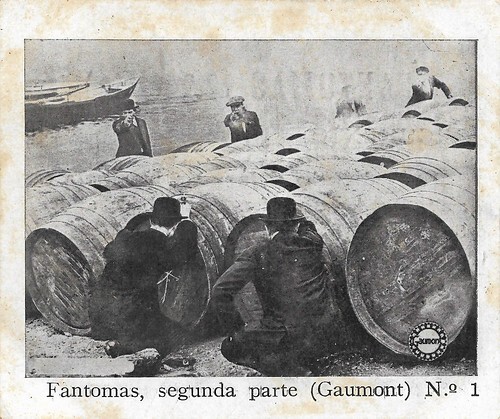
Spanish minicard by Reclam Films, Mallorca, card no. 1. Photo: Gaumont. Fandor (Georges Melchior) and Inspector Juve (Edmund Breaon) in a scene from the serial Fantomas, second series, Juve versus Fantômas/ Juve contre Fantômas (Louis Feuillade, 1913). The shootout with the barrels of alcohol takes an ugly turn when the villains set the barrels on fire. Seen on their backs: Fandor and Juve.
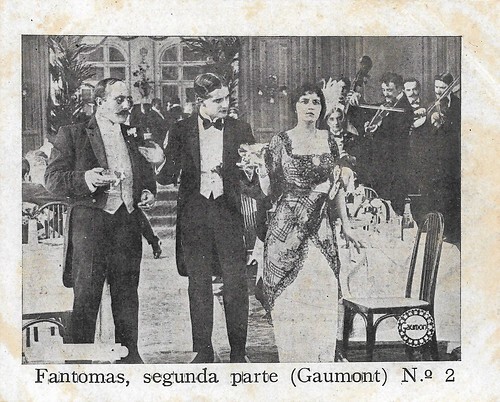
Spanish minicard by Reclam Films, Mallorca, card no. 2. Photo: Gaumont. Edmund Breon as Inspector Juve, Georges Melchior as the reporter Fandor and Yvette Andreyor as Joséphine 'la pierreuse' (the hustler) in a scene from the serial Fantomas, second series, Juve versus Fantômas/ Juve contre Fantômas (Louis Feuillade, 1913). Juve and Fandor meet Joséphine at the fancy ball.
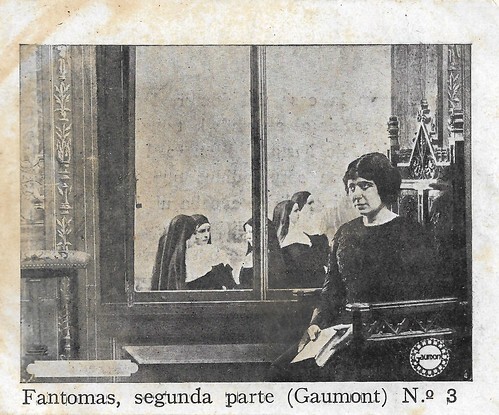
Spanish minicard by Reclam Films, Mallorca, card no. 3. Photo: Gaumont. Renée Carl as Lady Beltham in a scene from the serial Fantomas, second series, Juve versus Fantômas/Juve contre Fantômas (Louis Feuillade, 1913). Lady Beltham receives a letter from her old lover Gurn aka Fantomas.
Juve versus Fantômas/Juve contre Fantômas (Louis Feuillade, 1913) opens with shots of the leading actors and their disguises: René Navarre as himself (the actor), Dr. Chaleck (bearded), the gang-leader Loupart (moustache, bowler hat, and cigarette), and the "Man in Black" (the "true visage" of Fantômas...); Edmond Bréon as himself (the actor), Inspector Juve (moustache and bowler hat) and disguised as a businessman (mutton-chop sideburns and dress hat).
The Simplon Express Disaster: In his office, Inspector Juve ponders and signs a report to the Commissioner of Police. Welcoming the journalist Jérôme Fandor, Juve hands him the report, which refers to the discovery of a woman's body, crushed beyond recognition, in the house of Dr. Chaleck. Papers on the body identify it as Lady Beltham, but Juve is skeptical. (In the first Fantômas adventure, the Englishwoman assisted her criminal lover, Gurn (alias Fantômas), in both the murder of her husband, Lord Beltham, and the substitution of the actor Valgrand for the imprisoned Gurn on the eve of the criminal's execution. Juve engages Fandor to help him in the case. Outside on the street, Dr. Chaleck (alias Fantômas) gets into a taxi, shadowed by Juve and Fandor who follow in another cab. But it is the bandit Loupart (another alias of Fantômas) who reemerges from the taxi. Loupart approaches Joséphine-la-Pierreuse, a street prostitute and the bandit's mistress, who passes him a note. Juve and Fandor split up, each pursuing one of the two suspicious characters.
Fantomas & Josephine: Loupart reads the note, which explains that Joséphine will be meeting a courier from a wine merchant at the Gare de Lyon. The courier, holding 150,000 francs, believes that they'll be going on a tryst—of course, he'll be robbed instead. Loupart gets into a cab, but when Juve tries to follow in a second cab, a member of Loupart's gang jumps on the back of the taxi and punctures the rear tire. Juve loses the trail. But Fandor shadows Joséphine more successfully through the Métro [with location shots inside a moving Métro train!] and to her apartment. From a café, Fandor sends off a quick note to Juve. At the Gare de Lyon, Joséphine meets Martialle, the courier. They enter a train compartment, and Fandor follows, taking the neighbouring compartment. Two of Loupart's accomplices stroll the corridor...The train pulls out. Loupart appears in the corridor, encountering Fandor, whom the criminal recognizes.
To make their robbery easier, one of Loupart's men detaches the coach from the rest of the train. Donning black masks, Loupart and his gang rob Martialle at gunpoint (a couple members of his gang rob Fandor at the same time, for good measure and to keep the journalist out of the picture). After the criminals depart, Fandor and Martialle realize that the coach is coasting back down the mountainside and they leap out. In horror, they watch as the next train along the line, the Simplon express, crashes into the loose car. Meanwhile, Loupart and company escape to a waiting car. Joséphine discovers a letter from Martialle's employers among the robbed possessions, explaining that the 150 thousand-franc notes carried by the courier have each been cut in half, with the other halves to be delivered later. Their theft is foiled! But Loupart has a plan. En route by car, he stops at a post office and sends Juve a false telegram from "Fandor" setting a meeting for the wharves near the wine warehouse at 11 pm that night.
At the Bercy Warehouse: Juve receives the telegram, but he is also contacted by the real Fandor, whom Loupart/Fantômas believes has died in the Simplon express crash. Therefore, Juve and Fandor appear in the scene together, prepared for some sort of mischief from Fantômas, but uncertain what form their challenge will take. Juve and Fandor surreptitiously crawl among barrels of spirits stacked along the banks of the Seine near the Bercy warehouse. But, it's an ambush! Loupart/ Fantômas's men, hidden among the barrels, open fire upon the detective and journalist. Then, the bandit's gang set fire to the barrels of liquor, trapping Juve and Fandor. To escape the flames and smoke, the two heroes climb into an empty barrel, roll down into the water, and swim away to safety across the river.
At the Crocodile: Joséphine dines at the elegant Montmartre restaurant "The Crocodile" with a young man who liberally imbibes champagne (and subsequently falls asleep at the table). By a stroke of fortune, Juve and Fandor not only dine at the same restaurant but are seated at the adjoining table. Recognizing Joséphine, Fandor and Juve confront her and demand to know the whereabouts of Loupart/ Chaleck/ Fantômas. Finding herself compromised, the prostitute reveals another coincidence—Dr. Chaleck is dining in the next room! Overjoyed at his luck, Juve dances a little jig with Joséphine... Through the maître d'hôtel, Juve proposes that Chaleck meet him outside the restaurant. Surprisingly, Chaleck/Fantômas accepts. Retrieving his overcoat from the cloakroom, Chaleck steps out of the restaurant and into the hands of Juve and Fandor. The detective and Journalist each firmly secure the arms of Chaleck, when—he bolts free! Stunned, Juve and Fandor discover artificial limbs attached to Chaleck's overcoat—they've been outsmarted by Fantômas once again. The archcriminal tips his hat as he hops into the back of a cab, and disappears around the corner. Momentarily, Chaleck resumes his place at the restaurant, celebrating his latest escape with champagne.
The Haunted Villa: Lady Beltham receives an unexpected letter from Gurn/Fantômas. Unable to keep her resolve not to see her murderous lover, she goes to the rendezvous. She is startled by the appearance of Dr. Chaleck in her room, but Fantômas quickly reassures her that he is actually Gurn, her lover, in disguise. Despite her revulsion toward the criminal, the English mistress succumbs to the will of Gurn/Fantômas, and she agrees to meet him at her deserted villa every Tuesday at midnight. Juve and Fandor, disguised as businessmen, visit Lady Beltham's deserted villa under the pretence of buying the property. The caretaker lets them in, and shows them around the "haunted villa." Upstairs, the disguised inspector discovers a pen covered with fresh ink—in an empty house? The caretaker insists that the house is haunted, which he confirms by the voices he hears at night coming through the heating vents. Juve insists on seeing the basement, where he discovers a large furnace connected to the heating vents, as well as a rainwater cistern.
The following Tuesday, when Lady Beltham arrives for her appointed rendezvous with Gurn/Fantômas, she is followed by Juve and Fandor. Crawling into the heating vent, the detective and journalist overhear the conversation of the criminal lovers. They learn about Fantômas's plan to kill Juve, while the detective sleeps, with his "silent executioner." Bracing himself for a certain, but unknown, assassin, Juve straps protective corsets on his abdomen and arms before going to bed. Close by, Fandor hides in a wicker trunk at the foot of Juve's bed, as the detective awaits his killer. In the darkness, the silent executioner—a boa constrictor—arrives. In a frenzied battle with his would-be murderer, Juve escapes, as Fandor emerges from his hiding place, stumbling about in the "darkness" (indicated at the time by tinting the film blue), absolutely no help at all. Once again, Fantômas is foiled...
The Cistern/The Man In Black: Finally, Fantômas appears in the villa in his "true visage"—that is, 'en cagoule', the "Man in Black" dressed in black tights, shirt, gloves and hood. Still, the Lord of Terror senses that something is amiss at the villa, and he prepares himself for any confrontation with the police by wiring the house with dynamite. Hoping to surprise Fantômas, Juve and Fandor arrive at the villa with the police. But the Man in Black refuses to give in to his enemies. Pursued through the house, in a brilliant escape, Fantômas hides underwater in the basement cistern, breathing through a wine bottle whose bottom he punctured on the drying rack. When Juve fails to find Fantômas in the basement, he has the police light a fire in the furnace in order to "smoke out" the archcriminal. After Juve and the police leave the basement, Fantômas reemerges from the cistern. He crawls out a basement window and runs to the neighbouring workshed, where he throws the electrical switch which ignites the dynamite and blows up the house. In triumph, the Lord of Terror stretches his arms to the sky in a gesture of victory. "But are Juve and Fandor really dead?" The next episode will tell...
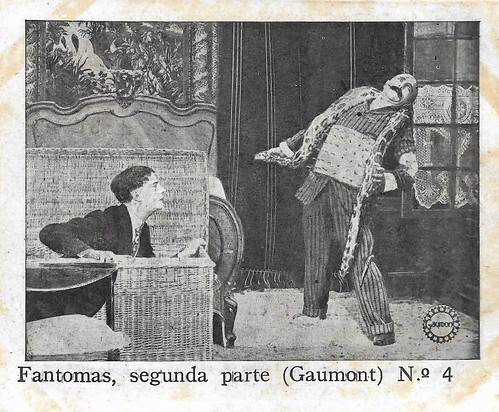
Spanish minicard by Reclam Films, Mallorca, card no. 4. Photo: Gaumont. Georges Melchior as Fandor and Edmund Breon as Inspector Juve in a scene from the serial Fantomas, second series, Juve versus Fantômas/Juve contre Fantômas (Louis Feuillade, 1913). Warned a 'silent executioner' will attack Juve, he has armed himself with a belt of spikes, while Fandor hides in a basket. Indeed, a giant boa constrictor attacks Juve.
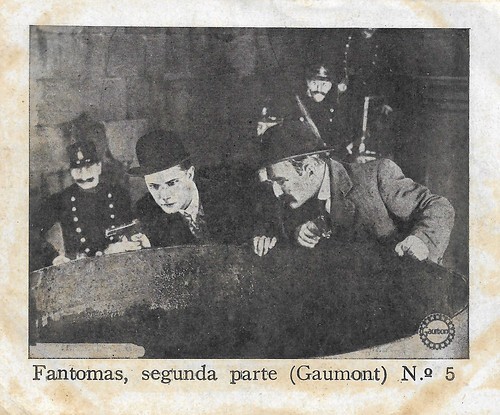
Spanish minicard by Reclam Films, Mallorca, card no. 5. Photo: Gaumont. Georges Melchior as Fandor and Edmund Breon as Inspector Juve in a scene from the serial Fantomas, second series, Juve versus Fantômas/Juve contre Fantômas (Louis Feuillade, 1913). Juve and Fandor inspect the cistern in the Haunted Villa.
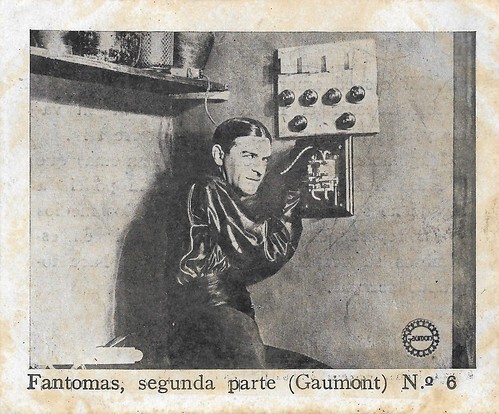
Spanish minicard by Reclam Films, Mallorca, card no. 6. Photo: Gaumont. René Navarre as Fantomas in a scene from the serial Fantomas, second series, Juve versus Fantômas/Juve contre Fantômas (Louis Feuillade, 1913). Fantomas aka The Man in Black dynamites the villa in which Juve and Fandor are.
La Mort qui tue (1913)
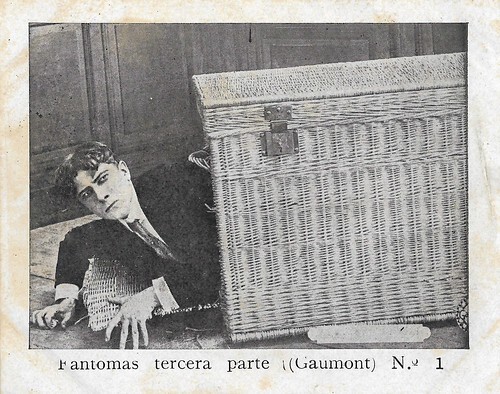
Spanish minicard by Reclam Films, Mallorca, card no. 1. Photo: Gaumont. Scene from the third episode of the French silent crime serial Fantomas, La Mort qui tue/The Dead Man Who Killed (Louis Feuillade, 1913). Fandor (Georges Melchior) has hidden in a trunk and discovers the body of Thomery.
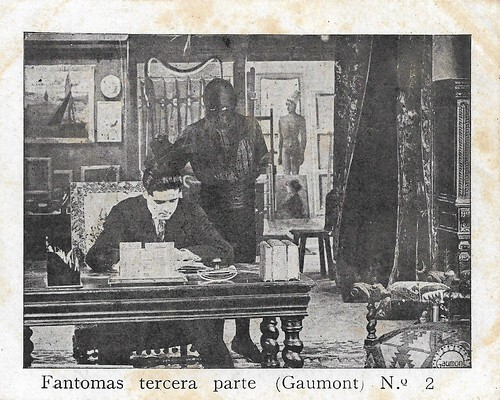
Spanish minicard by Reclam Films, Mallorca, card no. 2. Photo: Gaumont. Scene from the third episode of the French silent crime serial Fantomas, La Mort qui tue/The Dead Man Who Killed (Louis Feuillade, 1913). Fantomas ( René Navarre ), dressed as the Black Man, is about to chloroform the painter Jacques Dollon ( André Luguet ).
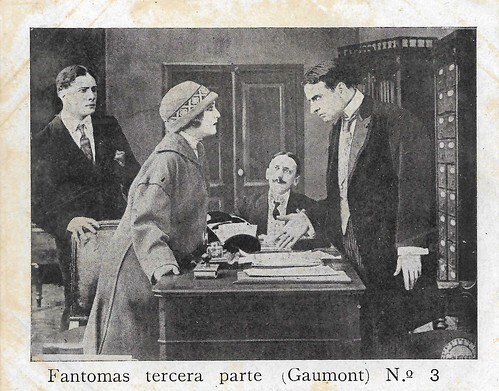
Spanish minicard by Reclam Films, Mallorca, card no. 3. Photo: Gaumont. Scene from the third episode of the French silent crime serial Fantomas, La Mort qui tue/The Dead Man Who Killed (Louis Feuillade, 1913). A devastated Elisabeth Dollon (Fabienne Fabrèges) hears from the judge that her husband apparently has killed a baroness and is arrested. On the left, Fandor (Georges Melchior) assists.
The six episodes of the next Fantômas sequel, La Mort qui tue/The Dead Man Who Killed (Louis Feuillade, November 1913), make it one of the longest in the series, and in reprising characters and situations from the earlier films, it is even more grisly in its violence. After Juve and Fandor escape the destruction of Lady Beltham's villa (not without injury), it is the journalist who now pursues the archcriminal, but with no more success than Juve had. As before, Fantômas's exploits take him and his pursuer through several different levels of French society.
In the first episode, Fantômas chloroforms a painter named Jacques Dollon ( André Luguet ) in order to set him up for the murder of a wealthy baroness he has killed. In prison, the guard Nibet (Naudier) stabs Dollon to death, and Fantômas takes away the body in order to remove the skin of its right hand—for a human glove. Here, Juve, disguised as a clochard, has to rescue Fandor who has followed Fantômas to a Seine sewer inlet (where Dollon's body is dumped). Princes Danidoff (Jane Faber), whom we saw in the first episode, returns in the third episode, to give a party for her fiancé Thomery (Luitz-Morat), a sugar-plantation owner, and promptly is robbed of her jewels again by Fantômas, disguised as a banker named Nanteuil—but on her neck (she has been rendered unconscious) is a fingerprint that turns out to be Dollon's.
Lady Beltham then returns in the next episode, to deliver a ransom note for the jewels to Thomery, who is lured to an empty apartment and garroted by Fantômas's gang. In the fifth episode, Fantômas searches the Pension Bourrat, where Elizabeth Dollon (Fabienne Fabrèges) is staying, trying to recover an enigmatic list she found earlier in her brother's cell, and Fandor arrives just in time to save her from being asphyxiated—and sends her to a convent for protection. Then, hidden in a packing basket of her belongings which Fantômas has requisitioned, he is transported to the gang's hideout and discovers Thomery's body. Finally, Fandor links up again with Juve, and they confront Nanteuil, thinking that they have Fantômas at last—but he vanishes before their eyes (and guns) through a secret wall panel door.
From this narrative summary, the six episodes of Le mort qui tue would seem to correspond closely to the film's six reels. According to the National Film Archive's print, however, which covers only the last three episodes and has Czech intertitles (All of the Fantômas films were restored in 1995-1996 by Gaumont Studios, with the assistance of the French Government), this film, too, either carried the action across at least some of the reel breaks or else used the reel break to heighten suspense near the end of an episode. One break in the NFA print, for instance, comes just after Fantômas exits from Elizabeth's room at the pension, after having drugged her coffee and turned on the gas; the next opens with Fandor breaking into the room to turn off the gas and open a window.
Yet, if Le mort qui tue resembles its predecessors in this use of reel breaks, its mode of representation is slightly different. Most of the scenes, for instance, are shot in studio decors, and frequent intertitles either link or interrupt the AS ("American Shot" - from the knees up), LS (Long Shot) or FS (Full Shot), LS tableaux. Some of the decors, especially the ones with less depth, are quite spare, but this is used to good effect for moments like the garroting—where Thomery steps from a background painted-flat hallway into an empty room, through a central doorway on either side of which two hooded figures stand poised. One of the film's more interesting features, however, is the greater number of cut-in CUs (Close-Ups) and ECUs (Extreme Close-Ups) of objects, which prove more deceptive than revealing.
In episode three, for instance, the CU photograph of the fingerprint lifted from the princess's neck baffles her guests, and the ECU of the pearls that Lady Beltham shows Thomery deceives him into believing that the ransom exchange is genuine—in both cases, by contrast, the spectator can conclude that this is Fantômas's handiwork. Curiously, another cut-in close shot briefly positions the spectator as superior to Fantômas — when Elizabeth stuffs the list into the back of a blotter, which he later overlooks in his search of her room. Yet, a cut-in CU of his hand turning the gas lever then threatens to take revenge on her for the sleight of hand, as well as on any spectator tempted to identify with her. These CUs culminate in the last scene as Juve rips the glove of human skin from Fantômas's hand—only to have him disappear through the wall, secreted beneath one more fake exterior.
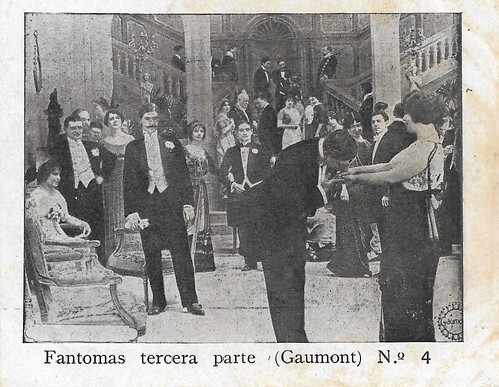
Spanish minicard by Reclam Films, Mallorca, card no. 4. Photo: Gaumont. Scene from the third episode of the French silent crime serial Fantomas, La Mort qui tue/The Dead Man Who Killed (Louis Feuillade, 1913). Princess Danidoff (Jane Faber) is kissed by her fiancé, the rich Thomery (Luitz-Morat), but Fantomas (the moustached man on the left), dressed as the banker Nanteuil, has more eyes for her jewels.
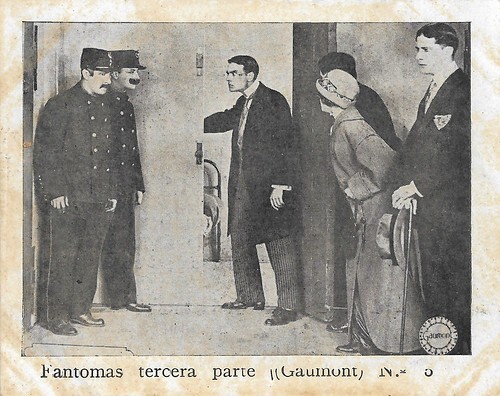
Spanish minicard by Reclam Films, Mallorca, card no. 5. Photo: Gaumont. Scene from the third episode of the French silent crime serial Fantomas, La Mort qui tue/The Dead Man Who Killed (Louis Feuillade, 1913). The prison warden discovers the disappearance of Dollon and scoffs at the guards. On the right Dollon's wife Elisabeth (Fabienne Fabrèges) and Fandor (Georges Melchior) assist.
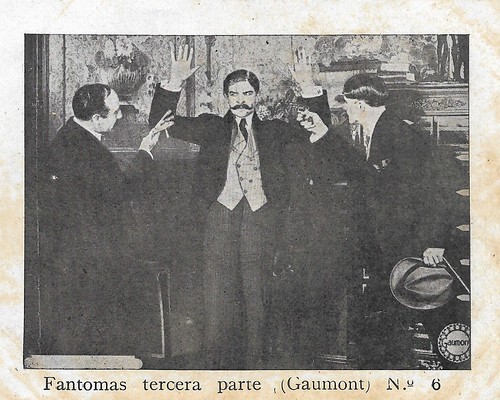
Spanish minicard by Reclam Films, Mallorca, card no. 6. Photo: Gaumont. Scene from the third episode of the French silent crime serial Fantomas, La Mort qui tue/The Dead Man Who Killed (Louis Feuillade, 1913). Fantomas ( René Navarre ) is held at gunpoint by Inspector Juve (Edmund Breon) and Fandor (Georges Melchior), but manages to escape - again - through a hidden door in the wall behind him.
Sources: Robin Walz (Fantomas lives), Richard Abel (The Ciné Goes To Town: French Cinema 1896-1914), and IMDb.
Juve versus Fantômas (1913)

Spanish minicard by Reclam Films, Mallorca, card no. 1. Photo: Gaumont. Fandor (Georges Melchior) and Inspector Juve (Edmund Breaon) in a scene from the serial Fantomas, second series, Juve versus Fantômas/ Juve contre Fantômas (Louis Feuillade, 1913). The shootout with the barrels of alcohol takes an ugly turn when the villains set the barrels on fire. Seen on their backs: Fandor and Juve.

Spanish minicard by Reclam Films, Mallorca, card no. 2. Photo: Gaumont. Edmund Breon as Inspector Juve, Georges Melchior as the reporter Fandor and Yvette Andreyor as Joséphine 'la pierreuse' (the hustler) in a scene from the serial Fantomas, second series, Juve versus Fantômas/ Juve contre Fantômas (Louis Feuillade, 1913). Juve and Fandor meet Joséphine at the fancy ball.

Spanish minicard by Reclam Films, Mallorca, card no. 3. Photo: Gaumont. Renée Carl as Lady Beltham in a scene from the serial Fantomas, second series, Juve versus Fantômas/Juve contre Fantômas (Louis Feuillade, 1913). Lady Beltham receives a letter from her old lover Gurn aka Fantomas.
Juve versus Fantômas/Juve contre Fantômas (Louis Feuillade, 1913) opens with shots of the leading actors and their disguises: René Navarre as himself (the actor), Dr. Chaleck (bearded), the gang-leader Loupart (moustache, bowler hat, and cigarette), and the "Man in Black" (the "true visage" of Fantômas...); Edmond Bréon as himself (the actor), Inspector Juve (moustache and bowler hat) and disguised as a businessman (mutton-chop sideburns and dress hat).
The Simplon Express Disaster: In his office, Inspector Juve ponders and signs a report to the Commissioner of Police. Welcoming the journalist Jérôme Fandor, Juve hands him the report, which refers to the discovery of a woman's body, crushed beyond recognition, in the house of Dr. Chaleck. Papers on the body identify it as Lady Beltham, but Juve is skeptical. (In the first Fantômas adventure, the Englishwoman assisted her criminal lover, Gurn (alias Fantômas), in both the murder of her husband, Lord Beltham, and the substitution of the actor Valgrand for the imprisoned Gurn on the eve of the criminal's execution. Juve engages Fandor to help him in the case. Outside on the street, Dr. Chaleck (alias Fantômas) gets into a taxi, shadowed by Juve and Fandor who follow in another cab. But it is the bandit Loupart (another alias of Fantômas) who reemerges from the taxi. Loupart approaches Joséphine-la-Pierreuse, a street prostitute and the bandit's mistress, who passes him a note. Juve and Fandor split up, each pursuing one of the two suspicious characters.
Fantomas & Josephine: Loupart reads the note, which explains that Joséphine will be meeting a courier from a wine merchant at the Gare de Lyon. The courier, holding 150,000 francs, believes that they'll be going on a tryst—of course, he'll be robbed instead. Loupart gets into a cab, but when Juve tries to follow in a second cab, a member of Loupart's gang jumps on the back of the taxi and punctures the rear tire. Juve loses the trail. But Fandor shadows Joséphine more successfully through the Métro [with location shots inside a moving Métro train!] and to her apartment. From a café, Fandor sends off a quick note to Juve. At the Gare de Lyon, Joséphine meets Martialle, the courier. They enter a train compartment, and Fandor follows, taking the neighbouring compartment. Two of Loupart's accomplices stroll the corridor...The train pulls out. Loupart appears in the corridor, encountering Fandor, whom the criminal recognizes.
To make their robbery easier, one of Loupart's men detaches the coach from the rest of the train. Donning black masks, Loupart and his gang rob Martialle at gunpoint (a couple members of his gang rob Fandor at the same time, for good measure and to keep the journalist out of the picture). After the criminals depart, Fandor and Martialle realize that the coach is coasting back down the mountainside and they leap out. In horror, they watch as the next train along the line, the Simplon express, crashes into the loose car. Meanwhile, Loupart and company escape to a waiting car. Joséphine discovers a letter from Martialle's employers among the robbed possessions, explaining that the 150 thousand-franc notes carried by the courier have each been cut in half, with the other halves to be delivered later. Their theft is foiled! But Loupart has a plan. En route by car, he stops at a post office and sends Juve a false telegram from "Fandor" setting a meeting for the wharves near the wine warehouse at 11 pm that night.
At the Bercy Warehouse: Juve receives the telegram, but he is also contacted by the real Fandor, whom Loupart/Fantômas believes has died in the Simplon express crash. Therefore, Juve and Fandor appear in the scene together, prepared for some sort of mischief from Fantômas, but uncertain what form their challenge will take. Juve and Fandor surreptitiously crawl among barrels of spirits stacked along the banks of the Seine near the Bercy warehouse. But, it's an ambush! Loupart/ Fantômas's men, hidden among the barrels, open fire upon the detective and journalist. Then, the bandit's gang set fire to the barrels of liquor, trapping Juve and Fandor. To escape the flames and smoke, the two heroes climb into an empty barrel, roll down into the water, and swim away to safety across the river.
At the Crocodile: Joséphine dines at the elegant Montmartre restaurant "The Crocodile" with a young man who liberally imbibes champagne (and subsequently falls asleep at the table). By a stroke of fortune, Juve and Fandor not only dine at the same restaurant but are seated at the adjoining table. Recognizing Joséphine, Fandor and Juve confront her and demand to know the whereabouts of Loupart/ Chaleck/ Fantômas. Finding herself compromised, the prostitute reveals another coincidence—Dr. Chaleck is dining in the next room! Overjoyed at his luck, Juve dances a little jig with Joséphine... Through the maître d'hôtel, Juve proposes that Chaleck meet him outside the restaurant. Surprisingly, Chaleck/Fantômas accepts. Retrieving his overcoat from the cloakroom, Chaleck steps out of the restaurant and into the hands of Juve and Fandor. The detective and Journalist each firmly secure the arms of Chaleck, when—he bolts free! Stunned, Juve and Fandor discover artificial limbs attached to Chaleck's overcoat—they've been outsmarted by Fantômas once again. The archcriminal tips his hat as he hops into the back of a cab, and disappears around the corner. Momentarily, Chaleck resumes his place at the restaurant, celebrating his latest escape with champagne.
The Haunted Villa: Lady Beltham receives an unexpected letter from Gurn/Fantômas. Unable to keep her resolve not to see her murderous lover, she goes to the rendezvous. She is startled by the appearance of Dr. Chaleck in her room, but Fantômas quickly reassures her that he is actually Gurn, her lover, in disguise. Despite her revulsion toward the criminal, the English mistress succumbs to the will of Gurn/Fantômas, and she agrees to meet him at her deserted villa every Tuesday at midnight. Juve and Fandor, disguised as businessmen, visit Lady Beltham's deserted villa under the pretence of buying the property. The caretaker lets them in, and shows them around the "haunted villa." Upstairs, the disguised inspector discovers a pen covered with fresh ink—in an empty house? The caretaker insists that the house is haunted, which he confirms by the voices he hears at night coming through the heating vents. Juve insists on seeing the basement, where he discovers a large furnace connected to the heating vents, as well as a rainwater cistern.
The following Tuesday, when Lady Beltham arrives for her appointed rendezvous with Gurn/Fantômas, she is followed by Juve and Fandor. Crawling into the heating vent, the detective and journalist overhear the conversation of the criminal lovers. They learn about Fantômas's plan to kill Juve, while the detective sleeps, with his "silent executioner." Bracing himself for a certain, but unknown, assassin, Juve straps protective corsets on his abdomen and arms before going to bed. Close by, Fandor hides in a wicker trunk at the foot of Juve's bed, as the detective awaits his killer. In the darkness, the silent executioner—a boa constrictor—arrives. In a frenzied battle with his would-be murderer, Juve escapes, as Fandor emerges from his hiding place, stumbling about in the "darkness" (indicated at the time by tinting the film blue), absolutely no help at all. Once again, Fantômas is foiled...
The Cistern/The Man In Black: Finally, Fantômas appears in the villa in his "true visage"—that is, 'en cagoule', the "Man in Black" dressed in black tights, shirt, gloves and hood. Still, the Lord of Terror senses that something is amiss at the villa, and he prepares himself for any confrontation with the police by wiring the house with dynamite. Hoping to surprise Fantômas, Juve and Fandor arrive at the villa with the police. But the Man in Black refuses to give in to his enemies. Pursued through the house, in a brilliant escape, Fantômas hides underwater in the basement cistern, breathing through a wine bottle whose bottom he punctured on the drying rack. When Juve fails to find Fantômas in the basement, he has the police light a fire in the furnace in order to "smoke out" the archcriminal. After Juve and the police leave the basement, Fantômas reemerges from the cistern. He crawls out a basement window and runs to the neighbouring workshed, where he throws the electrical switch which ignites the dynamite and blows up the house. In triumph, the Lord of Terror stretches his arms to the sky in a gesture of victory. "But are Juve and Fandor really dead?" The next episode will tell...

Spanish minicard by Reclam Films, Mallorca, card no. 4. Photo: Gaumont. Georges Melchior as Fandor and Edmund Breon as Inspector Juve in a scene from the serial Fantomas, second series, Juve versus Fantômas/Juve contre Fantômas (Louis Feuillade, 1913). Warned a 'silent executioner' will attack Juve, he has armed himself with a belt of spikes, while Fandor hides in a basket. Indeed, a giant boa constrictor attacks Juve.

Spanish minicard by Reclam Films, Mallorca, card no. 5. Photo: Gaumont. Georges Melchior as Fandor and Edmund Breon as Inspector Juve in a scene from the serial Fantomas, second series, Juve versus Fantômas/Juve contre Fantômas (Louis Feuillade, 1913). Juve and Fandor inspect the cistern in the Haunted Villa.

Spanish minicard by Reclam Films, Mallorca, card no. 6. Photo: Gaumont. René Navarre as Fantomas in a scene from the serial Fantomas, second series, Juve versus Fantômas/Juve contre Fantômas (Louis Feuillade, 1913). Fantomas aka The Man in Black dynamites the villa in which Juve and Fandor are.
La Mort qui tue (1913)

Spanish minicard by Reclam Films, Mallorca, card no. 1. Photo: Gaumont. Scene from the third episode of the French silent crime serial Fantomas, La Mort qui tue/The Dead Man Who Killed (Louis Feuillade, 1913). Fandor (Georges Melchior) has hidden in a trunk and discovers the body of Thomery.

Spanish minicard by Reclam Films, Mallorca, card no. 2. Photo: Gaumont. Scene from the third episode of the French silent crime serial Fantomas, La Mort qui tue/The Dead Man Who Killed (Louis Feuillade, 1913). Fantomas ( René Navarre ), dressed as the Black Man, is about to chloroform the painter Jacques Dollon ( André Luguet ).

Spanish minicard by Reclam Films, Mallorca, card no. 3. Photo: Gaumont. Scene from the third episode of the French silent crime serial Fantomas, La Mort qui tue/The Dead Man Who Killed (Louis Feuillade, 1913). A devastated Elisabeth Dollon (Fabienne Fabrèges) hears from the judge that her husband apparently has killed a baroness and is arrested. On the left, Fandor (Georges Melchior) assists.
The six episodes of the next Fantômas sequel, La Mort qui tue/The Dead Man Who Killed (Louis Feuillade, November 1913), make it one of the longest in the series, and in reprising characters and situations from the earlier films, it is even more grisly in its violence. After Juve and Fandor escape the destruction of Lady Beltham's villa (not without injury), it is the journalist who now pursues the archcriminal, but with no more success than Juve had. As before, Fantômas's exploits take him and his pursuer through several different levels of French society.
In the first episode, Fantômas chloroforms a painter named Jacques Dollon ( André Luguet ) in order to set him up for the murder of a wealthy baroness he has killed. In prison, the guard Nibet (Naudier) stabs Dollon to death, and Fantômas takes away the body in order to remove the skin of its right hand—for a human glove. Here, Juve, disguised as a clochard, has to rescue Fandor who has followed Fantômas to a Seine sewer inlet (where Dollon's body is dumped). Princes Danidoff (Jane Faber), whom we saw in the first episode, returns in the third episode, to give a party for her fiancé Thomery (Luitz-Morat), a sugar-plantation owner, and promptly is robbed of her jewels again by Fantômas, disguised as a banker named Nanteuil—but on her neck (she has been rendered unconscious) is a fingerprint that turns out to be Dollon's.
Lady Beltham then returns in the next episode, to deliver a ransom note for the jewels to Thomery, who is lured to an empty apartment and garroted by Fantômas's gang. In the fifth episode, Fantômas searches the Pension Bourrat, where Elizabeth Dollon (Fabienne Fabrèges) is staying, trying to recover an enigmatic list she found earlier in her brother's cell, and Fandor arrives just in time to save her from being asphyxiated—and sends her to a convent for protection. Then, hidden in a packing basket of her belongings which Fantômas has requisitioned, he is transported to the gang's hideout and discovers Thomery's body. Finally, Fandor links up again with Juve, and they confront Nanteuil, thinking that they have Fantômas at last—but he vanishes before their eyes (and guns) through a secret wall panel door.
From this narrative summary, the six episodes of Le mort qui tue would seem to correspond closely to the film's six reels. According to the National Film Archive's print, however, which covers only the last three episodes and has Czech intertitles (All of the Fantômas films were restored in 1995-1996 by Gaumont Studios, with the assistance of the French Government), this film, too, either carried the action across at least some of the reel breaks or else used the reel break to heighten suspense near the end of an episode. One break in the NFA print, for instance, comes just after Fantômas exits from Elizabeth's room at the pension, after having drugged her coffee and turned on the gas; the next opens with Fandor breaking into the room to turn off the gas and open a window.
Yet, if Le mort qui tue resembles its predecessors in this use of reel breaks, its mode of representation is slightly different. Most of the scenes, for instance, are shot in studio decors, and frequent intertitles either link or interrupt the AS ("American Shot" - from the knees up), LS (Long Shot) or FS (Full Shot), LS tableaux. Some of the decors, especially the ones with less depth, are quite spare, but this is used to good effect for moments like the garroting—where Thomery steps from a background painted-flat hallway into an empty room, through a central doorway on either side of which two hooded figures stand poised. One of the film's more interesting features, however, is the greater number of cut-in CUs (Close-Ups) and ECUs (Extreme Close-Ups) of objects, which prove more deceptive than revealing.
In episode three, for instance, the CU photograph of the fingerprint lifted from the princess's neck baffles her guests, and the ECU of the pearls that Lady Beltham shows Thomery deceives him into believing that the ransom exchange is genuine—in both cases, by contrast, the spectator can conclude that this is Fantômas's handiwork. Curiously, another cut-in close shot briefly positions the spectator as superior to Fantômas — when Elizabeth stuffs the list into the back of a blotter, which he later overlooks in his search of her room. Yet, a cut-in CU of his hand turning the gas lever then threatens to take revenge on her for the sleight of hand, as well as on any spectator tempted to identify with her. These CUs culminate in the last scene as Juve rips the glove of human skin from Fantômas's hand—only to have him disappear through the wall, secreted beneath one more fake exterior.

Spanish minicard by Reclam Films, Mallorca, card no. 4. Photo: Gaumont. Scene from the third episode of the French silent crime serial Fantomas, La Mort qui tue/The Dead Man Who Killed (Louis Feuillade, 1913). Princess Danidoff (Jane Faber) is kissed by her fiancé, the rich Thomery (Luitz-Morat), but Fantomas (the moustached man on the left), dressed as the banker Nanteuil, has more eyes for her jewels.

Spanish minicard by Reclam Films, Mallorca, card no. 5. Photo: Gaumont. Scene from the third episode of the French silent crime serial Fantomas, La Mort qui tue/The Dead Man Who Killed (Louis Feuillade, 1913). The prison warden discovers the disappearance of Dollon and scoffs at the guards. On the right Dollon's wife Elisabeth (Fabienne Fabrèges) and Fandor (Georges Melchior) assist.

Spanish minicard by Reclam Films, Mallorca, card no. 6. Photo: Gaumont. Scene from the third episode of the French silent crime serial Fantomas, La Mort qui tue/The Dead Man Who Killed (Louis Feuillade, 1913). Fantomas ( René Navarre ) is held at gunpoint by Inspector Juve (Edmund Breon) and Fandor (Georges Melchior), but manages to escape - again - through a hidden door in the wall behind him.
Sources: Robin Walz (Fantomas lives), Richard Abel (The Ciné Goes To Town: French Cinema 1896-1914), and IMDb.
Published on September 12, 2022 22:00
September 11, 2022
Kees Brusse
Dutch actor and film director Kees Brusse (1925–2013) appeared in over 50 films and TV films from 1936 on. He starred in the Dutch film classic Dokter Pulder zaait papavers/Doctor Pulder Sows Poppies (Bert Haanstra, 1975), which was entered into the 26th Berlin International Film Festival, and several other major Dutch films.
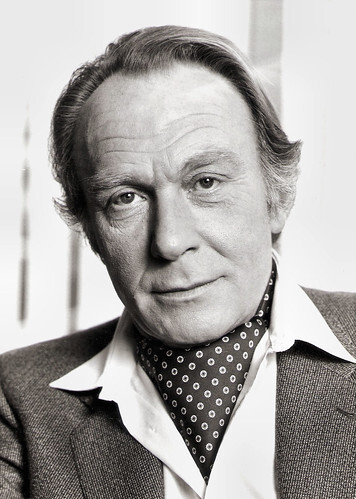
Dutch press photo by NCRV. Photo: Kippa. Kees Brusse in De verjaring/The limitation period (Kees Brusse, Andrew Wilson, 1980).
A Subdued, Natural Way of Acting
Kees Brusse was born as Cornelius Brusse in Rotterdam, Netherlands in 1925. He was the son of well-known author and journalist Marie Joseph Brusse and opera singer Antje Ebes. Kees had six brothers and half brothers, filmmaker Ytzen Brusse, journalist Jan Brusse, journalist/filmmaker Peter Brusse, sculptor Mark Brusse, the prematurely deceased Marie Joseph Jr. and architect Henk Brusse.
At the age of eleven, he made his film debut as Merijntje’s brother Arjaan in the Dutch drama Merijntje Gijzen's Jeugd/Merijntje Gijzen's Youth (Kurt Gerron, 1936), based on the popular novel written by A.M. De Jong.
Brusse attended high school, but for the theatre school, he was rejected. As an actor and as a director he was self-taught. At the age of 16, he made his stage debut as Pietje Puck in the play 'Boefje' (Rascal) (1941) at the Gemeentelijk Theaterbedrijf Amsterdam (Municipal Theatre Company Amsterdam).
A year later, he played in 'De mooiste ogen van de wereld' (The most beautiful eyes in the world) (1942). In 1943 he played at the Central Theatre led by Cees Laseur. With Laseur and Wim Ibo, he also did cabaret.
After the liberation of the Netherlands in 1945, Brusse worked in Cabaret Wim Sonneveld . With the international cabaret company of Rudolf Nelson, he made a tour in Switzerland. In the period 1948-1949, Brusse travelled with his theatre group C6 through Indonesia.
He developed a characteristic acting style. No exaggerated gestures or carried voice, but a subdued, natural way of acting. In 1948 he married his first wife, Pamela Ingenegeren (Pam Henning). Four more marriages would follow: in 1954 he married the actress Mieke Verstraete, in 1975 Marlou Peters, and in 1986 Sonja Boerrigter, and finally the Australian Joan St. Clair.
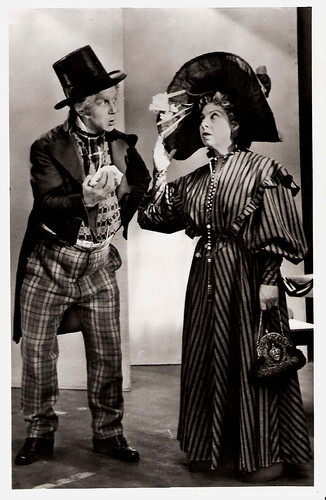
Dutch postcard van Rotterdamse Comedie, no. 153. Photo: Kees Molkenboer, Rotterdam. Kees Brusse and Elly van Stekelenburg in the stage play Fientje Beulemans/The Marriage of Mademoiselle Beulemans (1952) by Jean François Fonson and Lucien Wicheler.
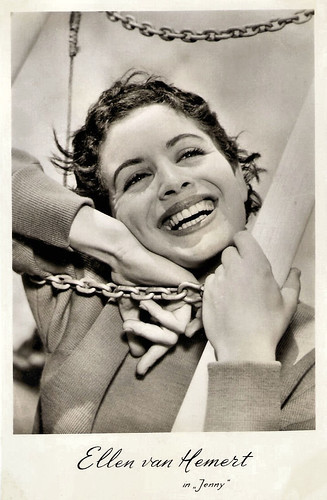
Dutch postcard by Uitg. Takken, Utrecht, no. 3192. Photo: N.V. Standaardfilms. Ellen van Hemert in Jenny (Willy van Hemert, 1958).
The Third Best Visited Film of the Dutch Cinema Ever
In 1950, Kees Brusse’s film career really took off with the lead in De dijk is dicht/The dyke is closed (Anton Koolhaas, 1950), the first major Dutch film production after WW II. Frank Veenstra (a.k.a. Boba_Fett1138) at IMDb calls it ‘A surprising good humble little film’: “Beside the directing, also the acting really surprised in this movie. While some of the actors are obvious non-actors and probably just locals, the main parts are being played by some fine actors who give away a great performance.”
Brusse appeared in two acclaimed documentaries by his brother Ytzen, Hij, zij, en een wereldhaven/He, she, and a world port (Ytzen Brusse, 1952) and Het meest getapt/The most tapped (Ytzen Brusse, 1953).
From 1952 to 1954 Kees Brusse gave artistic leadership to the stage company Rotterdamse Comédie, where he worked with dramaturge Anna Blaman and his future wife Mieke Verstraete.
In 1955 he had a huge success with his role in Ciske de Rat/Ciske the Rat (1955), directed by German film-maker Wolfgang Staudte and based on the popular novels by Piet Bakker. With 2,433,000 viewers it is the third best-visited film in the Dutch cinema ever. The film was also shown at the Venice Film Festival, where it won a Silver Lion of San Marco.
Staudte also made a German version Ciske: Ein Kind Braucht Liebe/Ciske: A Child Needs Love (1955). The cast was different although Kees Brusse returned as Ciske’s teacher Bruis.
Two years later he starred in the comedy Kleren maken de man/Clothes make the man (Georg Jacoby, 1957) with Annet Nieuwenhuizen and Andrea Domburg , and then in the first Dutch colour feature, the romantic drama Jenny (Willy van Hemert, 1958), featuring Ellen van Hemert . Jenny was an updated adaptation of the oft-filmed romantic drama Eight Girls in a Boat.
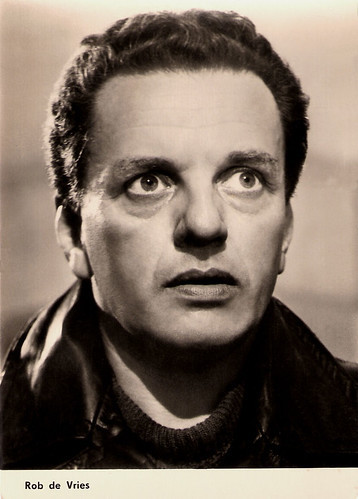
. East-German postcard by VEB Progress Film-Vertrieb, Berlin, no. 2010, 1964. Retail price: 0,20 DM. Photo: Rob de Vries in De Overval/The Silent Raid (Paul Rotha, 1962).
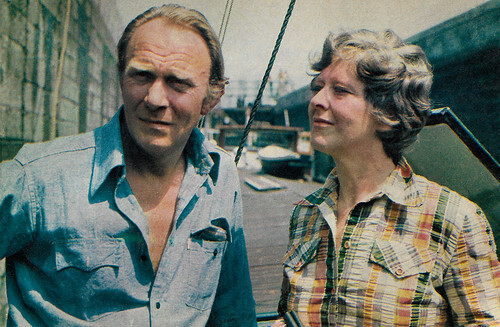
Dutch blank back card. Kees Brusse and Dora van der Groen in Tussen wal en schip (Eimert Kruidhof, 1977).
People of Tomorrow
During the 1950s, Kees Brusse enjoyed huge successes on Dutch radio with radio plays and improvisation shows. The most successful was the biweekly series De Familie Doorsnee/The family Rate, written by Annie M.G. Schmidt and aired from 1952 to 1958.
Brusse also became known through the new medium of television. He appeared in the popular situation comedy Pension Hommeles/Guesthouse Much a-do (Erik de Vries, 1957-1959), again written by Annie M.G. Schmidt.
He played Inspector Maigret in the Dutch-Belgian crime series Maigret (1964-1965), based on the novels by Georges Simenon. Other popular TV series were Tussen wal en schip/Between two stools (Eimert Kruidhof, 1977), and Mensen zoals jij en ik/Everyday people like you and me (Rob Herzet, 1981-1985).
He was also a panellist in the game show Wie van de drie/Who of the three. Till the early 1960s, Brusse combined his TV work in the daytime with stage acting in the evening. He worked for such theatre companies as Toneelgroep Theater, the Haagse Comedie, the Amsterdams Toneel and the Nederlandse Comedie.
Already during the 1950s, Brusse showed interest in the young generation who were living in a turbulent time. He directed short films like De paraplu/The Umbrella (1956) and Het gerucht/The Rumour (1960), which advocated for sex education for young people. Brusse garnered respect as a director with his documentary Mensen van morgen/People of tomorrow (1964) in which he interviewed young people. Later he made several more documentaries.
In the early 1960s, he appeared in a few films by the ailing Dutch film industry. Both De zaak M.P./The Manneken Pis Case (Bert Haanstra, 1960) and his own feature Kermis in de Regen/Fair in the Rain (Kees Brusse, 1962) were disappointments, commercially and artistically. A huge success was the war thriller De overval/The silent Raid (Paul Rotha, 1963) with Rob de Vries and Yoka Beretty .
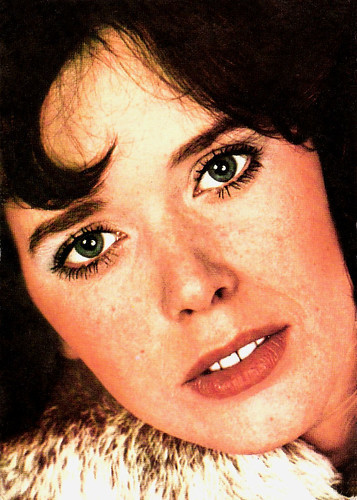
Sylvia Kristel . Romanian postcard by Casa Filmului Acin.
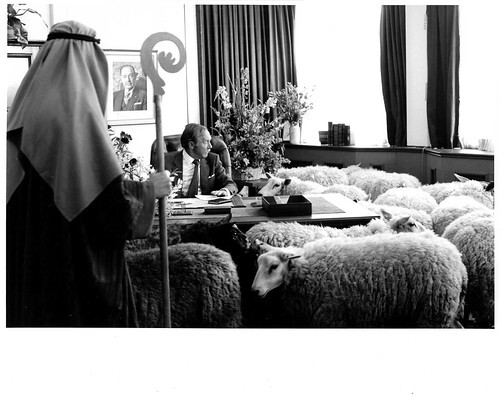
Dutch press photo. Kees Brusse in Een pak slaag/Mr. Slotter's Jubilee (Bert Haanstra, Rimko Haanstra, 1979).
Blue Movie
After eight years of TV work, Kees Brusse returned to the cinema in the soft sex film Blue Movie (Wim Verstappen, 1971), an international box-office hit and notable as the first film produced in Holland with full frontal nudity for both sexes.
Brusse also appeared in Verstappen’s dark satire VD (Wim Verstappen, 1973) opposite Andrea Domburg , and Dakota (Wim Verstappen, 1974) with Monique van de Ven and Willeke van Ammelrooy.
More interesting are Dokter Pulder zaait papavers/Doctor Pulder Sows Poppies (Bert Haanstra, 1975) with Dora van der Groen and Rooie Sien/Red Sien (Frans Weisz, 1975) starring Willeke Alberti . Other films were Mysteries/Evil Mysteries (Paul de Lussanet, 1977) starring Rutger Hauer and Sylvia Kristel, and Een pak slag/Mr. Slotter's Jubilee (Bert Haanstra, Rimko Haanstra, 1979).
In 1982, he received a prestigious Dutch TV award, the Gouden Televizierring (Golden Televizier Ring), for his TV series Mensen zoals jij en ik/Everyday people like you and me (Rob Herzet, 1981-1985). The series was based on the German TV series Leute wie du und ich, a series of short stories written by Herbert Reinecker. In each episode, Brusse played a different character, including a taxi driver, a clown, a seducer and a businessman.
He continued to appear in TV films and series, including De wandelaar/The walker (Eimert Kruidhof, 1989), the popular hospital series Medisch Centrum West/MCW (1991), and the thriller Tasten in het duister/The Right to Know (Stephan Brenninkmeijer, 1996). His final screen appearance was in the TV series De erfenis/The heritage (Johan Nijenhuis a.o., 2004) with Manouk van der Meulen.
Brusse was socially active. In addition to his work, he was an ambassador for the organization Greenwisheen, a platform for people who commit their expertise, creativity and talents to initiatives in the field of nature, environment and sustainability. He created the Kees Brusse Foundation for the empowerment of older persons. In 1987, he was appointed to Ridder in de Orde van Oranje-Nassau (Knight in the Order of Orange-Nassau).
In 1988, he moved with his fourth wife, Sonja Boerrigte, to Bonaire, France and finally Australia. After her death in 2000, Brusse returned temporarily to the Netherlands. Until January 2013, he lived in anonymity in Perth, Australia. In March 2011, he visited the Netherlands to present his biography 'Herinneringen: Ovatie aan het leven' (Memories: ovation to life).
In early 2013 Kees Brusse returned to the Netherlands for good. He stayed at the Rosa Spier House in Laren, where he died on 9 December 2013.
De overval/The silent Raid (1963). Source: Eye Filmmuseum (YouTube).
Dokter Pulder zaait papavers/Doctor Pulder Sows Poppies (1975). Source: Hugo de Derde (YouTube).
Sources: Hans Nauta (Trouw - Dutch), Annemieke Hendriks (De pioniers - Dutch), AllMovie, Wikipedia (English and Dutch), and .

Dutch press photo by NCRV. Photo: Kippa. Kees Brusse in De verjaring/The limitation period (Kees Brusse, Andrew Wilson, 1980).
A Subdued, Natural Way of Acting
Kees Brusse was born as Cornelius Brusse in Rotterdam, Netherlands in 1925. He was the son of well-known author and journalist Marie Joseph Brusse and opera singer Antje Ebes. Kees had six brothers and half brothers, filmmaker Ytzen Brusse, journalist Jan Brusse, journalist/filmmaker Peter Brusse, sculptor Mark Brusse, the prematurely deceased Marie Joseph Jr. and architect Henk Brusse.
At the age of eleven, he made his film debut as Merijntje’s brother Arjaan in the Dutch drama Merijntje Gijzen's Jeugd/Merijntje Gijzen's Youth (Kurt Gerron, 1936), based on the popular novel written by A.M. De Jong.
Brusse attended high school, but for the theatre school, he was rejected. As an actor and as a director he was self-taught. At the age of 16, he made his stage debut as Pietje Puck in the play 'Boefje' (Rascal) (1941) at the Gemeentelijk Theaterbedrijf Amsterdam (Municipal Theatre Company Amsterdam).
A year later, he played in 'De mooiste ogen van de wereld' (The most beautiful eyes in the world) (1942). In 1943 he played at the Central Theatre led by Cees Laseur. With Laseur and Wim Ibo, he also did cabaret.
After the liberation of the Netherlands in 1945, Brusse worked in Cabaret Wim Sonneveld . With the international cabaret company of Rudolf Nelson, he made a tour in Switzerland. In the period 1948-1949, Brusse travelled with his theatre group C6 through Indonesia.
He developed a characteristic acting style. No exaggerated gestures or carried voice, but a subdued, natural way of acting. In 1948 he married his first wife, Pamela Ingenegeren (Pam Henning). Four more marriages would follow: in 1954 he married the actress Mieke Verstraete, in 1975 Marlou Peters, and in 1986 Sonja Boerrigter, and finally the Australian Joan St. Clair.

Dutch postcard van Rotterdamse Comedie, no. 153. Photo: Kees Molkenboer, Rotterdam. Kees Brusse and Elly van Stekelenburg in the stage play Fientje Beulemans/The Marriage of Mademoiselle Beulemans (1952) by Jean François Fonson and Lucien Wicheler.

Dutch postcard by Uitg. Takken, Utrecht, no. 3192. Photo: N.V. Standaardfilms. Ellen van Hemert in Jenny (Willy van Hemert, 1958).
The Third Best Visited Film of the Dutch Cinema Ever
In 1950, Kees Brusse’s film career really took off with the lead in De dijk is dicht/The dyke is closed (Anton Koolhaas, 1950), the first major Dutch film production after WW II. Frank Veenstra (a.k.a. Boba_Fett1138) at IMDb calls it ‘A surprising good humble little film’: “Beside the directing, also the acting really surprised in this movie. While some of the actors are obvious non-actors and probably just locals, the main parts are being played by some fine actors who give away a great performance.”
Brusse appeared in two acclaimed documentaries by his brother Ytzen, Hij, zij, en een wereldhaven/He, she, and a world port (Ytzen Brusse, 1952) and Het meest getapt/The most tapped (Ytzen Brusse, 1953).
From 1952 to 1954 Kees Brusse gave artistic leadership to the stage company Rotterdamse Comédie, where he worked with dramaturge Anna Blaman and his future wife Mieke Verstraete.
In 1955 he had a huge success with his role in Ciske de Rat/Ciske the Rat (1955), directed by German film-maker Wolfgang Staudte and based on the popular novels by Piet Bakker. With 2,433,000 viewers it is the third best-visited film in the Dutch cinema ever. The film was also shown at the Venice Film Festival, where it won a Silver Lion of San Marco.
Staudte also made a German version Ciske: Ein Kind Braucht Liebe/Ciske: A Child Needs Love (1955). The cast was different although Kees Brusse returned as Ciske’s teacher Bruis.
Two years later he starred in the comedy Kleren maken de man/Clothes make the man (Georg Jacoby, 1957) with Annet Nieuwenhuizen and Andrea Domburg , and then in the first Dutch colour feature, the romantic drama Jenny (Willy van Hemert, 1958), featuring Ellen van Hemert . Jenny was an updated adaptation of the oft-filmed romantic drama Eight Girls in a Boat.

. East-German postcard by VEB Progress Film-Vertrieb, Berlin, no. 2010, 1964. Retail price: 0,20 DM. Photo: Rob de Vries in De Overval/The Silent Raid (Paul Rotha, 1962).

Dutch blank back card. Kees Brusse and Dora van der Groen in Tussen wal en schip (Eimert Kruidhof, 1977).
People of Tomorrow
During the 1950s, Kees Brusse enjoyed huge successes on Dutch radio with radio plays and improvisation shows. The most successful was the biweekly series De Familie Doorsnee/The family Rate, written by Annie M.G. Schmidt and aired from 1952 to 1958.
Brusse also became known through the new medium of television. He appeared in the popular situation comedy Pension Hommeles/Guesthouse Much a-do (Erik de Vries, 1957-1959), again written by Annie M.G. Schmidt.
He played Inspector Maigret in the Dutch-Belgian crime series Maigret (1964-1965), based on the novels by Georges Simenon. Other popular TV series were Tussen wal en schip/Between two stools (Eimert Kruidhof, 1977), and Mensen zoals jij en ik/Everyday people like you and me (Rob Herzet, 1981-1985).
He was also a panellist in the game show Wie van de drie/Who of the three. Till the early 1960s, Brusse combined his TV work in the daytime with stage acting in the evening. He worked for such theatre companies as Toneelgroep Theater, the Haagse Comedie, the Amsterdams Toneel and the Nederlandse Comedie.
Already during the 1950s, Brusse showed interest in the young generation who were living in a turbulent time. He directed short films like De paraplu/The Umbrella (1956) and Het gerucht/The Rumour (1960), which advocated for sex education for young people. Brusse garnered respect as a director with his documentary Mensen van morgen/People of tomorrow (1964) in which he interviewed young people. Later he made several more documentaries.
In the early 1960s, he appeared in a few films by the ailing Dutch film industry. Both De zaak M.P./The Manneken Pis Case (Bert Haanstra, 1960) and his own feature Kermis in de Regen/Fair in the Rain (Kees Brusse, 1962) were disappointments, commercially and artistically. A huge success was the war thriller De overval/The silent Raid (Paul Rotha, 1963) with Rob de Vries and Yoka Beretty .

Sylvia Kristel . Romanian postcard by Casa Filmului Acin.

Dutch press photo. Kees Brusse in Een pak slaag/Mr. Slotter's Jubilee (Bert Haanstra, Rimko Haanstra, 1979).
Blue Movie
After eight years of TV work, Kees Brusse returned to the cinema in the soft sex film Blue Movie (Wim Verstappen, 1971), an international box-office hit and notable as the first film produced in Holland with full frontal nudity for both sexes.
Brusse also appeared in Verstappen’s dark satire VD (Wim Verstappen, 1973) opposite Andrea Domburg , and Dakota (Wim Verstappen, 1974) with Monique van de Ven and Willeke van Ammelrooy.
More interesting are Dokter Pulder zaait papavers/Doctor Pulder Sows Poppies (Bert Haanstra, 1975) with Dora van der Groen and Rooie Sien/Red Sien (Frans Weisz, 1975) starring Willeke Alberti . Other films were Mysteries/Evil Mysteries (Paul de Lussanet, 1977) starring Rutger Hauer and Sylvia Kristel, and Een pak slag/Mr. Slotter's Jubilee (Bert Haanstra, Rimko Haanstra, 1979).
In 1982, he received a prestigious Dutch TV award, the Gouden Televizierring (Golden Televizier Ring), for his TV series Mensen zoals jij en ik/Everyday people like you and me (Rob Herzet, 1981-1985). The series was based on the German TV series Leute wie du und ich, a series of short stories written by Herbert Reinecker. In each episode, Brusse played a different character, including a taxi driver, a clown, a seducer and a businessman.
He continued to appear in TV films and series, including De wandelaar/The walker (Eimert Kruidhof, 1989), the popular hospital series Medisch Centrum West/MCW (1991), and the thriller Tasten in het duister/The Right to Know (Stephan Brenninkmeijer, 1996). His final screen appearance was in the TV series De erfenis/The heritage (Johan Nijenhuis a.o., 2004) with Manouk van der Meulen.
Brusse was socially active. In addition to his work, he was an ambassador for the organization Greenwisheen, a platform for people who commit their expertise, creativity and talents to initiatives in the field of nature, environment and sustainability. He created the Kees Brusse Foundation for the empowerment of older persons. In 1987, he was appointed to Ridder in de Orde van Oranje-Nassau (Knight in the Order of Orange-Nassau).
In 1988, he moved with his fourth wife, Sonja Boerrigte, to Bonaire, France and finally Australia. After her death in 2000, Brusse returned temporarily to the Netherlands. Until January 2013, he lived in anonymity in Perth, Australia. In March 2011, he visited the Netherlands to present his biography 'Herinneringen: Ovatie aan het leven' (Memories: ovation to life).
In early 2013 Kees Brusse returned to the Netherlands for good. He stayed at the Rosa Spier House in Laren, where he died on 9 December 2013.
De overval/The silent Raid (1963). Source: Eye Filmmuseum (YouTube).
Dokter Pulder zaait papavers/Doctor Pulder Sows Poppies (1975). Source: Hugo de Derde (YouTube).
Sources: Hans Nauta (Trouw - Dutch), Annemieke Hendriks (De pioniers - Dutch), AllMovie, Wikipedia (English and Dutch), and .
Published on September 11, 2022 22:00
September 10, 2022
Adele Mara
Adele Mara (1923-2010) was an American actress, singer, and dancer, who appeared in films during the 1940s and 1950s and on television in the 1950s and 1960s. During the 1940s, the blonde actress was also a popular pinup girl.
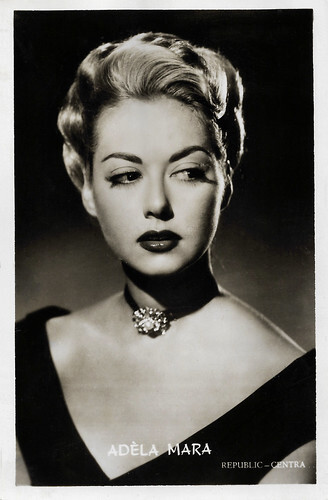
Belgian postcard by Nieuwe Merksemsche Chocolaterie, Merksem (Anvers). Photo: Republic / Centra. Adele Mara's name is misspelt at the card as Adèla Mara.
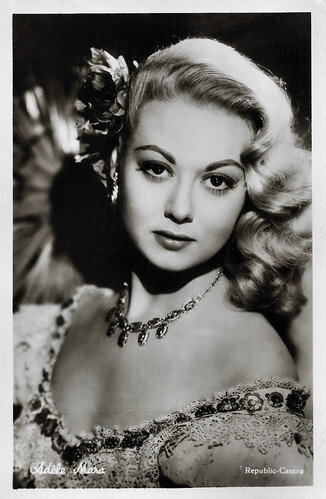
Belgian postcard by Nieuwe Merksemsche Chocolaterie, Merksem (Anvers). Photo: Republic / Centra.
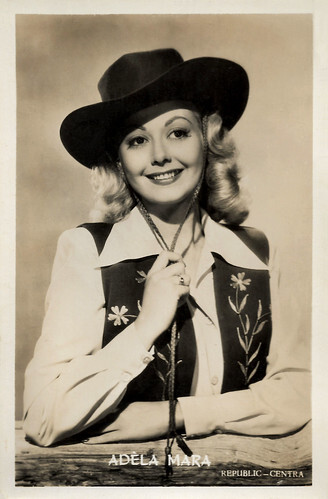
Vintage card. Photo: Republic / Centra.
Transformed into a sexy platinum blonde pin-up
Adele Mara was born Adelaida Delgado in 1923 in Highland Park, Michigan, to Spanish parents. She had a brother, Luis, who became an actor. Mara danced as part of bandleader Xavier Cugat's show at such esteemed clubs as the Copacabana. While touring as a singer/dancer, she was spotted in Florida by a Columbia talent scout and signed to a Hollywood contract in 1942 at age 19.
Under the professional name of Adele St. Mara, she started off in bit exotic roles in such films as Honolulu Lu (Charles Barton, 1941) starring Lupe Velez , and gained experience in the studio's B features and comedy shorts. Her stage name was soon shortened to Adele Mara. One of Mara's early roles was as a receptionist in the Three Stooges film I Can Hardly Wait.
She quickly grew to alluring co-starring status opposite Joe E. Brown in Shut My Big Mouth (Lew Landers, 1942). Mara and Leslie Brooks played the sisters of Rita Hayworth 's character in the Fred Astaire film You Were Never Lovelier (William A. Seiter, 1942). In Alias Boston Blackie (Lew Landers, 1942), she plays the leading female role, as the sister of an escaped and wrongfully accused convict.
When her Columbia contract lapsed, she moved to Republic Pictures, where she was transformed into a sexy platinum blonde pin-up. Mara became a fixture in the studio's Westerns, predominantly cast as senorita-types opposite cowboy stars Roy Rogers in Bells of Rosarita (Frank McDonald, 1945) and Gene Autry in Twilight on the Rio Grande (Frank McDonald, 1947).
She also appeared in crime dramas including Blackmail (Lesley Selander, 1947) and Web of Danger (Philip Ford, 1947) and adventure films starring John Wayne such as Wake of the Red Witch (Edward Ludwig, 1948), and Sands of Iwo Jima (Allan Dwan, 1949) in which she was John Agar's love interest. Other interesting films were the Film-Noirs The Tiger Woman (Philip Ford, 1945), and Count the Hours! (Don Siegel, 1953) with Theresa Wright.
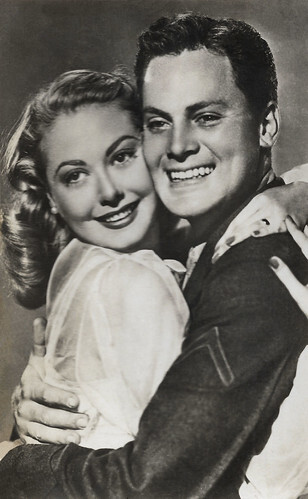
Spanish postcard by Ed. Sobe. John Agar and Adele Mara in Sands of Iwo Jima (Allan Dwan, 1949).
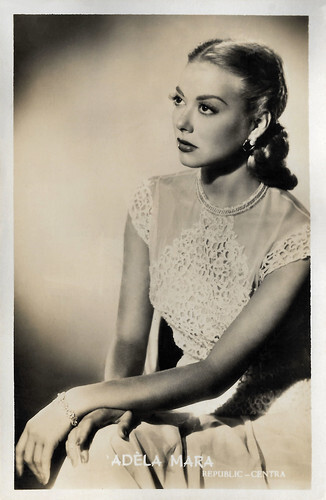
Belgian postcard by Nieuwe Merksemsche Chocolaterie, Merksem (Anvers). Photo: Republic / Centra. Adele Mara's name is misspelt at the card as Adèla Mara.
Guest star in TV Westerns
In 1955 Adele Mara appeared as Sarita on the TV Western Cheyenne in the episode 'Border Showdown'. In 1958, Mara played Maria Costa in the Bat Masterson episode 'Double Showdown' with Gene Barry. In 1961, Mara appeared as a nurse with Cesar Romero on The Red Skelton Show in a sketch titled 'Deadeye and The Alamo'.
About this time, she guest-starred in the Western series The Tall Man (1962) with Clu Gulager, as well as three episodes of Maverick (1958-1960), episodes of Laramie (1960), Tales of Wells Fargo (1959) with Dale Robertson and The Life and Legend of Wyatt Earp (1958-1961) with Hugh O'Brien.
She also appeared in the Alfred Hitchcock Hour episode 'House Guest' (1962). Her last screen appearance would be in The Big Circus (Joseph M. Newman, 1959) with Victor Mature .
Mara was married to screenwriter/series creator/producer/novelist Roy Huggins and appeared in his television series Maverick. She eventually abandoned her career and settled down to raise their three sons, Thomas (1960), John (1961), and James Patrick (1963). Only on a rare occasion, she would appear as a guest in one of his husband's efforts, including an episode of the TV series Cool Million (1972).
The couple remained married until his death at age 87 in 2002. The marriage had spanned half a century. Mara's brother, Luis Delgado (1925–1997) played small, often uncredited roles in films and TV, especially in the projects of his close friend James Garner, for whom Delgado also worked as a personal assistant. Adele Mara died of natural causes in Los Angeles in 2010. The 87-year-old actress was interred at San Fernando Mission Cemetery.
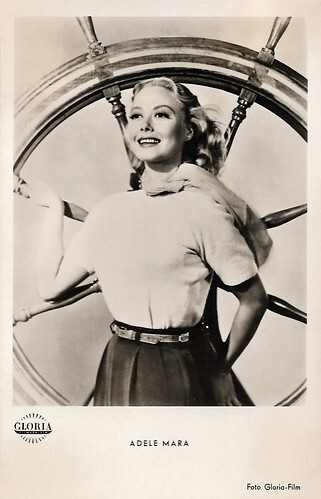
West-German postcard by Kunst und Bild, Berlin, no. A 1152. Photo: Republic / Gloria-Film. Adele Mara in The Sea Hornet (Joseph Kane, 1951).
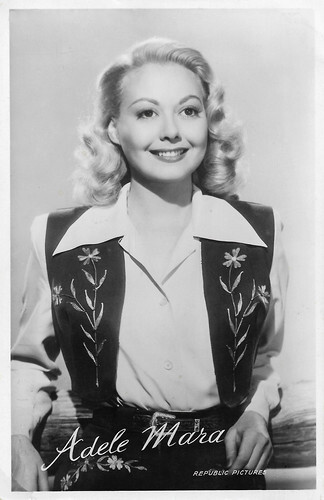
Vintage card. Photo: Republic Pictures.
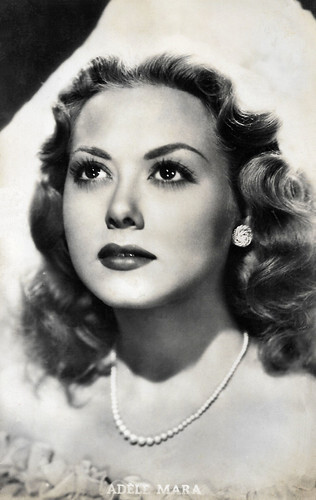
Vintage postcard. Photo: Republic.
Sources: (IMDb), Wikipedia and .

Belgian postcard by Nieuwe Merksemsche Chocolaterie, Merksem (Anvers). Photo: Republic / Centra. Adele Mara's name is misspelt at the card as Adèla Mara.

Belgian postcard by Nieuwe Merksemsche Chocolaterie, Merksem (Anvers). Photo: Republic / Centra.

Vintage card. Photo: Republic / Centra.
Transformed into a sexy platinum blonde pin-up
Adele Mara was born Adelaida Delgado in 1923 in Highland Park, Michigan, to Spanish parents. She had a brother, Luis, who became an actor. Mara danced as part of bandleader Xavier Cugat's show at such esteemed clubs as the Copacabana. While touring as a singer/dancer, she was spotted in Florida by a Columbia talent scout and signed to a Hollywood contract in 1942 at age 19.
Under the professional name of Adele St. Mara, she started off in bit exotic roles in such films as Honolulu Lu (Charles Barton, 1941) starring Lupe Velez , and gained experience in the studio's B features and comedy shorts. Her stage name was soon shortened to Adele Mara. One of Mara's early roles was as a receptionist in the Three Stooges film I Can Hardly Wait.
She quickly grew to alluring co-starring status opposite Joe E. Brown in Shut My Big Mouth (Lew Landers, 1942). Mara and Leslie Brooks played the sisters of Rita Hayworth 's character in the Fred Astaire film You Were Never Lovelier (William A. Seiter, 1942). In Alias Boston Blackie (Lew Landers, 1942), she plays the leading female role, as the sister of an escaped and wrongfully accused convict.
When her Columbia contract lapsed, she moved to Republic Pictures, where she was transformed into a sexy platinum blonde pin-up. Mara became a fixture in the studio's Westerns, predominantly cast as senorita-types opposite cowboy stars Roy Rogers in Bells of Rosarita (Frank McDonald, 1945) and Gene Autry in Twilight on the Rio Grande (Frank McDonald, 1947).
She also appeared in crime dramas including Blackmail (Lesley Selander, 1947) and Web of Danger (Philip Ford, 1947) and adventure films starring John Wayne such as Wake of the Red Witch (Edward Ludwig, 1948), and Sands of Iwo Jima (Allan Dwan, 1949) in which she was John Agar's love interest. Other interesting films were the Film-Noirs The Tiger Woman (Philip Ford, 1945), and Count the Hours! (Don Siegel, 1953) with Theresa Wright.

Spanish postcard by Ed. Sobe. John Agar and Adele Mara in Sands of Iwo Jima (Allan Dwan, 1949).

Belgian postcard by Nieuwe Merksemsche Chocolaterie, Merksem (Anvers). Photo: Republic / Centra. Adele Mara's name is misspelt at the card as Adèla Mara.
Guest star in TV Westerns
In 1955 Adele Mara appeared as Sarita on the TV Western Cheyenne in the episode 'Border Showdown'. In 1958, Mara played Maria Costa in the Bat Masterson episode 'Double Showdown' with Gene Barry. In 1961, Mara appeared as a nurse with Cesar Romero on The Red Skelton Show in a sketch titled 'Deadeye and The Alamo'.
About this time, she guest-starred in the Western series The Tall Man (1962) with Clu Gulager, as well as three episodes of Maverick (1958-1960), episodes of Laramie (1960), Tales of Wells Fargo (1959) with Dale Robertson and The Life and Legend of Wyatt Earp (1958-1961) with Hugh O'Brien.
She also appeared in the Alfred Hitchcock Hour episode 'House Guest' (1962). Her last screen appearance would be in The Big Circus (Joseph M. Newman, 1959) with Victor Mature .
Mara was married to screenwriter/series creator/producer/novelist Roy Huggins and appeared in his television series Maverick. She eventually abandoned her career and settled down to raise their three sons, Thomas (1960), John (1961), and James Patrick (1963). Only on a rare occasion, she would appear as a guest in one of his husband's efforts, including an episode of the TV series Cool Million (1972).
The couple remained married until his death at age 87 in 2002. The marriage had spanned half a century. Mara's brother, Luis Delgado (1925–1997) played small, often uncredited roles in films and TV, especially in the projects of his close friend James Garner, for whom Delgado also worked as a personal assistant. Adele Mara died of natural causes in Los Angeles in 2010. The 87-year-old actress was interred at San Fernando Mission Cemetery.

West-German postcard by Kunst und Bild, Berlin, no. A 1152. Photo: Republic / Gloria-Film. Adele Mara in The Sea Hornet (Joseph Kane, 1951).

Vintage card. Photo: Republic Pictures.

Vintage postcard. Photo: Republic.
Sources: (IMDb), Wikipedia and .
Published on September 10, 2022 22:00
September 9, 2022
Photo by Mac Walten, Berlin
Mac Walten (1872–1936) was a stage and artist photographer in Berlin in the 1910s and 1920s. His real name was Max Gruenthal. There was hardly an actor, dancer or singer in Weimar who did not stand in front of his lens. He made his living from star postcards and collector's pictures and press photos. He also appeared in a few films: Max als Juxgraf (Leonhard Haskel, 1919) and Tropengift (Hans Schomburgk, 1919). We selected for this post seventeen postcards with his portraits.
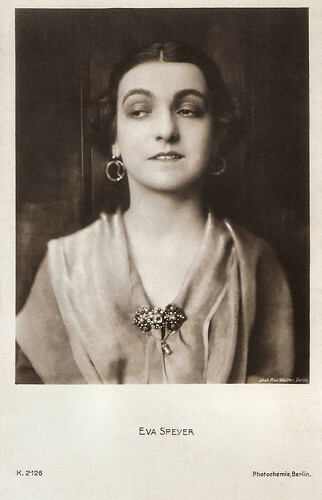
German postcard by Photochemie, Berlin no. K.2126. Photo: Mac Walten, Berlin.
Eva Speyer (1883-1932 (?)), also known as Eva Stöckl Speyer, was a German actress, who appeared in more than seventy films from 1911 to 1932.
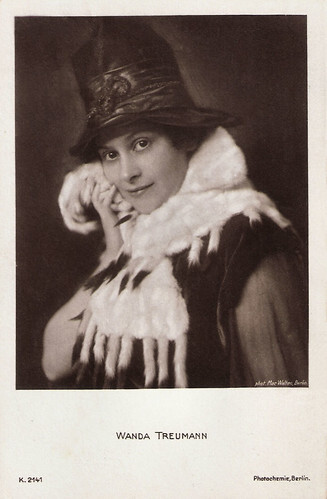
German postcard by Photochemie, Berlin, no. K.2141. Photo: Mac Walten, Berlin.
Wanda Treumann (1883–1963) belonged to the most popular stars of German cinema before the first World War. Together with Viggo Larsen she also produced more than 80 films in the 1910s, in which she often played the female lead. As an actress, she played in nearly 90 films, but many of them were shorts.
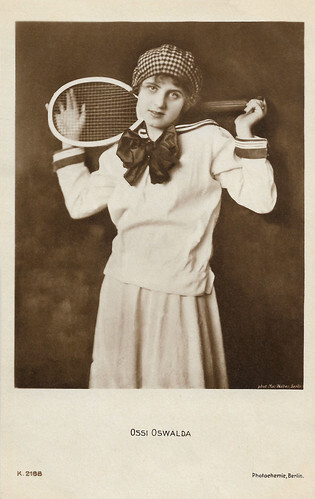
German postcard by Photochemie, Berlin, no. K.2188. Photo: Mac Walten, Berlin.
Ossi Oswalda (1895-1947) was one of the most popular comediennes of German silent cinema.
<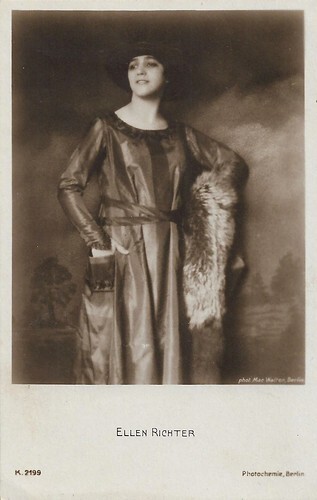
German postcard by Photochemie, Berlin, no. K.2199. Photo: Mac Walten, Berlin.
Austrian actress and producer Ellen Richter (1893-1963) caused a sensation as a leading lady in German silent dramas and action films from the middle of the 1910s. Especially in the 1920s, she presented herself as 'The Modern Woman'.
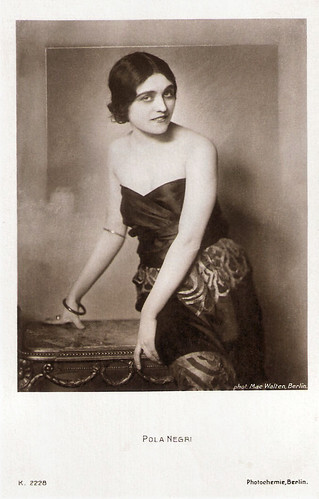
German postcard by Photochemie, Berlin, no. K.2228. Photo: Mac Walten, Berlin.
Polish film actress Pola Negri (1897-1987) achieved fame and notoriety as a femme fatale in German and American silent films between the 1910s and 1930s. Negri was an overnight sensation in Ernst Lubitsch' Madame du Barry/Passion (1919). She moved to Hollywood where she lived in a palace, modelled after the White House.
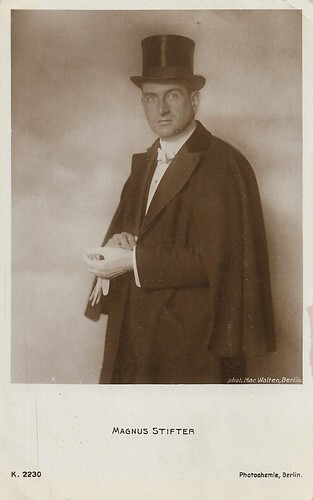
German postcard by Photochemie, Berlin, no. K.2230. Photo: Mac Walten, Berlin.
Magnus Stifter (1878-1943) was an Austrian actor and film director, who acted in well over 100 German - mostly silent - films.
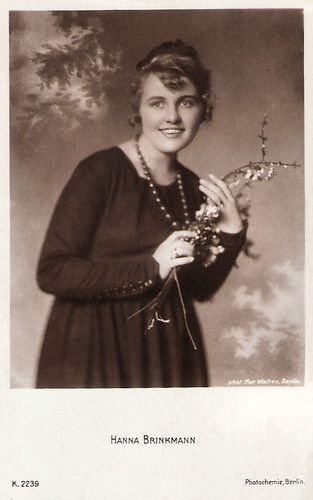
German postcard by Photochemie, Berlin, no. K.2239. Photo: Mac Walten, Berlin.
German actress Hanne Brinkmann (1895-1984) appeared in 24 silent films between 1914 and 1929. During the First World War, she was a popular comedian who had her own film series.
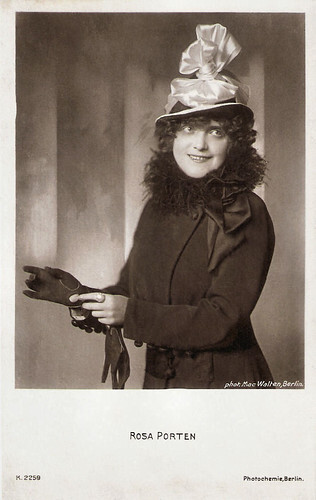
German postcard by Photochemie, Berlin, no. K. 2259. Photo: Mac Walten, Berlin.
Rosa Porten (1884-1972) was a German screenwriter, film director and actress of the silent era. She was Henny Porten's sister.
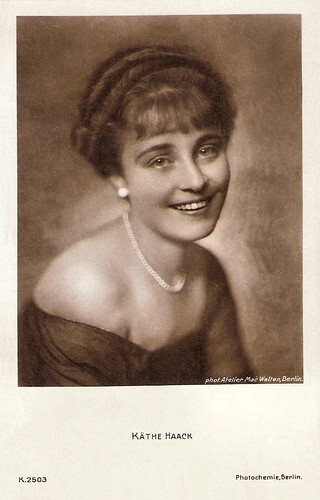
German postcard by Photochemie, Berlin, no. K.2503. Photo: Phot. Atelier Walten, Berlin.
Käthe Haack (1897-1986) was an extremely versatile German actress. Between 1915 and 1980 she appeared in some 230 films and television productions.
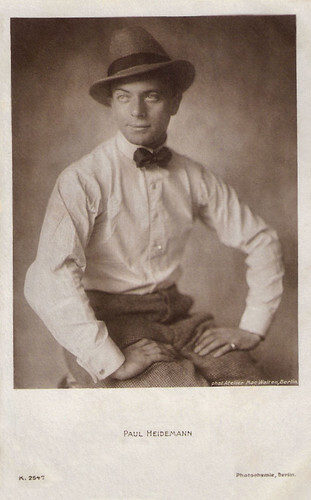
German postcard by Photochemie, Berlin, no. K.2547. Photo: Atelier Mac Walten, Berlin.
Paul Heidemann (1884-1968) was a German stage and screen actor, film director and film producer. He was famous for his comical parts.
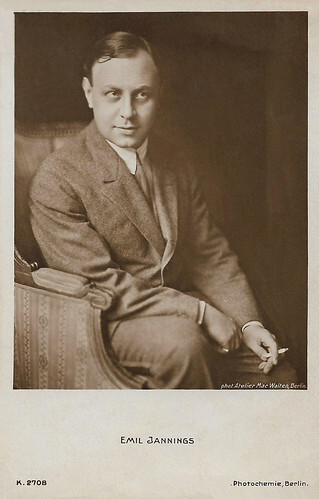
German postcard by Photochemie, Berlin, no. K.2708. Photo: Atelier Mac Walten, Berlin.
If Weimar cinema had one film star, then it was Emil Jannings (1884-1950) for sure. He was a great actor in the silent era and won the first Oscar for Best Actor. Priceless are his performances as Louis XV in Lubitsch's Madame Dubarry (1919), as the doorman in Murnau's The Last Laugh (1924), the jealous acrobat in Dupont's Variety (1925) and the professor in Von Sternberg's The Blue Angel (1930).
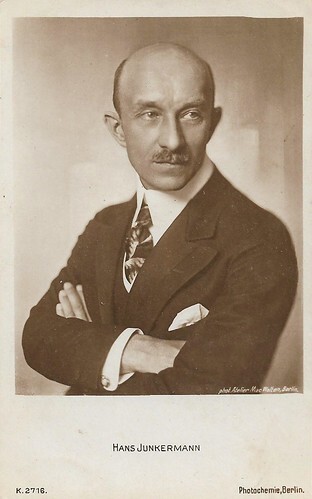
German postcard by Photochemie, Berlin, no. K.2716. Photo: Atelier Mac Walten, Berlin.
Hans Junkermann (1872-1943) was a prolific German character comedian, noted for his gauche manner and walrus moustache. In films from 1911, including a brief 1930 sojourn in Hollywood, acting in German-language versions of American films under the direction of Jacques Feyder. Subsequently, he was seen in many German A-grade productions until his death in 1943. He was married to the Austrian actress Julia Serda.
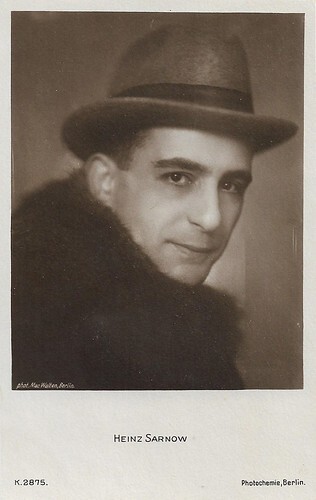
German postcard by Photochemie, Berlin, no. K.2875. Photo: Mac Walten, Berlin.
Heinz Sarnow (1882-1943) was an Austrian stage and screen actor and director, known for films such as Der zeugende Tod (1921), Nie sollst Du mich befragen (1919) and Eine Frauenschönheit unter dem Seziermesser (1920). Sarnow played in 31 films between 1913 and 1932.
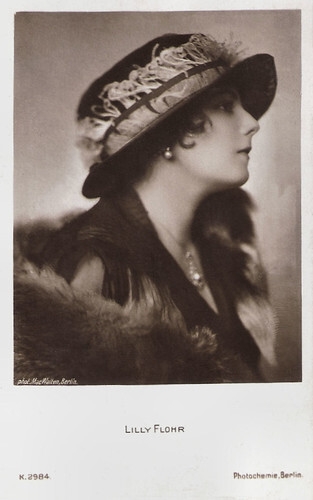
German postcard by Photochemie, Berlin, no. K.2984. Photo: Mac Walten, Berlin.
Austrian film star Lilly Flohr (1893-1978) was a busy actress, soubrette, cabaret artist and chanson singer on stage. From 1918 on she starred in 25 silent films.

German postcard by Photochemie, Berlin, no. K.3001. Photo: Mac Walten, Berlin.
Ernst Rückert (1886-1950) was a German stage and screen actor. In the 1910s he was a popular film actor, while in the mid-1920s he starred in so-called Prussian films.
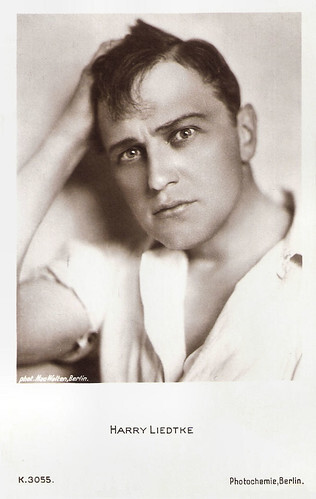
German postcard by Photochemie, Berlin, no. K.3055. Photo: Mac Walten, Berlin.
Harry Liedtke (1882-1945) was the charming ladykiller of many early silent classics. Detective serials like Joe Deebs made him one of the first male stars of German cinema.
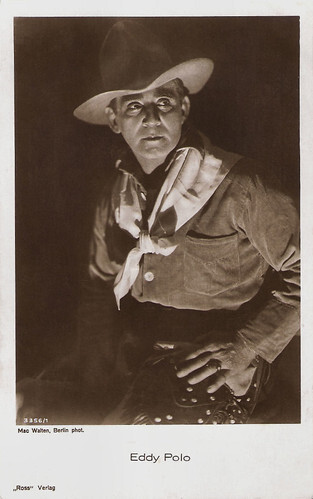
German postcard by Ross Verlag, no. 3356/1, 1928-1929. Photo: Mac Walten, Berlin.
Eddie Polo (1875–1961) was an Austro-American actor of the silent era. He was born Edward W. Wyman or Weimer in Vienna, Austria-Hungary. With his brother Sam, he was the trapeze act The Flying Cordovas. He was the first man to parachute off the Eiffel Tower. Beginning in 1913, he appeared in serials and films in the USA and as Cyclone Smith, he became a popular Western hero. During the late 1920s, he was an action star in the German silent cinema. After his acting career ended in the mid-1940s he worked as a makeup artist.
Source: National Portrait Gallery.

German postcard by Photochemie, Berlin no. K.2126. Photo: Mac Walten, Berlin.
Eva Speyer (1883-1932 (?)), also known as Eva Stöckl Speyer, was a German actress, who appeared in more than seventy films from 1911 to 1932.

German postcard by Photochemie, Berlin, no. K.2141. Photo: Mac Walten, Berlin.
Wanda Treumann (1883–1963) belonged to the most popular stars of German cinema before the first World War. Together with Viggo Larsen she also produced more than 80 films in the 1910s, in which she often played the female lead. As an actress, she played in nearly 90 films, but many of them were shorts.

German postcard by Photochemie, Berlin, no. K.2188. Photo: Mac Walten, Berlin.
Ossi Oswalda (1895-1947) was one of the most popular comediennes of German silent cinema.
<

German postcard by Photochemie, Berlin, no. K.2199. Photo: Mac Walten, Berlin.
Austrian actress and producer Ellen Richter (1893-1963) caused a sensation as a leading lady in German silent dramas and action films from the middle of the 1910s. Especially in the 1920s, she presented herself as 'The Modern Woman'.

German postcard by Photochemie, Berlin, no. K.2228. Photo: Mac Walten, Berlin.
Polish film actress Pola Negri (1897-1987) achieved fame and notoriety as a femme fatale in German and American silent films between the 1910s and 1930s. Negri was an overnight sensation in Ernst Lubitsch' Madame du Barry/Passion (1919). She moved to Hollywood where she lived in a palace, modelled after the White House.

German postcard by Photochemie, Berlin, no. K.2230. Photo: Mac Walten, Berlin.
Magnus Stifter (1878-1943) was an Austrian actor and film director, who acted in well over 100 German - mostly silent - films.

German postcard by Photochemie, Berlin, no. K.2239. Photo: Mac Walten, Berlin.
German actress Hanne Brinkmann (1895-1984) appeared in 24 silent films between 1914 and 1929. During the First World War, she was a popular comedian who had her own film series.

German postcard by Photochemie, Berlin, no. K. 2259. Photo: Mac Walten, Berlin.
Rosa Porten (1884-1972) was a German screenwriter, film director and actress of the silent era. She was Henny Porten's sister.

German postcard by Photochemie, Berlin, no. K.2503. Photo: Phot. Atelier Walten, Berlin.
Käthe Haack (1897-1986) was an extremely versatile German actress. Between 1915 and 1980 she appeared in some 230 films and television productions.

German postcard by Photochemie, Berlin, no. K.2547. Photo: Atelier Mac Walten, Berlin.
Paul Heidemann (1884-1968) was a German stage and screen actor, film director and film producer. He was famous for his comical parts.

German postcard by Photochemie, Berlin, no. K.2708. Photo: Atelier Mac Walten, Berlin.
If Weimar cinema had one film star, then it was Emil Jannings (1884-1950) for sure. He was a great actor in the silent era and won the first Oscar for Best Actor. Priceless are his performances as Louis XV in Lubitsch's Madame Dubarry (1919), as the doorman in Murnau's The Last Laugh (1924), the jealous acrobat in Dupont's Variety (1925) and the professor in Von Sternberg's The Blue Angel (1930).

German postcard by Photochemie, Berlin, no. K.2716. Photo: Atelier Mac Walten, Berlin.
Hans Junkermann (1872-1943) was a prolific German character comedian, noted for his gauche manner and walrus moustache. In films from 1911, including a brief 1930 sojourn in Hollywood, acting in German-language versions of American films under the direction of Jacques Feyder. Subsequently, he was seen in many German A-grade productions until his death in 1943. He was married to the Austrian actress Julia Serda.

German postcard by Photochemie, Berlin, no. K.2875. Photo: Mac Walten, Berlin.
Heinz Sarnow (1882-1943) was an Austrian stage and screen actor and director, known for films such as Der zeugende Tod (1921), Nie sollst Du mich befragen (1919) and Eine Frauenschönheit unter dem Seziermesser (1920). Sarnow played in 31 films between 1913 and 1932.

German postcard by Photochemie, Berlin, no. K.2984. Photo: Mac Walten, Berlin.
Austrian film star Lilly Flohr (1893-1978) was a busy actress, soubrette, cabaret artist and chanson singer on stage. From 1918 on she starred in 25 silent films.

German postcard by Photochemie, Berlin, no. K.3001. Photo: Mac Walten, Berlin.
Ernst Rückert (1886-1950) was a German stage and screen actor. In the 1910s he was a popular film actor, while in the mid-1920s he starred in so-called Prussian films.

German postcard by Photochemie, Berlin, no. K.3055. Photo: Mac Walten, Berlin.
Harry Liedtke (1882-1945) was the charming ladykiller of many early silent classics. Detective serials like Joe Deebs made him one of the first male stars of German cinema.

German postcard by Ross Verlag, no. 3356/1, 1928-1929. Photo: Mac Walten, Berlin.
Eddie Polo (1875–1961) was an Austro-American actor of the silent era. He was born Edward W. Wyman or Weimer in Vienna, Austria-Hungary. With his brother Sam, he was the trapeze act The Flying Cordovas. He was the first man to parachute off the Eiffel Tower. Beginning in 1913, he appeared in serials and films in the USA and as Cyclone Smith, he became a popular Western hero. During the late 1920s, he was an action star in the German silent cinema. After his acting career ended in the mid-1940s he worked as a makeup artist.
Source: National Portrait Gallery.
Published on September 09, 2022 22:00
September 8, 2022
Rosalind Russell
American actress Rosalind Russell (1907-1976) was best known for her portrayals of confident female characters in Hollywood comedies. Russell won five Golden Globe awards during her career and received four Academy Award nominations in the Best Actress category. When her film success waned she started a successful career on Broadway.

British postcard in the Picturegoer Series, London, no. W 15. Photo: Warner Bros.
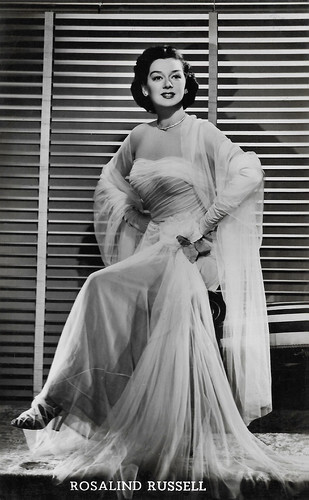
Dutch postcard by Van Leer's Fotodrukindustrie N.V., Amsterdam, no. 251. Photo: Columbia.

British Real Photograph postcard, no. 164. Photo: MGM (Metro-Goldwyn-Mayer Pictures).
Confident and modern-looking women who shine with wit, sarcasm and elegance
Catherine Rosalind Russell was born in 1907 in Waterbury, Connecticut. She was the daughter of James Edward Russell, a lawyer, and Clara A. Russell, a fashion consultant and she had seven siblings. She attended a Catholic school and studied drama in college.
Russell began acting in films in 1934 for MGM. In the following period, she landed major supporting and leading roles, including in King Vidor's The Citadel with Robert Donat and in George Cukor's all-female comedy The Women.
She became a star with the screwball comedy His Girl Friday (Howard Hawks, 1940). Through her co-star, Cary Grant, she met her future husband, Grant's house guest at the time, Danish-American producer Frederick Brisson (1912-1984), the son of actor Carl Brisson . In 1941, they married and Grant was the best man at their wedding.
Her talent lay in light comedies, where she usually embodied confident and modern-looking women who shone with wit, sarcasm and elegance. She was often seen as a businesswoman who falls in love with her male secretary, as in Take a Letter, Darling (Mitchell Leisen, 1942) with Fred MacMurray , or as a woman with her own ideas, as in Roughly Speaking (Michael Curtiz, 1945) with Jack Carson.
From the middle of the decade, she worked without a fixed studio contract and now appeared more often in dramatic roles. For her performances in the film biography Sister Kenny (Dudley Nichols, 1946) about the Australian nurse Elizabeth Kenny and in the Eugene O'Neill adaptation Mourning Becomes Electra (Dudley Nichols, 1947) opposite Michael Redgrave , she won the Golden Globe Award in the category Best Actress in a Leading Role - Drama. Nevertheless, both films flopped at the box office.
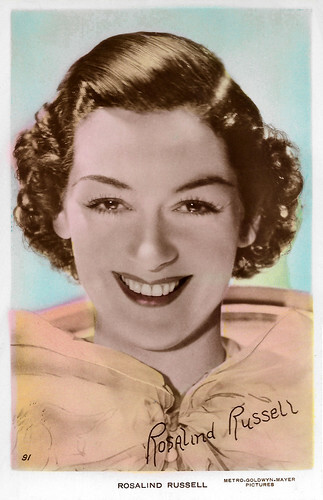
British Real Photograph postcard by Art Photo Postcard, no. 81. Photo: MGM (Metro-Goldwyn-Mayer Pictures).
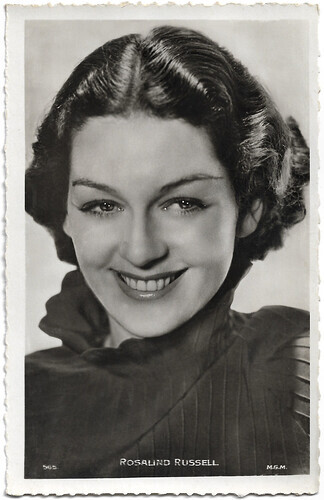
French postcard by Editions E.C., Paris, no. 565. Photo: MGM.
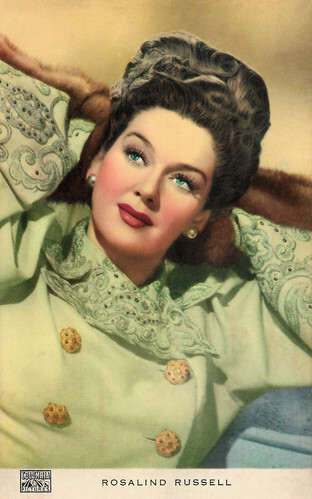
Italian postcard by C.C.M., no. 1. Photo: Columbia Pictures.
Great popularity on Broadway
In 1953, Rosalind Russell also started acting on Broadway. She toured with 'Bell, Book and Candle' in 1951 and won a Tony Award for 'Wonderful Town' in 1953. The musical was based on the same source as her film My Sister Eileen (Alexander Hall, 1942), for which she received an Oscar nomination playing the same character. She concentrated on character roles and appeared in several successful theatre productions. She achieved great popularity with the comedy 'The Great Aunt' and was nominated for a Tony Award. She reprised the role in the film adaptation, Auntie Mame (Morton DaCosta, 1958), earning another Oscar nomination and winning a Golden Globe Award for her performance.
Another successful performance in her late film career was Rosemary in Picnic (Joshua Logan, 1955) alongside William Holden and Kim Novak . Ed Stephan at IMDb writes that "Columbia, worried the public would think she had the female lead in Picnic (1955), billed her 'co-starring Rosalind Russell as Rosemarie'. She refused to be placed in the Best Supporting Actress category when the studio wanted to promote her for an Academy Award nomination for her role in Picnic (1955). Many felt she would have won had she cooperated.
Another hit was her role as the ambitious Mama Rose, mother of famed stripper Gypsy Rose Lee, in Gypsy (Mervyn LeRoy, 1962), the film adaptation of the musical 'Gypsy: A Musical Fable'. The film, with Natalie Wood in the title role, was distributed in 1962 and was a great commercial success.
Rosalind Russell also starred in several film flops such as Five Fingers Exercise (Daniel Mann, 1962) or Oh Dad, Poor Dad, Mama's Hung You in the Closet and I'm Feeling So Sad (Richard Quine, 1967).
She had to retire from acting in the early 1970s because of arthritis. In 1972, she received the Jean Hersholt Humanitarian Award for contributions to charity. Her marriage with Frederick Brisson lasted until her death and the couple had their son Carl Lance in 1943. Rosalind Russell died at the age of 69 of breast cancer. She was interred at Holy Cross Cemetery in Culver City, California.
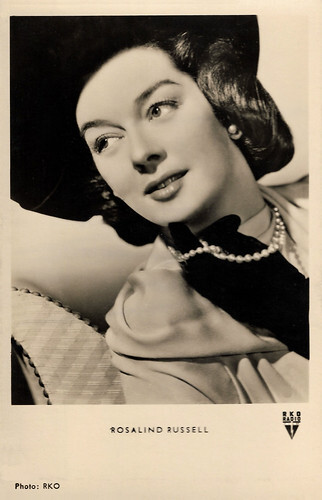
West-German postcard by Kunst und Bild, Berlin, no. A 179. Photo: RKO.
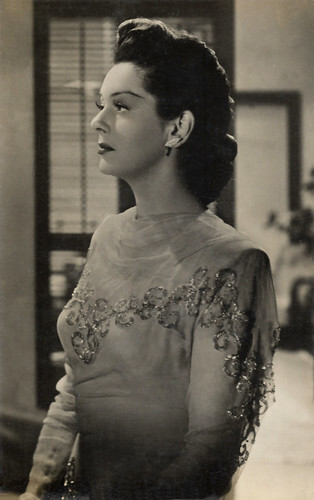
Spanish postcard by JDP, Valencia, no. 1.029.
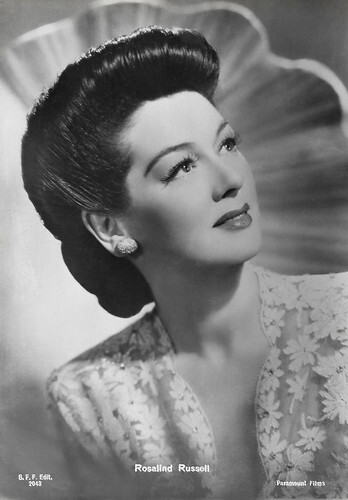
Italian postcard by B.F.F. Edit, no. 2043. Photo: Paramount Films.
Sources: (IMDb), Wikipedia (Dutch and German), and .

British postcard in the Picturegoer Series, London, no. W 15. Photo: Warner Bros.

Dutch postcard by Van Leer's Fotodrukindustrie N.V., Amsterdam, no. 251. Photo: Columbia.

British Real Photograph postcard, no. 164. Photo: MGM (Metro-Goldwyn-Mayer Pictures).
Confident and modern-looking women who shine with wit, sarcasm and elegance
Catherine Rosalind Russell was born in 1907 in Waterbury, Connecticut. She was the daughter of James Edward Russell, a lawyer, and Clara A. Russell, a fashion consultant and she had seven siblings. She attended a Catholic school and studied drama in college.
Russell began acting in films in 1934 for MGM. In the following period, she landed major supporting and leading roles, including in King Vidor's The Citadel with Robert Donat and in George Cukor's all-female comedy The Women.
She became a star with the screwball comedy His Girl Friday (Howard Hawks, 1940). Through her co-star, Cary Grant, she met her future husband, Grant's house guest at the time, Danish-American producer Frederick Brisson (1912-1984), the son of actor Carl Brisson . In 1941, they married and Grant was the best man at their wedding.
Her talent lay in light comedies, where she usually embodied confident and modern-looking women who shone with wit, sarcasm and elegance. She was often seen as a businesswoman who falls in love with her male secretary, as in Take a Letter, Darling (Mitchell Leisen, 1942) with Fred MacMurray , or as a woman with her own ideas, as in Roughly Speaking (Michael Curtiz, 1945) with Jack Carson.
From the middle of the decade, she worked without a fixed studio contract and now appeared more often in dramatic roles. For her performances in the film biography Sister Kenny (Dudley Nichols, 1946) about the Australian nurse Elizabeth Kenny and in the Eugene O'Neill adaptation Mourning Becomes Electra (Dudley Nichols, 1947) opposite Michael Redgrave , she won the Golden Globe Award in the category Best Actress in a Leading Role - Drama. Nevertheless, both films flopped at the box office.

British Real Photograph postcard by Art Photo Postcard, no. 81. Photo: MGM (Metro-Goldwyn-Mayer Pictures).

French postcard by Editions E.C., Paris, no. 565. Photo: MGM.

Italian postcard by C.C.M., no. 1. Photo: Columbia Pictures.
Great popularity on Broadway
In 1953, Rosalind Russell also started acting on Broadway. She toured with 'Bell, Book and Candle' in 1951 and won a Tony Award for 'Wonderful Town' in 1953. The musical was based on the same source as her film My Sister Eileen (Alexander Hall, 1942), for which she received an Oscar nomination playing the same character. She concentrated on character roles and appeared in several successful theatre productions. She achieved great popularity with the comedy 'The Great Aunt' and was nominated for a Tony Award. She reprised the role in the film adaptation, Auntie Mame (Morton DaCosta, 1958), earning another Oscar nomination and winning a Golden Globe Award for her performance.
Another successful performance in her late film career was Rosemary in Picnic (Joshua Logan, 1955) alongside William Holden and Kim Novak . Ed Stephan at IMDb writes that "Columbia, worried the public would think she had the female lead in Picnic (1955), billed her 'co-starring Rosalind Russell as Rosemarie'. She refused to be placed in the Best Supporting Actress category when the studio wanted to promote her for an Academy Award nomination for her role in Picnic (1955). Many felt she would have won had she cooperated.
Another hit was her role as the ambitious Mama Rose, mother of famed stripper Gypsy Rose Lee, in Gypsy (Mervyn LeRoy, 1962), the film adaptation of the musical 'Gypsy: A Musical Fable'. The film, with Natalie Wood in the title role, was distributed in 1962 and was a great commercial success.
Rosalind Russell also starred in several film flops such as Five Fingers Exercise (Daniel Mann, 1962) or Oh Dad, Poor Dad, Mama's Hung You in the Closet and I'm Feeling So Sad (Richard Quine, 1967).
She had to retire from acting in the early 1970s because of arthritis. In 1972, she received the Jean Hersholt Humanitarian Award for contributions to charity. Her marriage with Frederick Brisson lasted until her death and the couple had their son Carl Lance in 1943. Rosalind Russell died at the age of 69 of breast cancer. She was interred at Holy Cross Cemetery in Culver City, California.

West-German postcard by Kunst und Bild, Berlin, no. A 179. Photo: RKO.

Spanish postcard by JDP, Valencia, no. 1.029.

Italian postcard by B.F.F. Edit, no. 2043. Photo: Paramount Films.
Sources: (IMDb), Wikipedia (Dutch and German), and .
Published on September 08, 2022 22:00
September 7, 2022
Michel Simon
Swiss actor Michel Simon (1895-1975) was a popular and beloved star of the French cinema and stage. His larger-than-life personality, impeccable comic timing and great repertoire were seen in more than 100 films. He started his film career during the silent period and starred in classic masterpieces by Carl Theodor Dreyer, Jean Vigo, Marcel Carné and Jean Renoir.
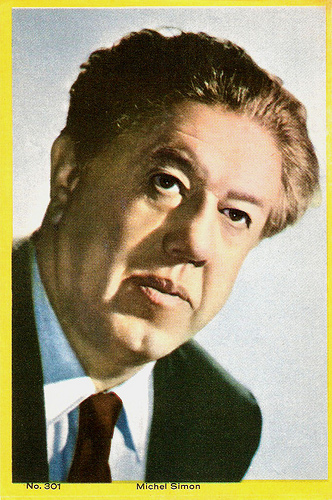
Mexican card, no. 301.
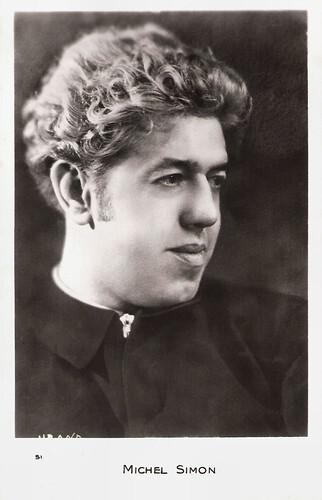
French postcard, no. 51. Photo: Hrand.
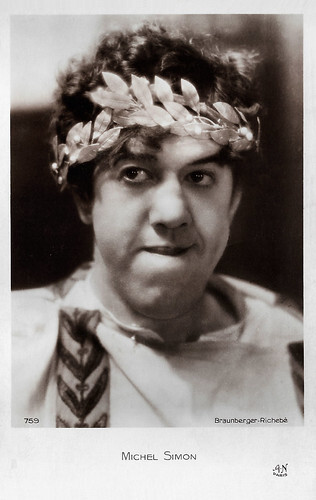
French postcard by A.N., Paris, no. 759. Photo: Braunberger-Richebé Michel Simon in Baleydier (Jean Mamy, 1932).
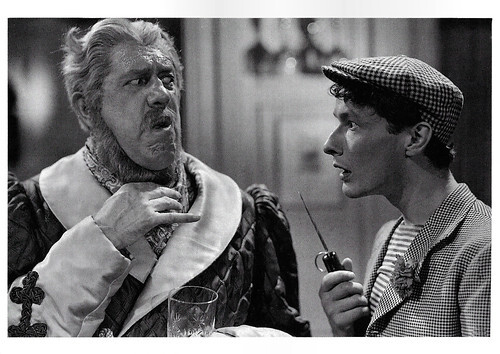
Swiss-German-British postcard by News Productions, Baulmes / Filmwelt Berlin, Bakede / News Productions, Stroud, no. 56510. Photo: Collection Cinémathèque Suisse, Lausanne. Michel Simon and Jean-Louis Barrault in Drôle de Drame/Bizarre, Bizarre (Marcel Carné, 1937), produced by Comiglion-Molinier.
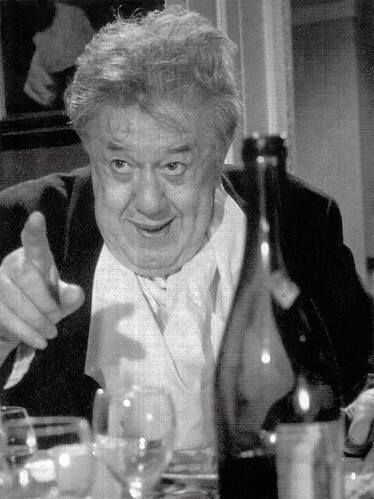
German promotion card. Michel Simon in Le diable et les 10 commandements/The Devil and the Ten Commandments (Julien Duvivier, 1962).
General Insubordination
François Michel Simon was born in Geneva, Switzerland in 1895. He used to say about himself that "as misfortune never comes singly, cinema was born the same year". He was the son of a Protestant sausage maker.
Simon drifted through his early years as a boxer, commercial photographer and acrobat. In 1912 he was a magician, clown and acrobat stooge in a dancers' show called Ribert's and Simon's, in the Montreuil-sous-Bois Casino. Conscripted into the Swiss Army in 1914, he was thrown out through a combination of tuberculosis and general insubordination.
In 1915, he saw Georges Pitoëff acting in Hedda Gabler, at the Theatre de la Comédie of Geneva. He then decided to become an actor too but had to wait until 1920 before making his first brief appearance on stage, with Pitoëff's company, speaking three lines for the registrar role in William Shakespeare's Measure for Measure.
He was spotted for the first time in a supporting role in George Bernard Shaw's Androcles and the Lion. In 1922, his company moved to Paris at the Comédie des Champs-Élysées.
He quit the following year to become a light comedy actor in plays by Tristan Bernard, Marcel Achard and Yves Mirande. Marcel Achard presented him to Charles Dullin , in whose company he acted in Je ne vous aime pas (I Don't Love You) with Valentine Tessier.
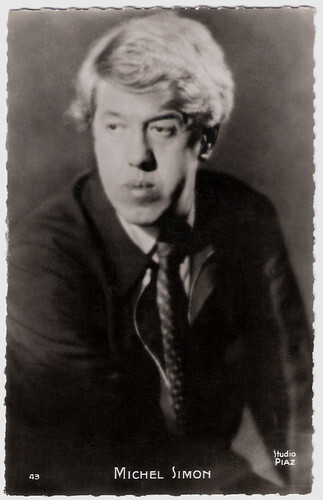
French postcard by Editions P.I., Paris, no. 43. Photo: Studio Piaz.
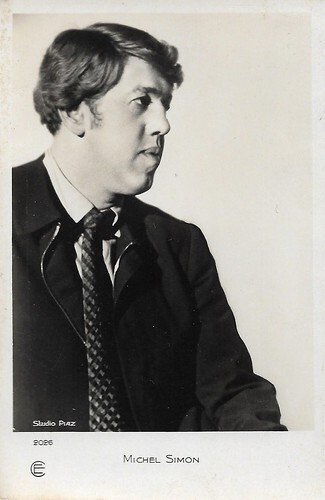
French postcard by Cinémagazine-Edition, no. 2026. Photo: Studio Piaz.
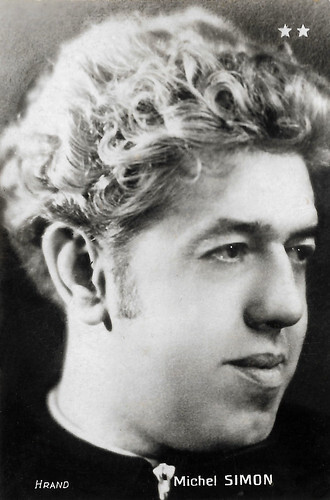
French collectors card. Photo: Hrand.
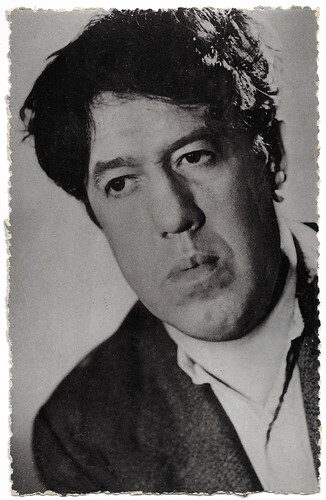
Belgian postcard by Kwatta. Photo: Filmsonor.
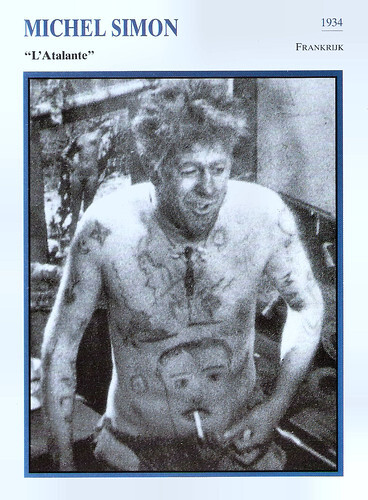
Dutch collectors card in the series 'Filmsterren: een Portret' by Edito-Service, 1994. Photo: Ciné Plus. Michel Simon in L'Atalante (Jean Vigo, 1934).
Unusual face
Louis Jouvet , who had meanwhile replaced Pitoëff, hired Michel Simon at the Comédie des Champs-Élysées. Simon then gave a brilliant performance in Jean de la Lune, a play by Marcel Achard. His inimitable talent transformed his Cloclo supporting role into the big attraction of the play.
His theatrical career then blossomed with a large repertoire: Shakespeare, George Bernard Shaw, Luigi Pirandello, Oscar Wilde, Henri Bernstein, but it was the film that made him most popular.
One of his first film appearances was as Pomino opposite Ivan Mozzhukhin in Feu Mathias Pascal/The Late Mathias Pascal (1925), based on the novel by Luigi Pirandello and directed by Marcel L'Herbier.
Very soon after, he appeared in La vocation d'André Carel/The Vocation of André Carel (Jean Choux, 1925) with Blanche Montel . The film used small-scale production methods, just as the Nouvelle Vague would do from 1958 on.
Essentially a theatre performer throughout the 1920s, Simon occasionally appeared in small film roles, notably in Casanova (Alexandre Volkoff, 1927) and as Jean LeMaitre in La Passion de Jeanne d'Arc/The Passion of Joan of Arc (Carl Theodor Dreyer, 1928).
In these silent films, he brought his amazing appearance and his unusual face - a talent with exceptional mobility, but truly without mannerism. He easily played with his body using an unlimited virtuosity, especially his ugliness, evolving from smartness to sympathy, goodness to naivety, ludicrousness to frightening, stupidity to comical, mischievousness to cruelty.
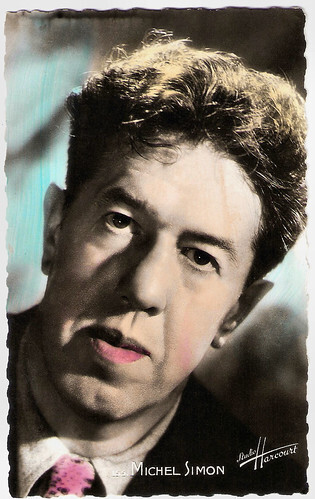
French postcard by S.E.R.P., Paris, no. 155. Photo: Studio Harcourt.
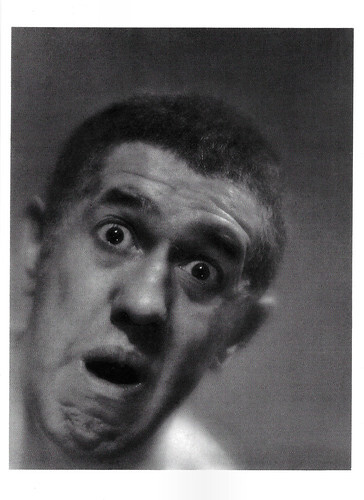
Swiss-German-British postcard by News Productions, Baulmes / Filmwelt Berlin, Bakede / News Productions, Stroud, no. 56507. Photo: Collection Cinémathèque Suisse, Lausanne. Michel Simon in Le Mort en Fuite/The Fleeing Dead (André Berthomieu, 1936), produced by Société des Films Roger Richebé.
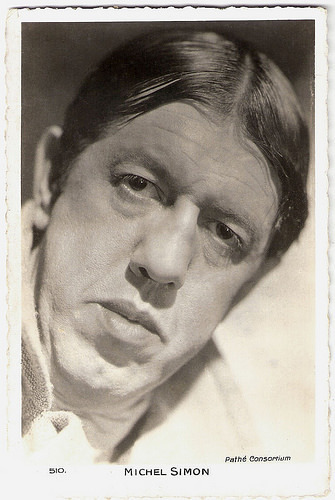
French postcard by Ed. Chantal, Paris, no. 510. Photo: Pathé Consortium.
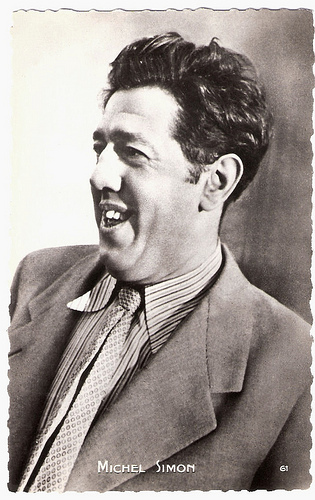
French postcard by Editions P.I., Paris, no. 61. Offered by Les Carbones Korès 'Carboplane'.
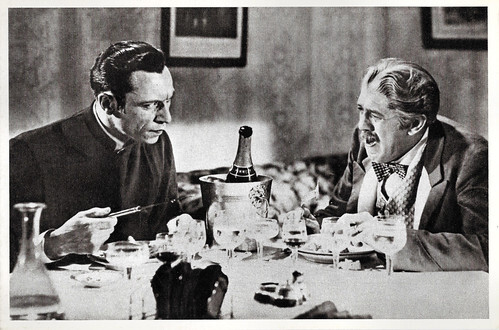
French postcard by Editions La Malibran, Paris, no. CF 1.Photo: Schüfftan / Page / Alekan. Louis Jouvet and Michel Simon in Drôle de Drame/Bizarre, Bizarre (Marcel Carné, 1937).
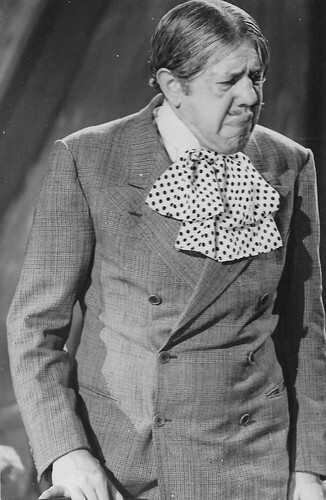
Photo. Michel Simon as Count Édouard de Bourgogne, nicknamed "l'Escargot" (the snail), in the film melodrama Le Ruisseau/The Stream (Maurice Lehmann, Claude Autant-Lara (uncredited), 1938), scripted by Jean Aurenche after the play by Pierre Wolff.
Outstanding character actor
With the coming of sound film, Michel Simon became firmly established as one of France's outstanding character actors. Full film stardom came his way when, in 1931, Simon starred in the film version of his great stage success Jean De La Lune/Moon-Struck Jean (Jean Choux, 1931) with Madeleine Renaud . People remarked that his elocution and voice tone were as original as his appearance and play.
As Hal Erickson at AllMovie writes: “His screen performances of the 1930s remain fresh and alive even after six decades, largely due to Simon's sudden spurts of improvisation”. Especially his roles in the films directed by Jean Renoir , such as the bitter and highly controversial psychological drama La Chienne/The Bitch (1931), the comedy On Purge Bebé/We Purge Baby (1932) and Boudu Sauvé Des Eaux/Boudu Saved From Drowning (1932). The latter was remade in Hollywood as Down and Out in Beverly Hills (1986, Paul Mazursky) with Nick Nolte in the Michel Simon role, Richard Dreyfuss and Bette Midler.
Hal Erickson continues: “Renoir has credited the actor with introducing the ‘improv’ technique to French filmmaking. Capable of harnessing his rocky-road face, bulky body and shambling manner for the purposes of menace as well as mirth, Simon proved a fearsome creature in Jean Vigo's last film, L'Atlante (1934) opposite lovely Dita Parlo .”
It is probably for his role as Père Jules in L’Atalante that he will be best known: the slightly roguish, ageing barge-man with a heart of gold. He went on to work with another great director, Marcel Carné, on the comedy-farce Drôle de Drame/Bizarre, Bizarre (Marcel Carné, 1937) with Louis Jouvet , and the romantic drama Le Quai des Brumes/Port of Shadows (Marcel Carné, 1938) with Jean Gabin .
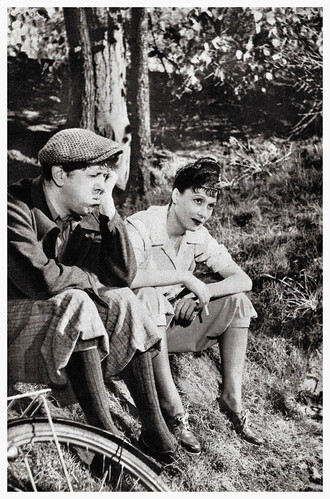
French postcard by Editions Le Malibran, Paris / Saint-Dié, no. CF 11. Michel Simon and Arletty in Fric-Frac/Break-In (Maurice Lehmann, Claude Autant-Lara (uncredited), 1939).
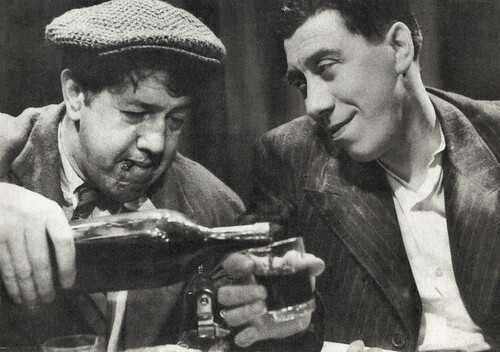
French postcard in the Collection Cinéma by Editions Le Malibran, Paris / Nancy, no. CF 51. Michel Simon and Fernandel in Fric-Frac/Break-In (Maurice Lehmann, Claude Autant-Lara (uncredited), 1939).
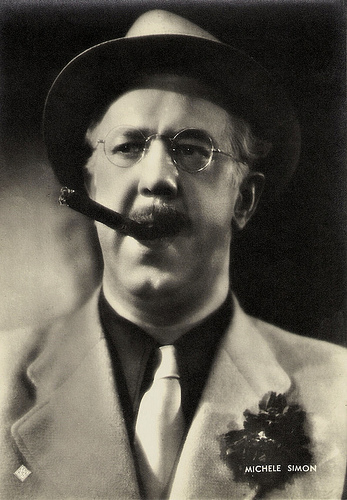
Italian postcard by ASER (A. Scarmiglia Ed. Roma). Photo: Pesce. Publicity still for La comédie du Bonheur/Comedy of Happiness (Marcel L'Herbier, 1940).
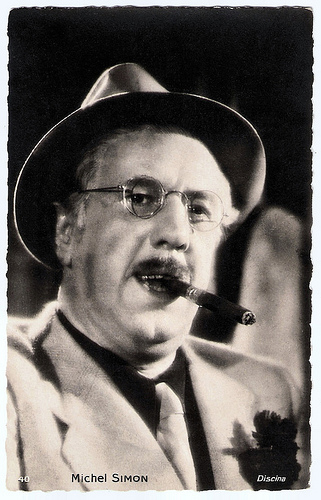
French postcard by Ed. Chantal, Rueil, no. 40. Photo: Discina. Publicity still for La comédie du Bonheur/Comedy of Happiness (Marcel L'Herbier, 1940).
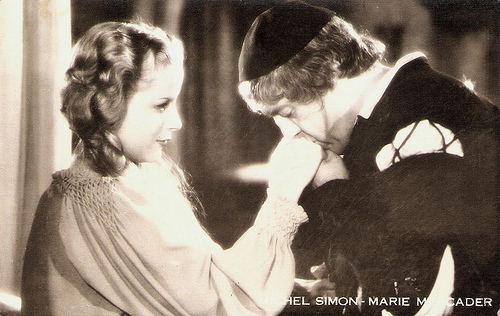
Italian postcard. Photo: publicity still of Maria Mercader and Michel Simon in Il re si diverte/The King's Jester (Mario Bonnard, 1941).
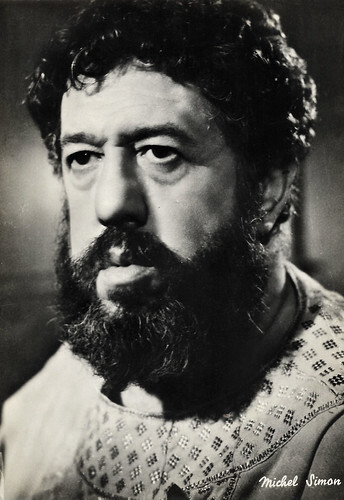
French postcard by Rotalfoto, Milano / Ediz. Garami, no. 131.
Faust and Mephistopheles
Michel Simon later also worked with such other A-list directors as Julien Duvivier at La Fin du Jour/The End of the Day (1939) and Panique/Panic (1946), and René Clair, appearing in the latter's La Beauté du Diable/Beauty and the Devil (1950) opposite Gérard Philipe as both Faust and Mephistopheles.
In 1957, Simon's film career nearly came to an abrupt end when he suffered facial and body paralysis as a by-product of an impure makeup dye. Despite his reduced physical mobility, he painstakingly made a comeback.
Hal Erickson: “Having been forced into minor parts for several years by a debilitating illness, veteran film actor Michel Simon made a triumphant return to leading roles in the charming, poignant Le Vieil Homme et L'Enfant/The Two of Us (Claude Berri, 1967).” That year, he won the Silver Bear for Best Actor at the 17th Berlin International Film Festival for his penetrating portrayal of an anti-Semitic French peasant in this beautiful film.
After that he made a few more films, including Walerian Borowczyk's Blanche (1971), a tragic romantic tale set in 13th century France, and his final film the crime drama L'Ibis Rouge/The Red Ibis (Jean-Pierre Mocky, 1975).
All reports indicate that Michel Simon conducted his private life in the manner of one of his gross, eccentric film characters: he lived alone on a huge country estate, sharing space with a pet parrot and four apes.
Michel Simon died in 1975 in Bry-sur-Marne, France, from a pulmonary embolism. His latest companion was the German artist Margarethe Krieger. The actor François Simon (1917) is his son.
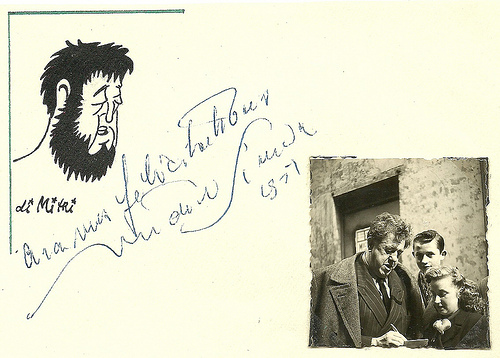
Photo with dedication. Collection: Didier Hanson.
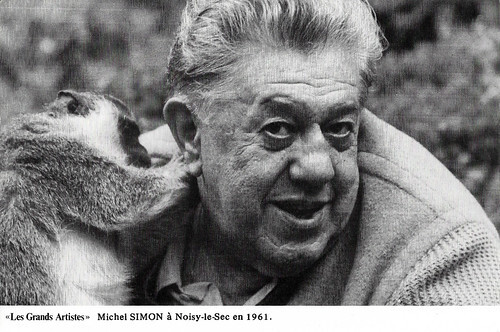
French postcard by Editions SEPPMG, Paris, in the 'Les Grands Artistes' series, Série 1 G, no. 104. Caption: Michel Simon in Noisy-le-Sec in 1961.
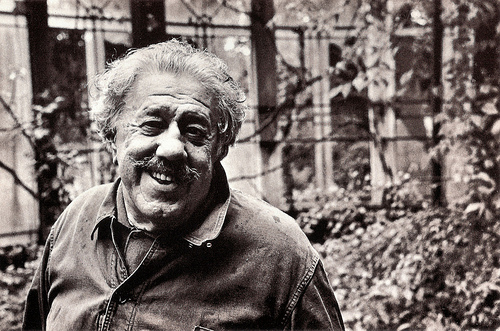
French postcard by OPSIS, Paris, no. C 7 - Personalités du XXe siècle. Photo: J. Mounicq.
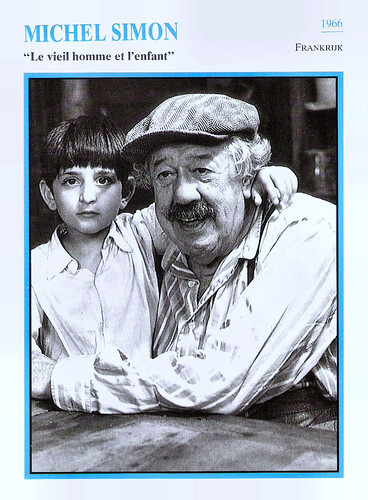
Dutch collectors card in the series 'Filmsterren: een Portret' by Edito-Service, 1994. Photo: Collection La Cinémathèque française. Michel Simon and Alain Cohen in Le vieil homme et l'enfant/The Two of Us (Claude Berri, 1967).
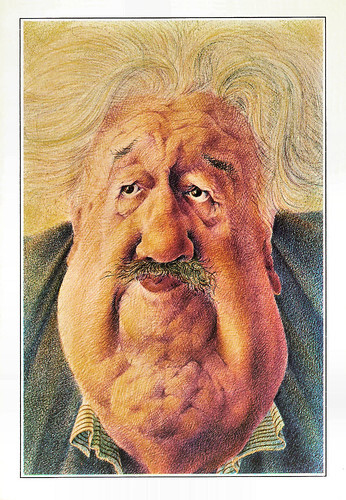
French postcard in the Les Grandes Gueules series by Dervish International Publications, Paris, no. 104. Drawing from the albums 'Les Grandes Gueules' by Ricord - Mulatier - Morchoisne.
Sources: Hal Erickson (AllMovie), (IMDb), Les Amis de Michel Simon (French), Wikipedia and .

Mexican card, no. 301.

French postcard, no. 51. Photo: Hrand.

French postcard by A.N., Paris, no. 759. Photo: Braunberger-Richebé Michel Simon in Baleydier (Jean Mamy, 1932).

Swiss-German-British postcard by News Productions, Baulmes / Filmwelt Berlin, Bakede / News Productions, Stroud, no. 56510. Photo: Collection Cinémathèque Suisse, Lausanne. Michel Simon and Jean-Louis Barrault in Drôle de Drame/Bizarre, Bizarre (Marcel Carné, 1937), produced by Comiglion-Molinier.

German promotion card. Michel Simon in Le diable et les 10 commandements/The Devil and the Ten Commandments (Julien Duvivier, 1962).
General Insubordination
François Michel Simon was born in Geneva, Switzerland in 1895. He used to say about himself that "as misfortune never comes singly, cinema was born the same year". He was the son of a Protestant sausage maker.
Simon drifted through his early years as a boxer, commercial photographer and acrobat. In 1912 he was a magician, clown and acrobat stooge in a dancers' show called Ribert's and Simon's, in the Montreuil-sous-Bois Casino. Conscripted into the Swiss Army in 1914, he was thrown out through a combination of tuberculosis and general insubordination.
In 1915, he saw Georges Pitoëff acting in Hedda Gabler, at the Theatre de la Comédie of Geneva. He then decided to become an actor too but had to wait until 1920 before making his first brief appearance on stage, with Pitoëff's company, speaking three lines for the registrar role in William Shakespeare's Measure for Measure.
He was spotted for the first time in a supporting role in George Bernard Shaw's Androcles and the Lion. In 1922, his company moved to Paris at the Comédie des Champs-Élysées.
He quit the following year to become a light comedy actor in plays by Tristan Bernard, Marcel Achard and Yves Mirande. Marcel Achard presented him to Charles Dullin , in whose company he acted in Je ne vous aime pas (I Don't Love You) with Valentine Tessier.

French postcard by Editions P.I., Paris, no. 43. Photo: Studio Piaz.

French postcard by Cinémagazine-Edition, no. 2026. Photo: Studio Piaz.

French collectors card. Photo: Hrand.

Belgian postcard by Kwatta. Photo: Filmsonor.

Dutch collectors card in the series 'Filmsterren: een Portret' by Edito-Service, 1994. Photo: Ciné Plus. Michel Simon in L'Atalante (Jean Vigo, 1934).
Unusual face
Louis Jouvet , who had meanwhile replaced Pitoëff, hired Michel Simon at the Comédie des Champs-Élysées. Simon then gave a brilliant performance in Jean de la Lune, a play by Marcel Achard. His inimitable talent transformed his Cloclo supporting role into the big attraction of the play.
His theatrical career then blossomed with a large repertoire: Shakespeare, George Bernard Shaw, Luigi Pirandello, Oscar Wilde, Henri Bernstein, but it was the film that made him most popular.
One of his first film appearances was as Pomino opposite Ivan Mozzhukhin in Feu Mathias Pascal/The Late Mathias Pascal (1925), based on the novel by Luigi Pirandello and directed by Marcel L'Herbier.
Very soon after, he appeared in La vocation d'André Carel/The Vocation of André Carel (Jean Choux, 1925) with Blanche Montel . The film used small-scale production methods, just as the Nouvelle Vague would do from 1958 on.
Essentially a theatre performer throughout the 1920s, Simon occasionally appeared in small film roles, notably in Casanova (Alexandre Volkoff, 1927) and as Jean LeMaitre in La Passion de Jeanne d'Arc/The Passion of Joan of Arc (Carl Theodor Dreyer, 1928).
In these silent films, he brought his amazing appearance and his unusual face - a talent with exceptional mobility, but truly without mannerism. He easily played with his body using an unlimited virtuosity, especially his ugliness, evolving from smartness to sympathy, goodness to naivety, ludicrousness to frightening, stupidity to comical, mischievousness to cruelty.

French postcard by S.E.R.P., Paris, no. 155. Photo: Studio Harcourt.

Swiss-German-British postcard by News Productions, Baulmes / Filmwelt Berlin, Bakede / News Productions, Stroud, no. 56507. Photo: Collection Cinémathèque Suisse, Lausanne. Michel Simon in Le Mort en Fuite/The Fleeing Dead (André Berthomieu, 1936), produced by Société des Films Roger Richebé.

French postcard by Ed. Chantal, Paris, no. 510. Photo: Pathé Consortium.

French postcard by Editions P.I., Paris, no. 61. Offered by Les Carbones Korès 'Carboplane'.

French postcard by Editions La Malibran, Paris, no. CF 1.Photo: Schüfftan / Page / Alekan. Louis Jouvet and Michel Simon in Drôle de Drame/Bizarre, Bizarre (Marcel Carné, 1937).

Photo. Michel Simon as Count Édouard de Bourgogne, nicknamed "l'Escargot" (the snail), in the film melodrama Le Ruisseau/The Stream (Maurice Lehmann, Claude Autant-Lara (uncredited), 1938), scripted by Jean Aurenche after the play by Pierre Wolff.
Outstanding character actor
With the coming of sound film, Michel Simon became firmly established as one of France's outstanding character actors. Full film stardom came his way when, in 1931, Simon starred in the film version of his great stage success Jean De La Lune/Moon-Struck Jean (Jean Choux, 1931) with Madeleine Renaud . People remarked that his elocution and voice tone were as original as his appearance and play.
As Hal Erickson at AllMovie writes: “His screen performances of the 1930s remain fresh and alive even after six decades, largely due to Simon's sudden spurts of improvisation”. Especially his roles in the films directed by Jean Renoir , such as the bitter and highly controversial psychological drama La Chienne/The Bitch (1931), the comedy On Purge Bebé/We Purge Baby (1932) and Boudu Sauvé Des Eaux/Boudu Saved From Drowning (1932). The latter was remade in Hollywood as Down and Out in Beverly Hills (1986, Paul Mazursky) with Nick Nolte in the Michel Simon role, Richard Dreyfuss and Bette Midler.
Hal Erickson continues: “Renoir has credited the actor with introducing the ‘improv’ technique to French filmmaking. Capable of harnessing his rocky-road face, bulky body and shambling manner for the purposes of menace as well as mirth, Simon proved a fearsome creature in Jean Vigo's last film, L'Atlante (1934) opposite lovely Dita Parlo .”
It is probably for his role as Père Jules in L’Atalante that he will be best known: the slightly roguish, ageing barge-man with a heart of gold. He went on to work with another great director, Marcel Carné, on the comedy-farce Drôle de Drame/Bizarre, Bizarre (Marcel Carné, 1937) with Louis Jouvet , and the romantic drama Le Quai des Brumes/Port of Shadows (Marcel Carné, 1938) with Jean Gabin .

French postcard by Editions Le Malibran, Paris / Saint-Dié, no. CF 11. Michel Simon and Arletty in Fric-Frac/Break-In (Maurice Lehmann, Claude Autant-Lara (uncredited), 1939).

French postcard in the Collection Cinéma by Editions Le Malibran, Paris / Nancy, no. CF 51. Michel Simon and Fernandel in Fric-Frac/Break-In (Maurice Lehmann, Claude Autant-Lara (uncredited), 1939).

Italian postcard by ASER (A. Scarmiglia Ed. Roma). Photo: Pesce. Publicity still for La comédie du Bonheur/Comedy of Happiness (Marcel L'Herbier, 1940).

French postcard by Ed. Chantal, Rueil, no. 40. Photo: Discina. Publicity still for La comédie du Bonheur/Comedy of Happiness (Marcel L'Herbier, 1940).

Italian postcard. Photo: publicity still of Maria Mercader and Michel Simon in Il re si diverte/The King's Jester (Mario Bonnard, 1941).

French postcard by Rotalfoto, Milano / Ediz. Garami, no. 131.
Faust and Mephistopheles
Michel Simon later also worked with such other A-list directors as Julien Duvivier at La Fin du Jour/The End of the Day (1939) and Panique/Panic (1946), and René Clair, appearing in the latter's La Beauté du Diable/Beauty and the Devil (1950) opposite Gérard Philipe as both Faust and Mephistopheles.
In 1957, Simon's film career nearly came to an abrupt end when he suffered facial and body paralysis as a by-product of an impure makeup dye. Despite his reduced physical mobility, he painstakingly made a comeback.
Hal Erickson: “Having been forced into minor parts for several years by a debilitating illness, veteran film actor Michel Simon made a triumphant return to leading roles in the charming, poignant Le Vieil Homme et L'Enfant/The Two of Us (Claude Berri, 1967).” That year, he won the Silver Bear for Best Actor at the 17th Berlin International Film Festival for his penetrating portrayal of an anti-Semitic French peasant in this beautiful film.
After that he made a few more films, including Walerian Borowczyk's Blanche (1971), a tragic romantic tale set in 13th century France, and his final film the crime drama L'Ibis Rouge/The Red Ibis (Jean-Pierre Mocky, 1975).
All reports indicate that Michel Simon conducted his private life in the manner of one of his gross, eccentric film characters: he lived alone on a huge country estate, sharing space with a pet parrot and four apes.
Michel Simon died in 1975 in Bry-sur-Marne, France, from a pulmonary embolism. His latest companion was the German artist Margarethe Krieger. The actor François Simon (1917) is his son.

Photo with dedication. Collection: Didier Hanson.

French postcard by Editions SEPPMG, Paris, in the 'Les Grands Artistes' series, Série 1 G, no. 104. Caption: Michel Simon in Noisy-le-Sec in 1961.

French postcard by OPSIS, Paris, no. C 7 - Personalités du XXe siècle. Photo: J. Mounicq.

Dutch collectors card in the series 'Filmsterren: een Portret' by Edito-Service, 1994. Photo: Collection La Cinémathèque française. Michel Simon and Alain Cohen in Le vieil homme et l'enfant/The Two of Us (Claude Berri, 1967).

French postcard in the Les Grandes Gueules series by Dervish International Publications, Paris, no. 104. Drawing from the albums 'Les Grandes Gueules' by Ricord - Mulatier - Morchoisne.
Sources: Hal Erickson (AllMovie), (IMDb), Les Amis de Michel Simon (French), Wikipedia and .
Published on September 07, 2022 22:00
September 6, 2022
Gunther Philipp
Austrian film actor Gunther Philipp (1918-2003) appeared in 147 mostly German films and TV productions, mainly in comic roles. Philipp also wrote 21 film scripts and was a physician, a successful swimmer and winner of three Austrian national championship titles, a racecar driver and the founder of a racing team.
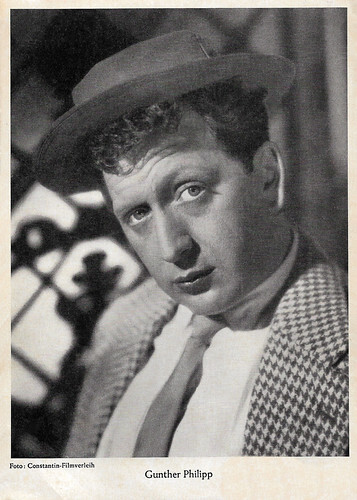
German card. Photo: Constantin-Filmverleih.
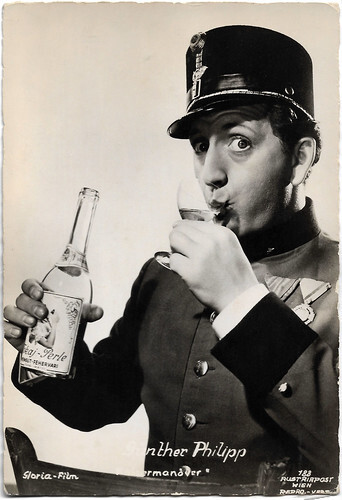
Austrian postcard by Austriapost, Wien, no. 188. Photo: Gloria-Film. Gunther Philipp in Kaisermanöver/Imperial Manoeuvres (Franz Antel, 1954).
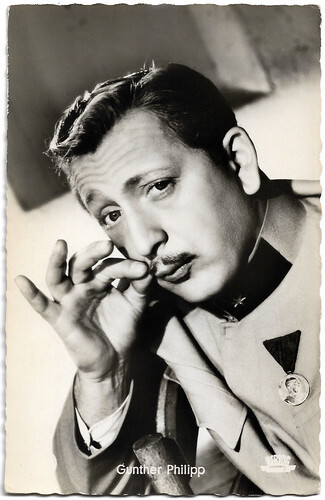
West-German postcard by Kolibri-Verlag G.m.b.H, Minden-Westf, no. 2337. Photo: Sascha / Herzog / Michaelis. Gunther Philipp in Kaiserjäger/Emperor Hunter (Willi Forst, 1956).
All kinds of silly or affectatious men
Gunther Philipp was born Gunter Placheta in 1918 in Maroshévíz, Austria-Hungary (now Toplița, Romania) where his father was stationed as a soldier during the First World War. His parents were the later veterinarian Hugo Placheta and his wife Therese. Soon after his birth, the family returned to their home town of Vienna.
Philipp received his schooling in Vienna and in Innsbruck. He was a successful swimmer and held the Austrian record in the 100-meter breaststroke for 14 years. He was also in the squad of the Austrian Olympic team in Berlin in 1936 but was not nominated for political reasons because he did not want to join the National Socialist-dominated 'Erste Wiener Amateur Sport Club' (First Vienna Amateur Sports Club).
During World War II, Philipp studied at the University of Vienna philosophy, majoring in psychology and then medicine. In 1943, he completed his thesis during his military service in a military hospital. After the war, he ran a practice in Eberstalzell in Upper Austria and was active until the 1990s at the Vienna University Clinic for Neurology and Psychiatry.
One of his patients in 1946 was the actress Paula Wessely . During the Second World War, Günther Philipp also studied acting at the Max Reinhardt Seminar. In 1946, together with Peter Wehle and Fred Kraus, he founded the cabaret group 'Die kleinen Vier'.
In 1949, Günther Philipp made his big screen debut in the film Märchen vom Glück/Kiss Me Casanova (Arthur De Glahs, 1949) starring O.W. Fischer and Maria Holst . At the end of 1949, he gave up being a doctor and worked mainly as an actor or presenter. He became known for his roles in comic films such as Kleiner Schwindel am Wolfgangsee/A little swindle at Lake Wolfgang (Franz Antel, 1949) with Hans Holt and Tante Jutta aus Kalkutta/Aunt Jutta from Calcutta (Karl Georg Külb, 1953). He portrayed all kinds of silly or affectatious men from aristocrats to obsequious servants.
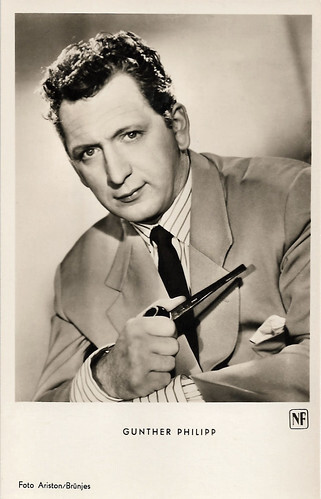
German postcard by Kunst und Bild, Berlin, no. A 864. Photo: Ariston / Brünjes / NF. Gunther Philipp in Tante Jutta aus Kalkutta/Aunt Jutta from Calcutta (Karl Georg Külb, 1953).
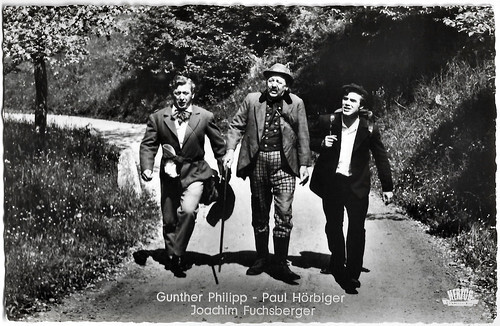
German postcard by Kolibri-Verlag G.m.b.H., Minden/Westf., no. 2047. Photo: Rhombus / Herzog-Film / Appelt. Gunther Philipp, Paul Hörbiger and Joachim Fuchsberger in Lumpazivagabundus (Franz Antel, 1956).
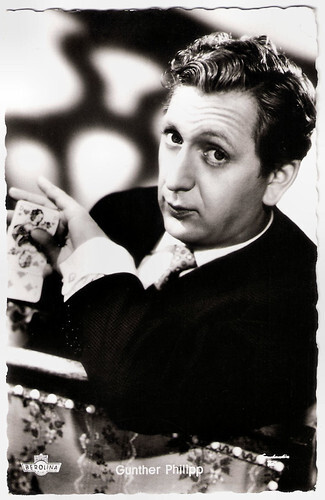
German postcard by Kolibri-Verlag G.m.b.H., Minden/Westf., no. 2327. Photo: Berolina / Constantin / Wesel. Gunther Philipp in Die Christel von der Post/Christel from the Post Office (Karl Anton, 1956).
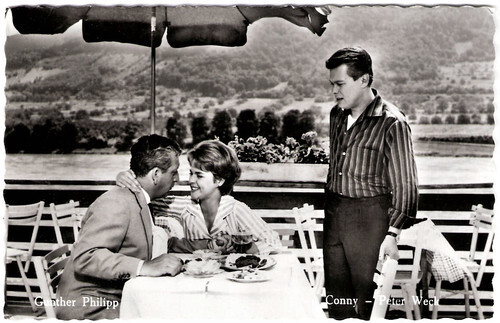
Dutch postcard by N.V. v.h. Weenenk & Snel, Baarn, no. 762. Photo: Gunther Philipp, Conny Froboess and Peter Weck in Mariandl (Werner Jacobs, 1961).
His own motorsport racing team
In the 1950s and 1960s, Gunther Philipp became one of the most popular and busiest German-speaking actors. He had roles in films such as Kaiserwalzer/The Emperor Waltz (1953), Kaisermanöver/Imperial Manoeuvres (Franz Antel, 1954) with Hans Moser , Kaiserjäger/Emperor Hunter (Willi Forst, 1956) and also in Ernst Marischka's Die Deutschmeister/A March for the Emperor (1955) with Romy Schneider .
Later, his popularity resulted in appearances in the musical Im weißen Rössl/The White Horse Inn (Werner Jacobs, 1960), and Mariandl (Werner Jacobs, 1961). His films with Peter Alexander such as Schwejk's Flegeljahre/Schweik's Awkward Years (Wolfgang Liebeneiner, 1964), he enriched with his specific comedy and became well-known. In total, he appeared in 147 film and television roles.
Along the way, he also wrote countless programmes for radio and 21 screenplays for films. He was also successful in the theatre. He maintained a strong interest in medical topics throughout his life and read the corresponding professional journals. In the 1950s, Philipp founded his own motorsport racing team Ecurie Vienne and competed in the Gran Turismo class. He became the Austrian national champion several times in the 1960s.
After the end of his active career, he co-hosted the TV programme Motorama with Jochen Rindt and after the latter's death, he hosted it alone. He was married four times and was the father of three sons, Peter (born 1943), Alexander (1967), and Gero (1983).
In 2003, Gunther Philipp died in a clinic in Bonn-Bad Godesberg after many years of illness at the age of 85. His grave is in the Melaten cemetery in Cologne, in the immediate vicinity of fellow actors Willy Birgel , René Deltgen as well as Gisela Uhlen , whose husband he had played in the popular TV series Forsthaus Falkenau until his death. After he had often shot films in the Wachau, a museum was set up for him there - in the Hotel Mariandl, the location of the film Der Hofrat Geiger in Spitz on the Danube in Lower Austria.

German postcard by Rüdel-Verlag, Hamburg-Bergedorf, no. 2022. Photo: Arca / Constantin / Grimm. Gunther Philipp in Das Mädchen ohne Pyjama/The Girl Without Pyjamas (Hans Quest, 1957).
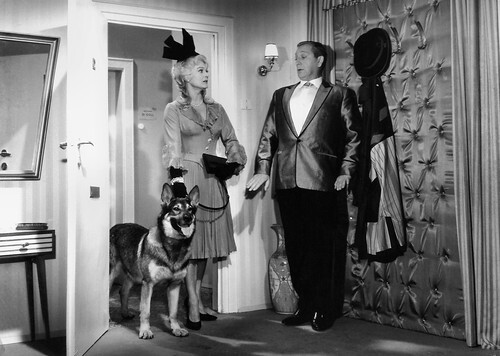
German press photo. Marika Rökk and Gunther Philipp in Hochzeitsnacht im Paradies/Wedding Night in Paradise (Paul Martin, 1962).
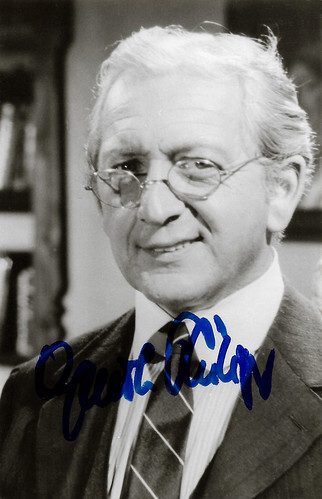
West-German autograph card.
Sources: Wikipedia (English and German), and .

German card. Photo: Constantin-Filmverleih.

Austrian postcard by Austriapost, Wien, no. 188. Photo: Gloria-Film. Gunther Philipp in Kaisermanöver/Imperial Manoeuvres (Franz Antel, 1954).

West-German postcard by Kolibri-Verlag G.m.b.H, Minden-Westf, no. 2337. Photo: Sascha / Herzog / Michaelis. Gunther Philipp in Kaiserjäger/Emperor Hunter (Willi Forst, 1956).
All kinds of silly or affectatious men
Gunther Philipp was born Gunter Placheta in 1918 in Maroshévíz, Austria-Hungary (now Toplița, Romania) where his father was stationed as a soldier during the First World War. His parents were the later veterinarian Hugo Placheta and his wife Therese. Soon after his birth, the family returned to their home town of Vienna.
Philipp received his schooling in Vienna and in Innsbruck. He was a successful swimmer and held the Austrian record in the 100-meter breaststroke for 14 years. He was also in the squad of the Austrian Olympic team in Berlin in 1936 but was not nominated for political reasons because he did not want to join the National Socialist-dominated 'Erste Wiener Amateur Sport Club' (First Vienna Amateur Sports Club).
During World War II, Philipp studied at the University of Vienna philosophy, majoring in psychology and then medicine. In 1943, he completed his thesis during his military service in a military hospital. After the war, he ran a practice in Eberstalzell in Upper Austria and was active until the 1990s at the Vienna University Clinic for Neurology and Psychiatry.
One of his patients in 1946 was the actress Paula Wessely . During the Second World War, Günther Philipp also studied acting at the Max Reinhardt Seminar. In 1946, together with Peter Wehle and Fred Kraus, he founded the cabaret group 'Die kleinen Vier'.
In 1949, Günther Philipp made his big screen debut in the film Märchen vom Glück/Kiss Me Casanova (Arthur De Glahs, 1949) starring O.W. Fischer and Maria Holst . At the end of 1949, he gave up being a doctor and worked mainly as an actor or presenter. He became known for his roles in comic films such as Kleiner Schwindel am Wolfgangsee/A little swindle at Lake Wolfgang (Franz Antel, 1949) with Hans Holt and Tante Jutta aus Kalkutta/Aunt Jutta from Calcutta (Karl Georg Külb, 1953). He portrayed all kinds of silly or affectatious men from aristocrats to obsequious servants.

German postcard by Kunst und Bild, Berlin, no. A 864. Photo: Ariston / Brünjes / NF. Gunther Philipp in Tante Jutta aus Kalkutta/Aunt Jutta from Calcutta (Karl Georg Külb, 1953).

German postcard by Kolibri-Verlag G.m.b.H., Minden/Westf., no. 2047. Photo: Rhombus / Herzog-Film / Appelt. Gunther Philipp, Paul Hörbiger and Joachim Fuchsberger in Lumpazivagabundus (Franz Antel, 1956).

German postcard by Kolibri-Verlag G.m.b.H., Minden/Westf., no. 2327. Photo: Berolina / Constantin / Wesel. Gunther Philipp in Die Christel von der Post/Christel from the Post Office (Karl Anton, 1956).

Dutch postcard by N.V. v.h. Weenenk & Snel, Baarn, no. 762. Photo: Gunther Philipp, Conny Froboess and Peter Weck in Mariandl (Werner Jacobs, 1961).
His own motorsport racing team
In the 1950s and 1960s, Gunther Philipp became one of the most popular and busiest German-speaking actors. He had roles in films such as Kaiserwalzer/The Emperor Waltz (1953), Kaisermanöver/Imperial Manoeuvres (Franz Antel, 1954) with Hans Moser , Kaiserjäger/Emperor Hunter (Willi Forst, 1956) and also in Ernst Marischka's Die Deutschmeister/A March for the Emperor (1955) with Romy Schneider .
Later, his popularity resulted in appearances in the musical Im weißen Rössl/The White Horse Inn (Werner Jacobs, 1960), and Mariandl (Werner Jacobs, 1961). His films with Peter Alexander such as Schwejk's Flegeljahre/Schweik's Awkward Years (Wolfgang Liebeneiner, 1964), he enriched with his specific comedy and became well-known. In total, he appeared in 147 film and television roles.
Along the way, he also wrote countless programmes for radio and 21 screenplays for films. He was also successful in the theatre. He maintained a strong interest in medical topics throughout his life and read the corresponding professional journals. In the 1950s, Philipp founded his own motorsport racing team Ecurie Vienne and competed in the Gran Turismo class. He became the Austrian national champion several times in the 1960s.
After the end of his active career, he co-hosted the TV programme Motorama with Jochen Rindt and after the latter's death, he hosted it alone. He was married four times and was the father of three sons, Peter (born 1943), Alexander (1967), and Gero (1983).
In 2003, Gunther Philipp died in a clinic in Bonn-Bad Godesberg after many years of illness at the age of 85. His grave is in the Melaten cemetery in Cologne, in the immediate vicinity of fellow actors Willy Birgel , René Deltgen as well as Gisela Uhlen , whose husband he had played in the popular TV series Forsthaus Falkenau until his death. After he had often shot films in the Wachau, a museum was set up for him there - in the Hotel Mariandl, the location of the film Der Hofrat Geiger in Spitz on the Danube in Lower Austria.

German postcard by Rüdel-Verlag, Hamburg-Bergedorf, no. 2022. Photo: Arca / Constantin / Grimm. Gunther Philipp in Das Mädchen ohne Pyjama/The Girl Without Pyjamas (Hans Quest, 1957).

German press photo. Marika Rökk and Gunther Philipp in Hochzeitsnacht im Paradies/Wedding Night in Paradise (Paul Martin, 1962).

West-German autograph card.
Sources: Wikipedia (English and German), and .
Published on September 06, 2022 22:00
September 5, 2022
Fantômas (1913)
Fantômas/Fantomas (Louis Feuillade, 1913) was the first of the five episodes of the mastermind criminal serial Fantômas (1913-1914), produced by Gaumont and based on the eponymous stories by Pierre Souvestre and Marcel Allain. Fantômas, the master of crime, terrorises Paris. Inspector Juve and journalist Jérôme Fandor take up the fight against him. The full title of the episode was 'Fantômas I: À l'ombre de la guillotine' (Fantômas: In the Shadow of the Guillotine).
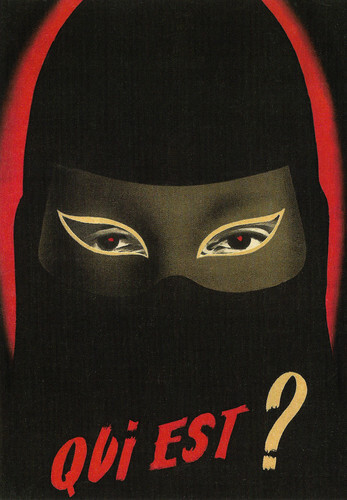
French postcard by Centre Pompidou for the exhibition 'Fantômas et compagnie', 24 April - 27 May 2002.
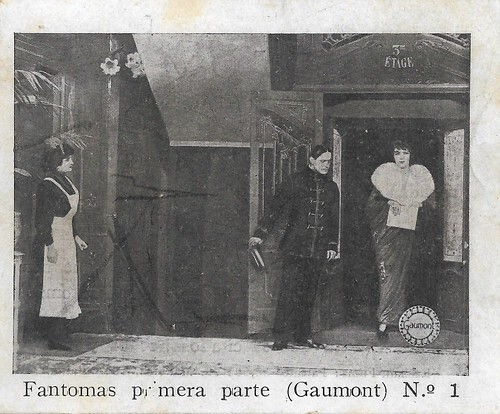
Spanish minicard series by Reclam Films, Mallorca. Photo: Gaumont. Publicity still for Fantômas (Louis Feuillade, 1913), First episode, card 1 of 6.
The plot of the card: It is early in the morning. Princess Sonia Danidoff (Jane Faber) returns to her hotel room at the Royal Palace Hotel. She holds an envelope with 120.000 francs.
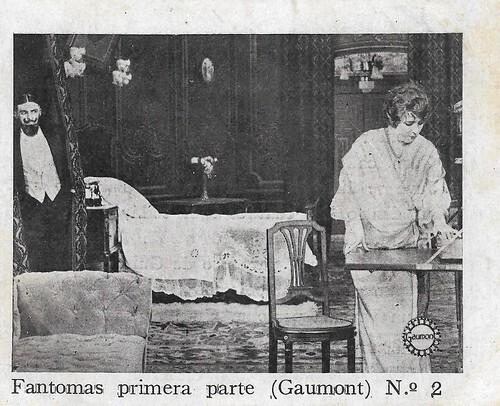
Spanish minicard series by Reclam Films, Mallorca. Photo: Gaumont. Publicity still for Fantômas (Louis Feuillade, 1913), First episode, card 2 of 6.
With a fake beard, Fantômas ( René Navarre ) observes Princess Danidoff (Jane Faber) in her hotel suite. He will rob her of her pearls and money and leave her a business card that only afterwards reveals its name: Fantômas.
A sensational success
Léon Gaumont acquired the film rights of the Fantômas novels by Pierre Souvestre and Marcel Allain in 1913 for 6,000 francs. He commissioned director Louis Feuillade with the realisation. This film adaptation, Fantômas (Louis Feuillade, 1913), was a sensational success. It made René Navarre , who played the title role, overnight a star.
As the magazine, Le Petit Journal wrote, the first part 'Fantômas. A l'ombre de la guillotine' attracted 80,000 cinema-goers to the Gaumont Palace, which was the largest cinema in the world with 3,400 seats.
Critics attributed this partly to the popularity of the so-called Bonnot Gang, a group of anarchists who shook France and Belgium with their spectacular robberies in 1911-1912 and whose modern equipment including automatic rifles and automobiles made them far superior to the police forces.
The technical arms race between the Fantômas' gang and the Paris Sûreté such as surveillance techniques, biometrics, and the use of getaway cars, actually plays an essential role in the series.
But more abstract reasons for the fascination with which the series was received are also cited.
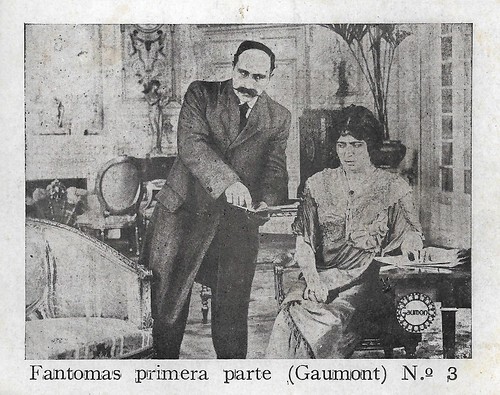
Spanish minicard series by Reclam Films, Mallorca. Photo: Gaumont. Publicity still for Fantômas (Louis Feuillade, 1913), First episode, card 3 of 6.
Inspector Juve (Edmund Bréon) confronts Lady Beltham, Fantômas' mistress (Renée Carl). After the theft, Inspector Juve pays a visit to Lady Beltham. Finding a name in an address book, he asks: Who is Mr. Gurn? She tells Fantomas afterwards, who sends three suitcases to Johannesburg. Juve discovers in one of the suitcases the corps of Lord Beltham. He discovers Gurn is Fantomas.
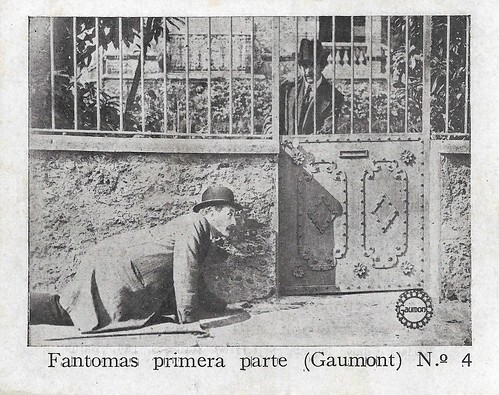
Spanish minicard series by Reclam Films, Mallorca. Photo: Gaumont. Publicity still for Fantômas (Louis Feuillade, 1913), First episode, card 4 of 6.
On his knees, Inspector Juve (Edmund Breon). When Gurn alias Fantômas ( René Navarre ) exits his house, Juve and his police arrest Fantômas. Six months after he is condemned to death. Lady Beltham reads the news and is shocked.
Crime as art
American film critic Jonathan Rosenbaum: "Probably more to the point are the notions of crime as art and art as metaphysics that inspired such poets as Robert Desnos and Jacques Prévert, whereby cop and crook become periodically interchangeable and staid appearances deceive almost by definition, providing the early template for Feuillade's master serials."
In particular, the relationship between law enforcement officers and criminals or citizens, with its political implications, makes Louis Feuillade so modern.
German film scholar Thomas Brandlmeier: "Inspector Juve and the anarcho-breaker Fantômas are the classic schizophrenic pair of state citizen and private citizen. The journalist Fandor, the justice fanatic with the quill pen, acts as the paranoid petit bourgeois around whom the wild mummery rages.'
After the first episode, Fantômas (Louis Feuillade, 1913), four sequels followed: Fantômas II: Juve contre Fantômas/Juve Against Fantomas (Louis Feuillade, 1913), Fantomas III: Le mort qui tue/Fantômas: The Dead Man Who Killed (Louis Feuillade, 1913), Fantômas IV: Fantômas contre Fantômas/Fantomas Against Fantomas (Louis Feuillade, 1914), and Fantômas V: Le faux magistrat/Fantômas: The False Magistrate (Louis Feuillade, 1914).
The series consists of five episodes, each an hour to an hour and a half in length, which end in cliffhangers. Episodes one and three end with Fantômas making a last-minute escape, and the end of the second entry has Fantômas blowing up Lady Beltham's manor house with Juve and Fandor, the two heroes, still inside. The subsequent episodes begin with a recap of the story that has gone before. Each film is further divided into three or more chapters that do not end in cliffhangers.
The five episodes, initially released throughout 1913–1914, were restored under the direction of Jacques Champreaux and released in this new form in 2006. The entire first episode, possibly with some gaps. can be watched on the Wikipedia page dedicated to the serial.
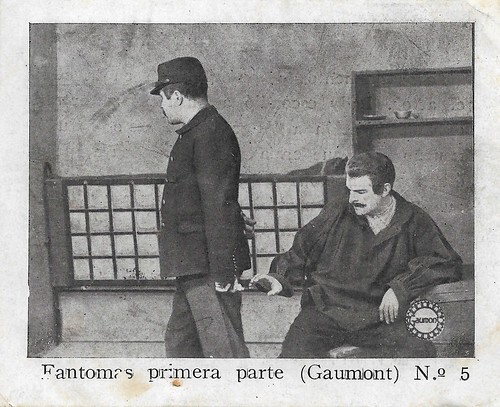
Spanish minicard series by Reclam Films, Mallorca. Photo: Gaumont. Publicity still for Fantômas (Louis Feuillade, 1913), First episode, card 5 of 6.
When the guard Nibet (Naudier) makes his nightly round at the Santé prison he is bribed by Lady Beltham to give Fantomas ( René Navarre ) a letter. Fantômas gives him her address, promising him to make him rich. Lady Beltham indeed loads Nibet with money if he will help her see Fantômas once more.
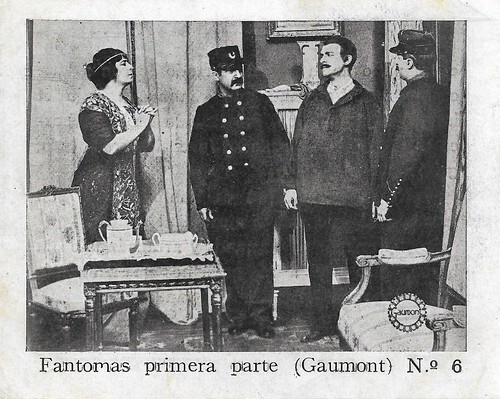
Spanish minicard series by Reclam Films, Mallorca. Photo: Gaumont. Publicity still for Fantômas (Louis Feuillade, 1913), First episode, card 6 of 6.
The famous actor Valgrand (André Volbert) has copied for his show the head and outfit of the soon to be decapitated Gurn/Fantomas ( René Navarre ). After his stage show, he receives a letter from an unknown woman. It is Lady Beltham (René Carl), who invites him to come to her in his attire for the show. She has rented a room opposite the prison. With the help of Nibet (Naudier) and his colleague, Fantomas is secretly freed (the guards think only for a short rendezvous). But Lady Beltham drugs the actor, who is then put in prison instead of Fantomas. The guillotine is built, and Valgrand is about to be killed to Lady Beltham's horror. But Juve just in time unmasks the fake Fantomas as Valgrand. Juve now only has one obsession: to recapture Fantomas.
Sources: Wikipedia (English and German), and IMDb.
And Happy Birthday, Ivo!

French postcard by Centre Pompidou for the exhibition 'Fantômas et compagnie', 24 April - 27 May 2002.

Spanish minicard series by Reclam Films, Mallorca. Photo: Gaumont. Publicity still for Fantômas (Louis Feuillade, 1913), First episode, card 1 of 6.
The plot of the card: It is early in the morning. Princess Sonia Danidoff (Jane Faber) returns to her hotel room at the Royal Palace Hotel. She holds an envelope with 120.000 francs.

Spanish minicard series by Reclam Films, Mallorca. Photo: Gaumont. Publicity still for Fantômas (Louis Feuillade, 1913), First episode, card 2 of 6.
With a fake beard, Fantômas ( René Navarre ) observes Princess Danidoff (Jane Faber) in her hotel suite. He will rob her of her pearls and money and leave her a business card that only afterwards reveals its name: Fantômas.
A sensational success
Léon Gaumont acquired the film rights of the Fantômas novels by Pierre Souvestre and Marcel Allain in 1913 for 6,000 francs. He commissioned director Louis Feuillade with the realisation. This film adaptation, Fantômas (Louis Feuillade, 1913), was a sensational success. It made René Navarre , who played the title role, overnight a star.
As the magazine, Le Petit Journal wrote, the first part 'Fantômas. A l'ombre de la guillotine' attracted 80,000 cinema-goers to the Gaumont Palace, which was the largest cinema in the world with 3,400 seats.
Critics attributed this partly to the popularity of the so-called Bonnot Gang, a group of anarchists who shook France and Belgium with their spectacular robberies in 1911-1912 and whose modern equipment including automatic rifles and automobiles made them far superior to the police forces.
The technical arms race between the Fantômas' gang and the Paris Sûreté such as surveillance techniques, biometrics, and the use of getaway cars, actually plays an essential role in the series.
But more abstract reasons for the fascination with which the series was received are also cited.

Spanish minicard series by Reclam Films, Mallorca. Photo: Gaumont. Publicity still for Fantômas (Louis Feuillade, 1913), First episode, card 3 of 6.
Inspector Juve (Edmund Bréon) confronts Lady Beltham, Fantômas' mistress (Renée Carl). After the theft, Inspector Juve pays a visit to Lady Beltham. Finding a name in an address book, he asks: Who is Mr. Gurn? She tells Fantomas afterwards, who sends three suitcases to Johannesburg. Juve discovers in one of the suitcases the corps of Lord Beltham. He discovers Gurn is Fantomas.

Spanish minicard series by Reclam Films, Mallorca. Photo: Gaumont. Publicity still for Fantômas (Louis Feuillade, 1913), First episode, card 4 of 6.
On his knees, Inspector Juve (Edmund Breon). When Gurn alias Fantômas ( René Navarre ) exits his house, Juve and his police arrest Fantômas. Six months after he is condemned to death. Lady Beltham reads the news and is shocked.
Crime as art
American film critic Jonathan Rosenbaum: "Probably more to the point are the notions of crime as art and art as metaphysics that inspired such poets as Robert Desnos and Jacques Prévert, whereby cop and crook become periodically interchangeable and staid appearances deceive almost by definition, providing the early template for Feuillade's master serials."
In particular, the relationship between law enforcement officers and criminals or citizens, with its political implications, makes Louis Feuillade so modern.
German film scholar Thomas Brandlmeier: "Inspector Juve and the anarcho-breaker Fantômas are the classic schizophrenic pair of state citizen and private citizen. The journalist Fandor, the justice fanatic with the quill pen, acts as the paranoid petit bourgeois around whom the wild mummery rages.'
After the first episode, Fantômas (Louis Feuillade, 1913), four sequels followed: Fantômas II: Juve contre Fantômas/Juve Against Fantomas (Louis Feuillade, 1913), Fantomas III: Le mort qui tue/Fantômas: The Dead Man Who Killed (Louis Feuillade, 1913), Fantômas IV: Fantômas contre Fantômas/Fantomas Against Fantomas (Louis Feuillade, 1914), and Fantômas V: Le faux magistrat/Fantômas: The False Magistrate (Louis Feuillade, 1914).
The series consists of five episodes, each an hour to an hour and a half in length, which end in cliffhangers. Episodes one and three end with Fantômas making a last-minute escape, and the end of the second entry has Fantômas blowing up Lady Beltham's manor house with Juve and Fandor, the two heroes, still inside. The subsequent episodes begin with a recap of the story that has gone before. Each film is further divided into three or more chapters that do not end in cliffhangers.
The five episodes, initially released throughout 1913–1914, were restored under the direction of Jacques Champreaux and released in this new form in 2006. The entire first episode, possibly with some gaps. can be watched on the Wikipedia page dedicated to the serial.

Spanish minicard series by Reclam Films, Mallorca. Photo: Gaumont. Publicity still for Fantômas (Louis Feuillade, 1913), First episode, card 5 of 6.
When the guard Nibet (Naudier) makes his nightly round at the Santé prison he is bribed by Lady Beltham to give Fantomas ( René Navarre ) a letter. Fantômas gives him her address, promising him to make him rich. Lady Beltham indeed loads Nibet with money if he will help her see Fantômas once more.

Spanish minicard series by Reclam Films, Mallorca. Photo: Gaumont. Publicity still for Fantômas (Louis Feuillade, 1913), First episode, card 6 of 6.
The famous actor Valgrand (André Volbert) has copied for his show the head and outfit of the soon to be decapitated Gurn/Fantomas ( René Navarre ). After his stage show, he receives a letter from an unknown woman. It is Lady Beltham (René Carl), who invites him to come to her in his attire for the show. She has rented a room opposite the prison. With the help of Nibet (Naudier) and his colleague, Fantomas is secretly freed (the guards think only for a short rendezvous). But Lady Beltham drugs the actor, who is then put in prison instead of Fantomas. The guillotine is built, and Valgrand is about to be killed to Lady Beltham's horror. But Juve just in time unmasks the fake Fantomas as Valgrand. Juve now only has one obsession: to recapture Fantomas.
Sources: Wikipedia (English and German), and IMDb.
And Happy Birthday, Ivo!
Published on September 05, 2022 22:00
September 4, 2022
The Choice of Alina Deaconu
Today, we have a special guest post at European Film Star Postcards! Here below you find 12 postcards from the collection of Alina Deaconu from Bucharest in Romania. She selected for us her favourite postcards by Casa Filmului Acin (or Film House Acin) from her youth and commented on her choices. Alina wrote me that Acin did not only publish all these great black and white and colour cards with actors, but also printed smaller versions of the black and white cards in mini calendar format (6 cm x 9 cm), titled ‘la mulți ani’ (happy birthday). We’ve added one as an extra below.
Alina could not scan the cards for us so she sent photos of her cards which I edited a bit for this post. The results probably differ a bit from the original postcards, but when I posted the result on Flickr something amazing happened. Alina’s postcard of Julie Christie in Far from the Madding Crowd (John Schlesinger, 1967) was selected by Flickr for its Explore section and thousands and thousands of Flickr users saw and loved it.
So, thank you, Alina, for your guest post with these rare and beautiful Acin cards! The floor is yours now.
Senta Berger
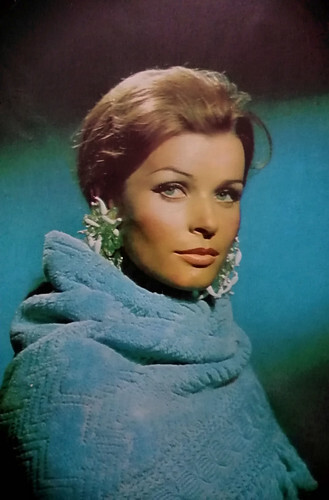
Romanian postcard by Casa Filmului Acin, no. 83.
Alina: This image is one that I really liked as a child. I didn't have this postcard then but I had a big Senta Berger poster with the same image. This picture is extremely beautiful, Senta Berger is wonderful. It can be called boundless blue.
Julie Christie
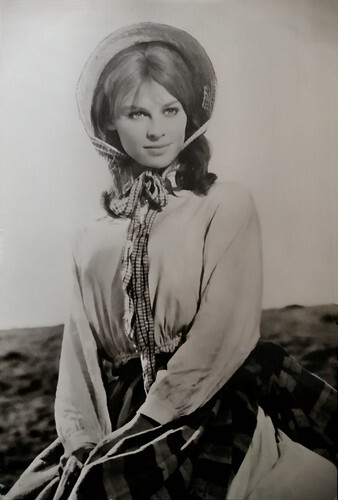
Romanian postcard by Casa Filmului Acin, no. 586. Julie Christie in Far from the Madding Crowd (John Schlesinger, 1967).
Alina: What can be said about this picture? Julie Christie is heart-warming in this picture and the novel ‘Far from the Madding Crowd’ is awesome. Thomas Hardy is one of my favourite writers!
Rossana Podesta
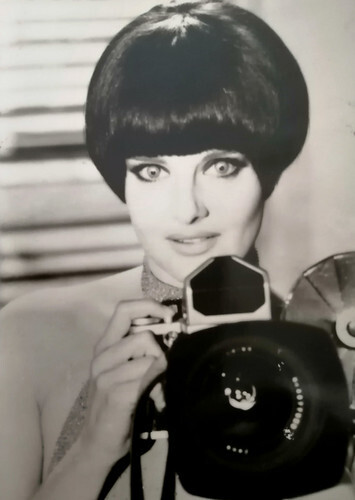
Romanian postcard by Casa Filmului Acin, no. 559.
Alina: Such a wonderful picture of Rossana Podesta !
Marlene Jobert and Horst Buchholtz
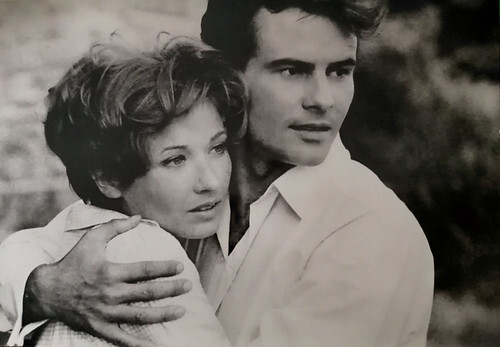
Romanian postcard by Casa Filmului Acin, 295. Marlène Jobert and Horst Buchholz in L'Astragale/Ankle Bone (Guy Casaril, 1969).
Alina: I haven't seen this film, but I really like this image.
Lucyna Winnicka
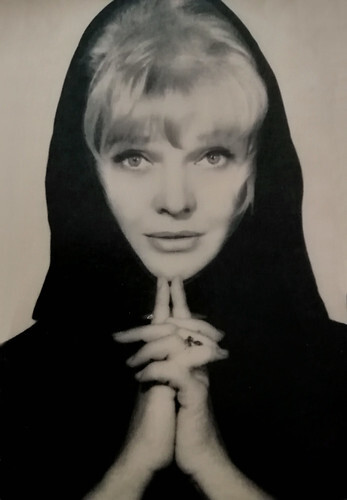
Romanian postcard by Casa Filmului Acin, no. 112.
Alina: An extremely beautiful image! This actress has a special charm and candour and at the same time, she is sexy – she is both an angel and a demon.
Julie Christie
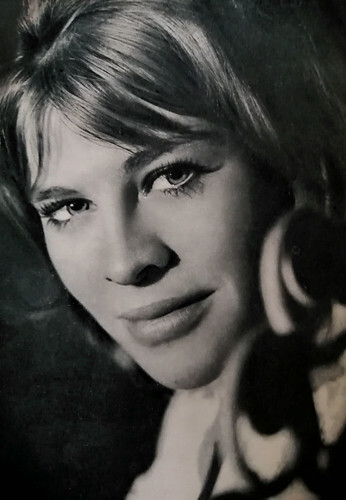
Romanian postcard by Casa Filmului Acin, no. 60.
Alina: Julie is so beautiful and sensual in this photo.
Brigitte Fossey
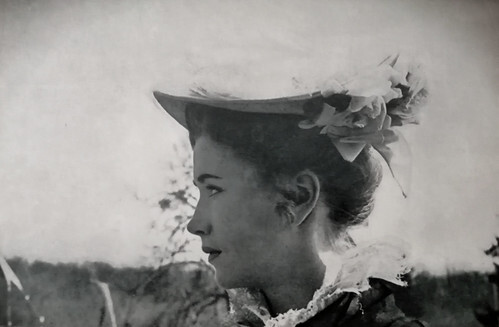
Romanian postcard by Casa Filmului Acin, no. 161. Brigitte Fossey in Le grand Meaulnes/The Great Meaulnes (Jean-Gabriel Albicocco, 1967).
Alina: An image of innocence. I haven't seen the film or read the book, but they are on my priority lists. ‘Le grand Meaulnes’ is the only book by author Alain Fournier.
Anny Duperey
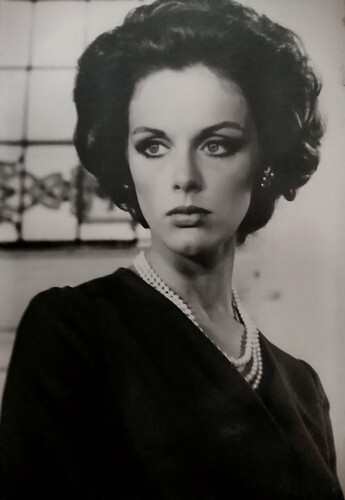
Romanian postcard by Casa Filmului Acin, no. 416.
Alina: I like this actress! Here is a scene from her film Sous le signe de Monte Cristo (1968).
Elizabeth Taylor
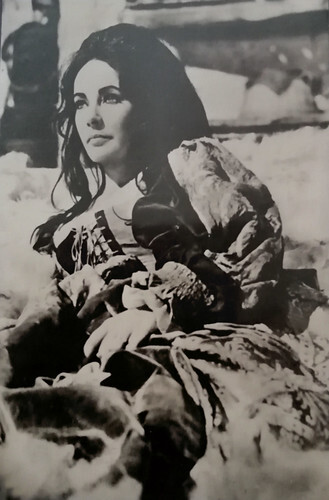
Romanian postcard by Casa Filmului Acin, no. 264. Elizabeth Taylor in The Taming of the Shrew (Franco Zeffirelli, 1967).
Alina: Liz Taylor is amazing in this sequence from The Taming of The Shrew! I really want to see this film. Acin has published more postcards with images from this film.
Genevieve Bujold
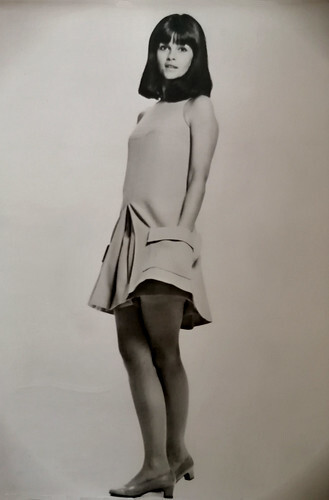
Romanian postcard by Casa Filmului Acin, no. 136.
Alina: A wonderful picture for a wonderful actress! Geneviève Bujold acted exceptionally in Anna of the Thousand Days (1969) and Coma (1978).
Dominique Sanda
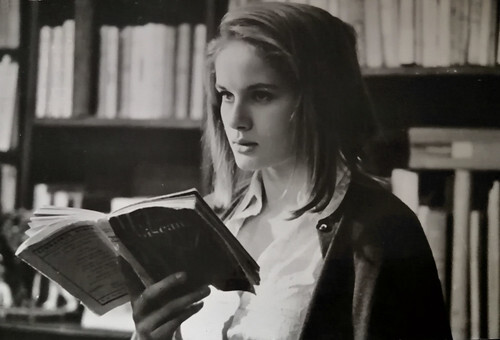
Romanian postcard by Casa Filmului Acin, no. 446. Dominique Sanda in Une femme douce/A Gentle Creature (Robert Bresson, 1969).
Alina: A delicate, beautiful actress with a mysterious air! Acin has many pictures printed with her, both in black and white and in colour!
Jean Rochefort
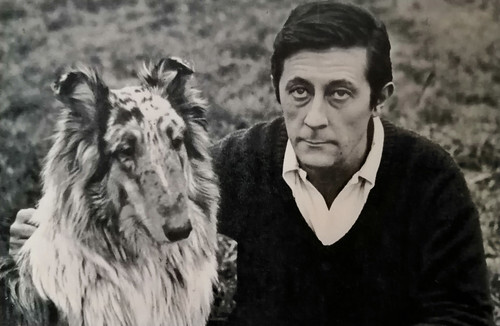
Romanian postcard by Casa Filmului Acin, no. 171.
Alina: Jean Rochefort is a great actor, who unfortunately left us a few years ago. I saw him in a few comedies and I thought he was brilliant. I don't think the sight is from any film, it is a private picture,. I read that Rochefort loved animals (the horses). I saw the same picture on a postcard by German publisher Progress on Flickr!
Extra: La multi ani!
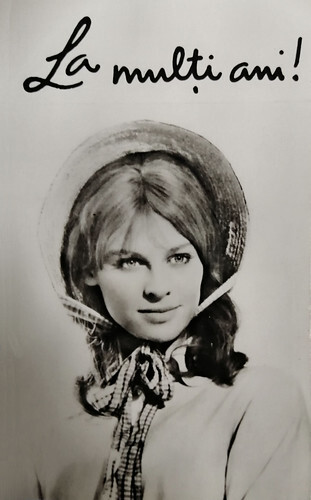
Romanian calender card by Casa Filmului Acin, with the calendar at the flipside. Julie Christie in Far from the Madding Crowd (John Schlesinger, 1967).
Text and postcards: Alina Deaconu. See also our Acin album on Flickr and the Casa Filmului Acin group on Flickr.
Alina could not scan the cards for us so she sent photos of her cards which I edited a bit for this post. The results probably differ a bit from the original postcards, but when I posted the result on Flickr something amazing happened. Alina’s postcard of Julie Christie in Far from the Madding Crowd (John Schlesinger, 1967) was selected by Flickr for its Explore section and thousands and thousands of Flickr users saw and loved it.
So, thank you, Alina, for your guest post with these rare and beautiful Acin cards! The floor is yours now.
Senta Berger

Romanian postcard by Casa Filmului Acin, no. 83.
Alina: This image is one that I really liked as a child. I didn't have this postcard then but I had a big Senta Berger poster with the same image. This picture is extremely beautiful, Senta Berger is wonderful. It can be called boundless blue.
Julie Christie

Romanian postcard by Casa Filmului Acin, no. 586. Julie Christie in Far from the Madding Crowd (John Schlesinger, 1967).
Alina: What can be said about this picture? Julie Christie is heart-warming in this picture and the novel ‘Far from the Madding Crowd’ is awesome. Thomas Hardy is one of my favourite writers!
Rossana Podesta

Romanian postcard by Casa Filmului Acin, no. 559.
Alina: Such a wonderful picture of Rossana Podesta !
Marlene Jobert and Horst Buchholtz

Romanian postcard by Casa Filmului Acin, 295. Marlène Jobert and Horst Buchholz in L'Astragale/Ankle Bone (Guy Casaril, 1969).
Alina: I haven't seen this film, but I really like this image.
Lucyna Winnicka

Romanian postcard by Casa Filmului Acin, no. 112.
Alina: An extremely beautiful image! This actress has a special charm and candour and at the same time, she is sexy – she is both an angel and a demon.
Julie Christie

Romanian postcard by Casa Filmului Acin, no. 60.
Alina: Julie is so beautiful and sensual in this photo.
Brigitte Fossey

Romanian postcard by Casa Filmului Acin, no. 161. Brigitte Fossey in Le grand Meaulnes/The Great Meaulnes (Jean-Gabriel Albicocco, 1967).
Alina: An image of innocence. I haven't seen the film or read the book, but they are on my priority lists. ‘Le grand Meaulnes’ is the only book by author Alain Fournier.
Anny Duperey

Romanian postcard by Casa Filmului Acin, no. 416.
Alina: I like this actress! Here is a scene from her film Sous le signe de Monte Cristo (1968).
Elizabeth Taylor

Romanian postcard by Casa Filmului Acin, no. 264. Elizabeth Taylor in The Taming of the Shrew (Franco Zeffirelli, 1967).
Alina: Liz Taylor is amazing in this sequence from The Taming of The Shrew! I really want to see this film. Acin has published more postcards with images from this film.
Genevieve Bujold

Romanian postcard by Casa Filmului Acin, no. 136.
Alina: A wonderful picture for a wonderful actress! Geneviève Bujold acted exceptionally in Anna of the Thousand Days (1969) and Coma (1978).
Dominique Sanda

Romanian postcard by Casa Filmului Acin, no. 446. Dominique Sanda in Une femme douce/A Gentle Creature (Robert Bresson, 1969).
Alina: A delicate, beautiful actress with a mysterious air! Acin has many pictures printed with her, both in black and white and in colour!
Jean Rochefort

Romanian postcard by Casa Filmului Acin, no. 171.
Alina: Jean Rochefort is a great actor, who unfortunately left us a few years ago. I saw him in a few comedies and I thought he was brilliant. I don't think the sight is from any film, it is a private picture,. I read that Rochefort loved animals (the horses). I saw the same picture on a postcard by German publisher Progress on Flickr!
Extra: La multi ani!

Romanian calender card by Casa Filmului Acin, with the calendar at the flipside. Julie Christie in Far from the Madding Crowd (John Schlesinger, 1967).
Text and postcards: Alina Deaconu. See also our Acin album on Flickr and the Casa Filmului Acin group on Flickr.
Published on September 04, 2022 22:00
September 3, 2022
Greta Garbo: the sound films
Swedish-born Greta Garbo (1905-1990) was one of the greatest and most glamorous film stars ever produced by the Hollywood studio system. She was part of the Golden Age of the silent cinema of the 1920s but Garbo was one of the few Hollywood actors who made a glorious transition to the talkies.
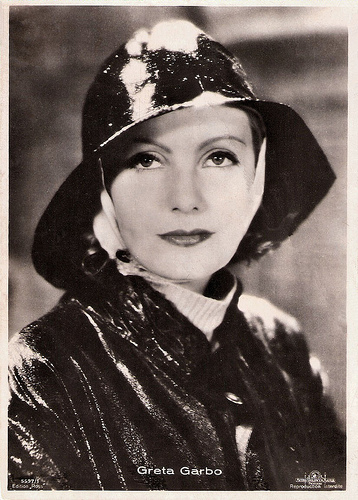
French postcard by Edition Ross, no. 5597/1, 1930-1931. Photo: Metro-Goldwyn-Mayer. Publicity still for Anna Christie (Clarence Brown, 1930).
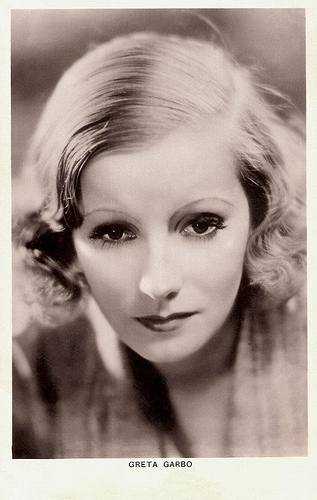
British postcard in the Picturegoer Series, London, no. 283e.
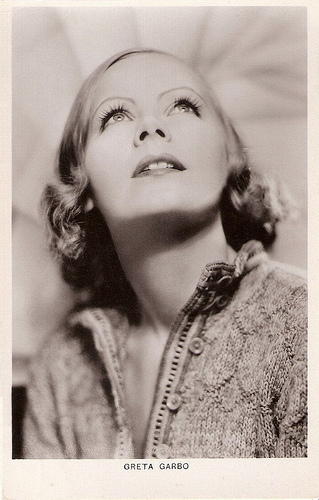
British postcard in the Picturegoer Series, London, no. 283b.
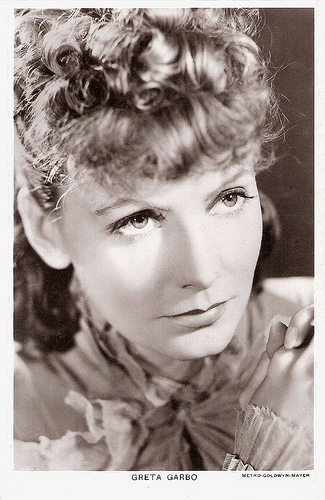
British postcard in the Picturegoer Series, London, no. 637b. Photo: Clarence Sinclair Bull / Metro-Goldwyn-Mayer. Publicity still for Anna Karenina (Clarence Brown, 1935).
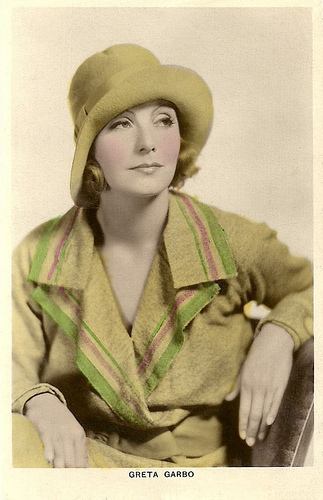
British postcard in the Colourgraph Series, London, no. C 81. Photo: publicity still for Anna Christie (Clarence Brown, 1930).
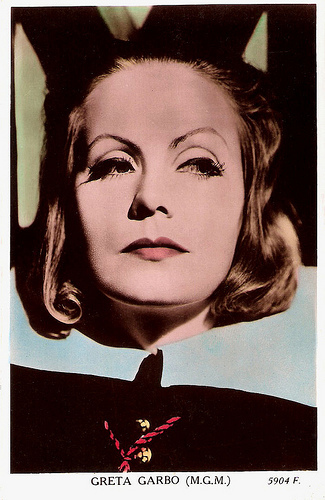
British postcard in the Valentine's Postcard series, no. 5904 F. Photo: MGM. Publicity still for Queen Christina (Rouben Mamoulian, 1933).
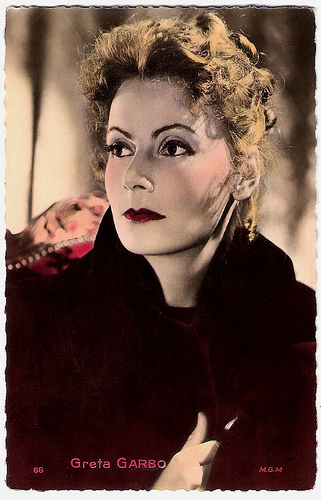
French postcard by Ed. Chantal, no. 66. Photo: M.G.M. Publicity still for Conquest (Clarence Brown, 1937).
Garbo Talks!
In Hollywood, Greta Garbo spent most of 1925 posing for nonsensical publicity photos which endeavoured to create a 'mystery woman image for her. Hal Erickson at AllMovie : "but it was only after shooting commenced on Garbo's first American film, The Torrent (1926), that MGM realized it had a potential gold mine on its hands." The Director of The Torrent was Monta Bell and Greta played a peasant girl turned singer opposite Ricardo Cortez . The film was a hit and despite its cool reception by the trade press, Garbo's performance was critically acclaimed.
Her third film for MGM, Flesh and the Devil (Clarence Brown, 1926), made her an international star. Her co-star was John Gilbert , and their on-screen chemistry soon translated into an off-camera romance by the end of the production, they lived together. The Garbo/Gilbert team went on to make an adaptation of Lev Tolstoy's Anna Karenina titled Love (Edmund Goulding, 1927). The couple planned to marry, but Garbo, in one of her attacks of self-imposed solitude, did not show up for the wedding. Over the years, the actress would have other romantic involvements, but would never marry.
Anna Christie (Clarence Brown, 1930) was filmed at a time of transition in Hollywood from the silent era to sound. Reportedly MGM had concerns about Garbo's voice. The studio was afraid that her thick Swedish accent would not register well in the talkies. The poster for her first sound film read "Garbo Talks!", which would become a catchphrase widely associated with her.
Sixteen minutes into Anna Christie, Garbo finally utters her first, now famous line, "Gimme a whiskey, ginger ale on the side, and don't be stingy, baby." Garbo's voice meshed perfectly with her established image, and her performance in Anna Christie was effective. So, when 'Garbo talks' the audience still listened.
Anna Christie, based on a play by Eugene O'Neill, became a transitional film for Garbo. Hal Erickson: "the advent of talkies obliged the actress to drop the 'mysterious temptress' characterization she'd used in silents in favour of more richly textured performances as worldly, somewhat melancholy women to whom the normal pleasures of love and contentment would always be just out of reach."
Greta Garbo had a huge following in Europe, especially in Germany. Therefore MGM also made a German version of Anna Christie. Both versions were filmed back to back. Garbo played the leading role in both versions, but all the other characters in the German version were played by different actors from the English version. Curiously, Garbo herself supposedly favoured her Anna Christie in the German version over the English version. The German version was directed by Jacques Feyder and had its first screening in Germany in 1931.
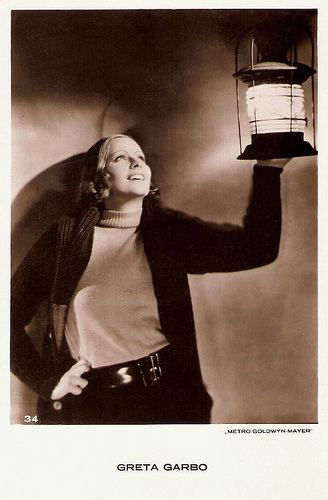
Dutch postcard by JosPe, Arnhem, no. 34. Photo: Clarence Sinclair Bull / Metro Goldwyn Mayer. Publicity still for Anna Christie (Clarence Brown, 1930).
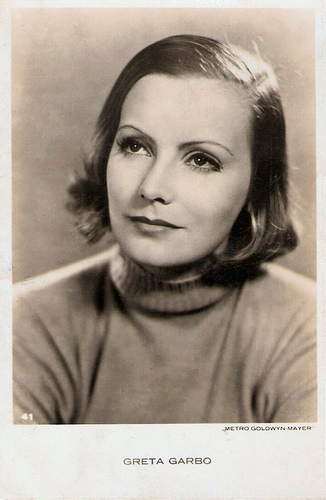
Dutch Postcard, no. 41. Photo: Clarence Sinclair Bull / Metro Goldwyn Mayer. Publicity still for Anna Christie (Clarence Brown, 1930).
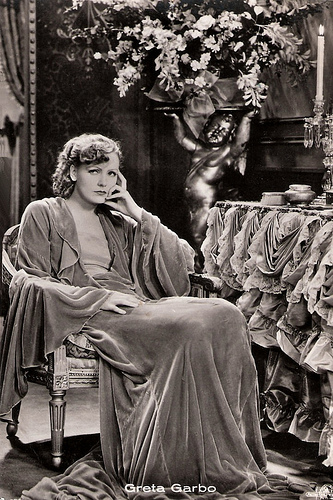
Dutch postcard. Sent by mail in 1931. Photo: Metro-Goldwyn-Mayer.
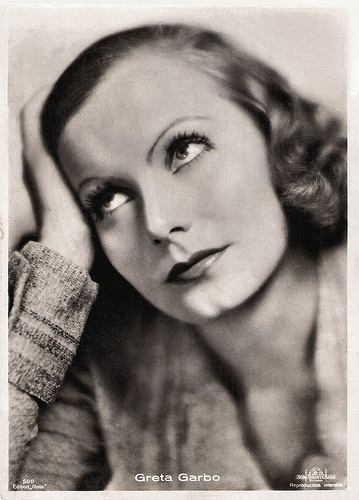
French postcard by Edition Ross, no. 500. Photo: Clarence Sinclair Bull. Publicity still for the German version of Anna Christie (Jacques Feyder, 1930).
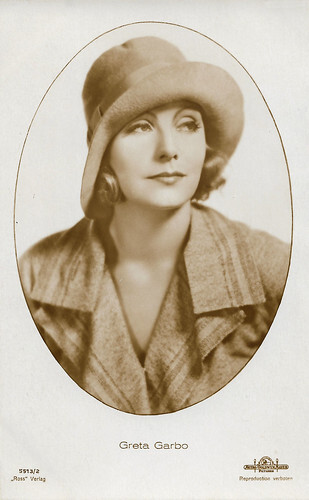
German postcard by Ross Verlag, no. 5513/2, 1930-1931. Photo: MGM. Photo: Clarence Sinclair Bull. Publicity still for the German version of Anna Christie (Jacques Feyder, 1930).
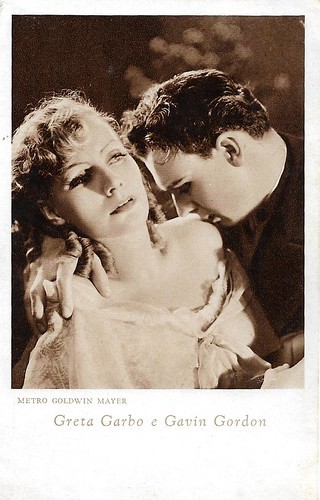
Italian postcard by Cinema-Illustrazione, Milano, series II, no. 1. Photo: Metro-Goldwyn-Mayer. Greta Garbo and Gavin Gordon acted together in the early sound film Romance (Clarence Brown, 1930). It was also issued as a silent film.
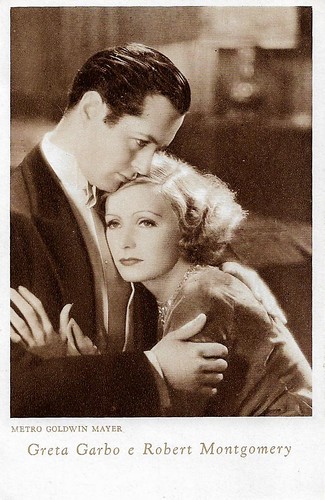
Italian postcard by Cinema-Illustrazione, Milano, series 2, no. 3. Photo: Metro-Goldwyn-Mayer. Greta Garbo and Robert Montgomery in Inspiration (Clarence Brown, 1931).
From the Greatest Money-making Machine to Box Office Poison
Greta Garbo next made Romance (Clarence Brown, 1930) in the same year as Anna Christie. Romance is a film with nearly no plot twists, but Garbo is stunning. She originally wanted Gary Cooper as her leading man, but MGM could not borrow Cooper from Paramount, so Garbo had to settle for Lewis Stone and the unknown Gavin Gordon. After Anna Christie, Romance (1930) was somewhat of a letdown, but for her performances in these films, she received the first of three Academy Award nominations for Best Actress. Academy rules at the time allowed for a performer to receive a single nomination for their work in more than one film.
In 1931, Garbo bounced back, landing another lead role opposite Ramon Novarro as the World War I spy in Mata Hari (George Fitzmaurice, 1931). The lavish production turned out to be a major hit. The next year she was cast in yet another hit, Grand Hotel (Edmund Goulding, 1932). She played a Russian ballerina opposite an ensemble cast, including John Barrymore, Joan Crawford, and Wallace Beery. The film won an Academy Award for Best Picture. Both Mata Hari and Grand Hotel had been MGM's highest-earning films of 1931 and 1932, respectively, and Garbo was dubbed "the greatest money-making machine ever put on screen".
From now on, her popularity allowed her to dictate the terms of her contract and Garbo became increasingly selective about her roles. Queen Christina (Rouben Mamoulian, 1933) was a lavish production, becoming one of the studio's biggest productions at the time. Publicised as "Garbo returns", the film became the highest-grossing film of the year. However, censors objected to the scenes in which Garbo disguised herself as a man and kissed a female co-star.
In the Leo Tolstoy adaptation Anna Karenina (Clarence Brown, 1935), she played another of her renowned roles. The film won the Mussolini Cup for the best foreign film at the Venice Film Festival, and Garbo received a New York Film Critics Circle Award for Best Actress for her role as Anna. Many critics and film historians consider her performance as the doomed courtesan Marguerite Gautier in George Cukor's romantic drama Camille (1936) to be her finest. The role gained her a second Academy Award nomination.
However, Greta Garbo's career soon declined after the flop of Conquest (Clarence Brown, 1937), and in 1938, she was one of the many stars labelled "Box Office Poison".
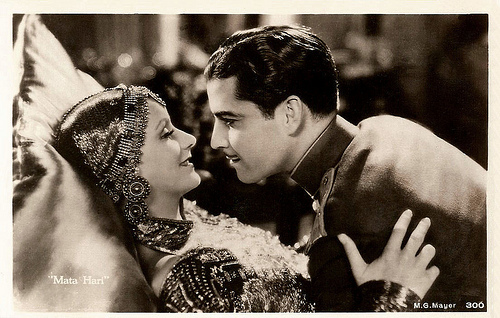
Vintage postcard, no. 300. Photo: M.G.Mayer. Publicity still for Mata Hari (George Fitzmaurice, 1931) with Ramon Novarro .
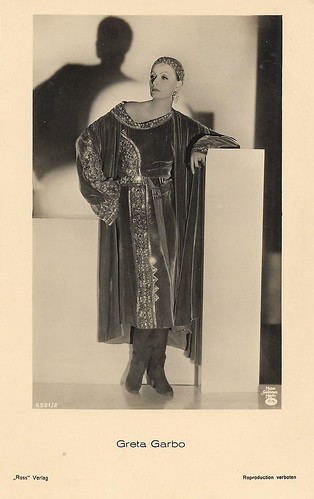
German postcard by Ross Verlag, no. 6521/2, 1931-1932. Photo: Clarence Sinclair Bull / Metro-Goldwyn-Mayer. Publicity still for Mata Hari (George Fitzmaurice, 1931).
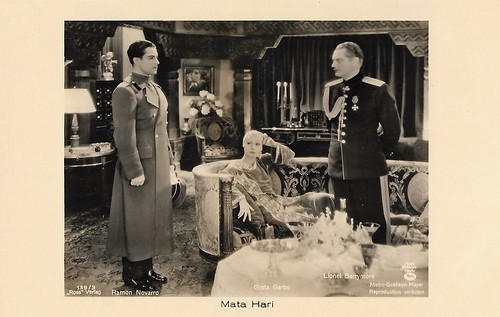
German postcard by Ross Verlag, Berlin, no. 139/3. Photo: Metro-Goldwyn-Mayer. Greta Garbo, Ramon Novarro , and Lionel Barrymore in Mata Hari (George Fitzmaurice, 1931).
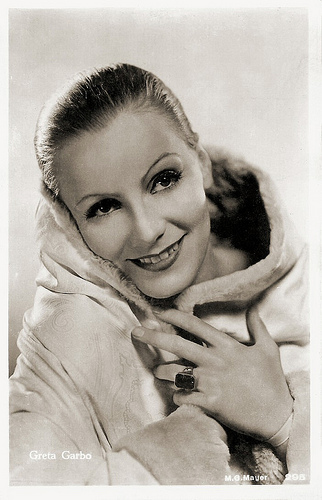
Dutch postcard by JosPe, no. 295. Photo: Metro-Goldwyn-Mayer (MGM) / Clarence Sinclair Bull. Publicity still for Mata Hari (George Fitzmaurice, 1931) .
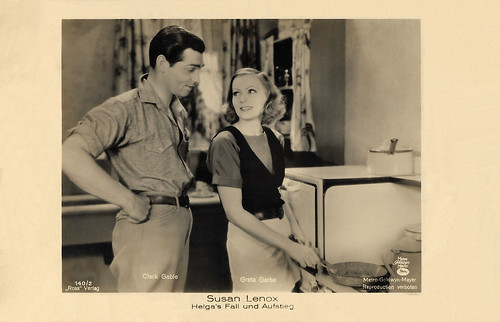
German postcard by Ross Verlag, no. 140/2. Greta Garbo and Clark Gable in Susan Lenox (Her Fall and Rise) (Robert Z. Leonard, 1931).
Susan Lenox (Her Fall and Rise) was released in German-speaking countries as 'Helga's Fall und Aufstieg'. Her character's name is really Helga Ohlin, she only later changes it into Susan Lenox.
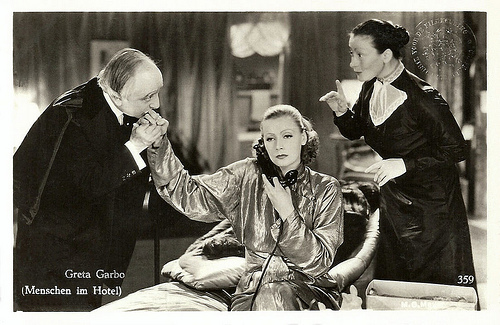
Postcard with Dutch censorship stamp, no. 359. Photo: publicity still for Grand Hotel (Edmund Goulding, 1932) with Ferdinand Gottschalk and Rafaela Ottiano.
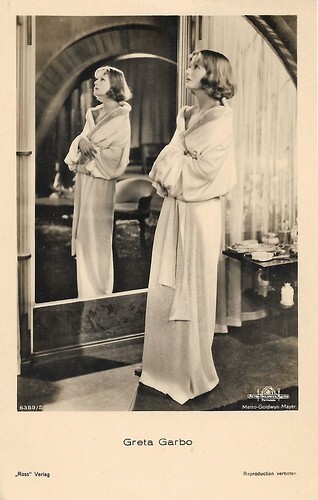
German postcard by Ross Verlag, no. 6389/2, 1931-1932. Photo: Metro-Goldwyn-Mayer. Greta Garbo in Grand Hotel (Edmund Goulding, 1932).
Garbo laughs!
In 1939, Greta Garbo made a comeback when she starred in Ninotchka (Ernst Lubitsch, 1939). Her first comedy was one of the first Hollywood films which, under the cover of a satirical, light romance, depicted the Soviet Union under Joseph Stalin as being rigid and grey when compared to its prewar years. Ninotchka was publicised with the catchphrase "Garbo laughs!", commenting on the departure of Garbo's serious and melancholy image as she transferred to comedy. Bosley Crowther, the famous New York Times film critic wrote that Garbo Garbo "demonstrated that she had the wit and flexibility to be a fine comedienne".
All of Garbo's films were in black and white which enhanced her mystery and romantic allure. Her last film was the domestic comedy Two-Faced Woman (George Cukor, 1941), which was considered a distinct step downward for her. The film drew controversy and was condemned by the Catholic Church and other groups and was a box office failure. She was 35 and had acted in twenty-eight films.
After the war, Greta Garbo hoped to return to films. She was asked to appear in Alfred Hitchcock's The Paradine Case (1947), but she turned the role down. In 1949, after making some screentests for a film project called The Wicked Dutchess which was never realised due to financial problems, Garbo retired definitively. Greta Garbo abandoned Hollywood and moved to New York City. She would jet-set with such personalities as Aristotle Onassis and Cecil Beaton, and spend the rest of her time gardening flowers and vegetables.
In the 1970s, Garbo traveled less and grew more and more eccentric, although she still took daily walks through Central Park with close friends. In the late 1980s failing health decreased her mobility. In her final year it was her family that cared for her, including taking her to dialysis treatments.
In 1990, Greta Garbo died of natural causes in New York. She was 84. In 1954, she was given a special Oscar 'for her unforgettable performances', and in 1999, the American Film Institute ranked Garbo fifth on their list of the greatest female stars of classic Hollywood cinema, after Katharine Hepburn, Bette Davis, Audrey Hepburn , and Ingrid Bergman .
Hal Erickson at AllMovie : "Even after her death in 1990, the legend of Greta Garbo was undiminished. Few of her fans talk of her in human terms; to her devotees, Greta Garbo was not so much film legend as film goddess."
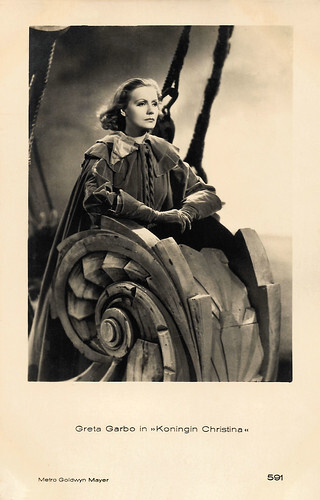
Dutch postcard, no. 591. Photo: Clarence Sinclair Bull / Metro-Goldwyn-Mayer. Greta Garbo Queen Christina (Rouben Mamoulian, 1933).
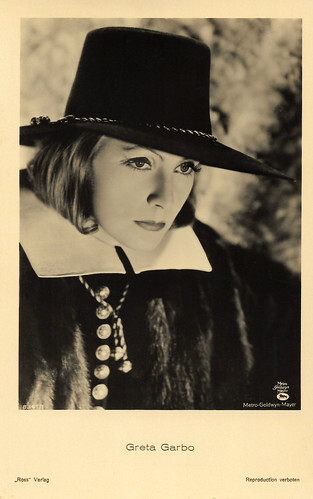
German postcard by Ross Verlag, no. 8341/1, 1933-1934. Photo: Clarence Sinclair Bull / Metro-Goldwyn-Mayer. Greta Garbo Queen Christina (Rouben Mamoulian, 1933).
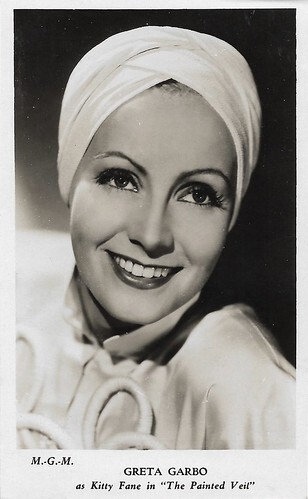
British postcard. Greta Garbo as Kitty Fane in The Painted Veil (Richard Boleslawski, 1934). Metro-Goldwyn-Mayer.
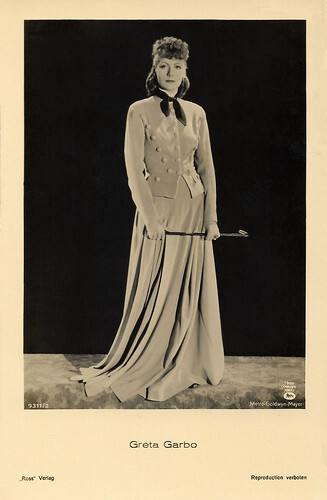
German postcard by Ross Verlag, no. 9311/2, 1935-1936. Photo: Clarence Sinclair Bull / Metro-Goldwyn-Mayer. Greta Garbo in Anna Karenina (Clarence Brown 1935).
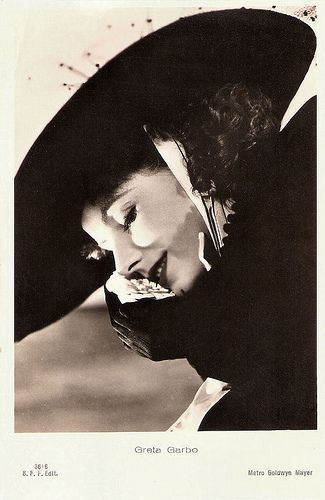
Italian postcard by B.F.F. Edit., no. 3616. Photo: Clarence Sinclair Bull / Metro-Goldwyn-Mayer. Publicity still for Camille (George Cukor, 1936).
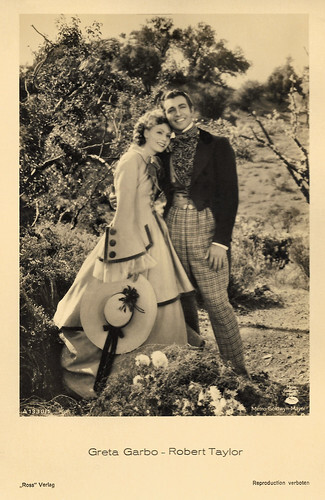
German postcard by Ross Verlag, no. A 1330/1, 1937-1938, Photo: Metro-Goldwyn-Mayer. Greta Garbo and Robert Taylor in Camille (George Cukor, 1936).
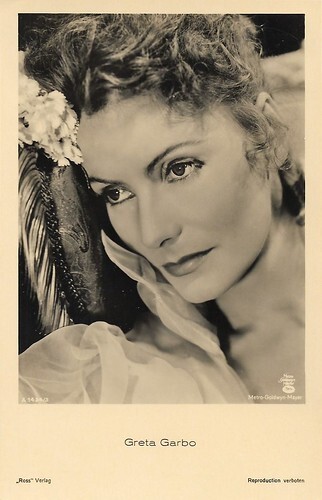
German postcard by Ross Verlag, no. A 1424/3, 1937-1938. Photo: Metro-Goldwyn-Mayer. Greta Garbo in Conquest (Clarence Brown, 1937).
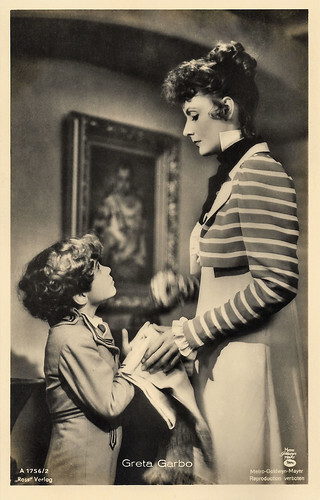
German postcard by Ross Verlag, no. A 1756/2, 1937-1938. Photo: Metro Goldwyn Mayer. Greta Garbo and Scotty Beckett in Conquest / Marie Walewska (Clarence Brown, 1937).
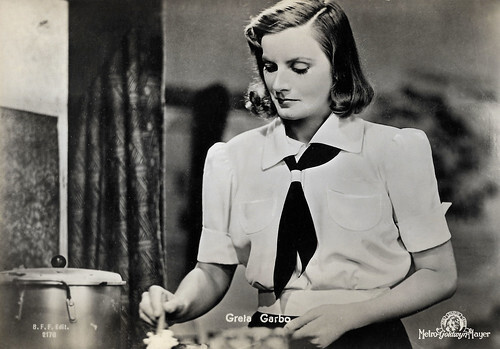
Italian postcard by B.F.F. Edit. (Casa Editr. Ballerini & Fratini, Firenze), no. 2178. Photo: Metro-Goldwyn-Mayer. Greta Garbo in Ninotchka (Ernst Lubitsch, 1939).
Sources: Hal Erickson (AllMovie), (IMDb), Wikipedia, and .

French postcard by Edition Ross, no. 5597/1, 1930-1931. Photo: Metro-Goldwyn-Mayer. Publicity still for Anna Christie (Clarence Brown, 1930).

British postcard in the Picturegoer Series, London, no. 283e.

British postcard in the Picturegoer Series, London, no. 283b.

British postcard in the Picturegoer Series, London, no. 637b. Photo: Clarence Sinclair Bull / Metro-Goldwyn-Mayer. Publicity still for Anna Karenina (Clarence Brown, 1935).

British postcard in the Colourgraph Series, London, no. C 81. Photo: publicity still for Anna Christie (Clarence Brown, 1930).

British postcard in the Valentine's Postcard series, no. 5904 F. Photo: MGM. Publicity still for Queen Christina (Rouben Mamoulian, 1933).

French postcard by Ed. Chantal, no. 66. Photo: M.G.M. Publicity still for Conquest (Clarence Brown, 1937).
Garbo Talks!
In Hollywood, Greta Garbo spent most of 1925 posing for nonsensical publicity photos which endeavoured to create a 'mystery woman image for her. Hal Erickson at AllMovie : "but it was only after shooting commenced on Garbo's first American film, The Torrent (1926), that MGM realized it had a potential gold mine on its hands." The Director of The Torrent was Monta Bell and Greta played a peasant girl turned singer opposite Ricardo Cortez . The film was a hit and despite its cool reception by the trade press, Garbo's performance was critically acclaimed.
Her third film for MGM, Flesh and the Devil (Clarence Brown, 1926), made her an international star. Her co-star was John Gilbert , and their on-screen chemistry soon translated into an off-camera romance by the end of the production, they lived together. The Garbo/Gilbert team went on to make an adaptation of Lev Tolstoy's Anna Karenina titled Love (Edmund Goulding, 1927). The couple planned to marry, but Garbo, in one of her attacks of self-imposed solitude, did not show up for the wedding. Over the years, the actress would have other romantic involvements, but would never marry.
Anna Christie (Clarence Brown, 1930) was filmed at a time of transition in Hollywood from the silent era to sound. Reportedly MGM had concerns about Garbo's voice. The studio was afraid that her thick Swedish accent would not register well in the talkies. The poster for her first sound film read "Garbo Talks!", which would become a catchphrase widely associated with her.
Sixteen minutes into Anna Christie, Garbo finally utters her first, now famous line, "Gimme a whiskey, ginger ale on the side, and don't be stingy, baby." Garbo's voice meshed perfectly with her established image, and her performance in Anna Christie was effective. So, when 'Garbo talks' the audience still listened.
Anna Christie, based on a play by Eugene O'Neill, became a transitional film for Garbo. Hal Erickson: "the advent of talkies obliged the actress to drop the 'mysterious temptress' characterization she'd used in silents in favour of more richly textured performances as worldly, somewhat melancholy women to whom the normal pleasures of love and contentment would always be just out of reach."
Greta Garbo had a huge following in Europe, especially in Germany. Therefore MGM also made a German version of Anna Christie. Both versions were filmed back to back. Garbo played the leading role in both versions, but all the other characters in the German version were played by different actors from the English version. Curiously, Garbo herself supposedly favoured her Anna Christie in the German version over the English version. The German version was directed by Jacques Feyder and had its first screening in Germany in 1931.

Dutch postcard by JosPe, Arnhem, no. 34. Photo: Clarence Sinclair Bull / Metro Goldwyn Mayer. Publicity still for Anna Christie (Clarence Brown, 1930).

Dutch Postcard, no. 41. Photo: Clarence Sinclair Bull / Metro Goldwyn Mayer. Publicity still for Anna Christie (Clarence Brown, 1930).

Dutch postcard. Sent by mail in 1931. Photo: Metro-Goldwyn-Mayer.

French postcard by Edition Ross, no. 500. Photo: Clarence Sinclair Bull. Publicity still for the German version of Anna Christie (Jacques Feyder, 1930).

German postcard by Ross Verlag, no. 5513/2, 1930-1931. Photo: MGM. Photo: Clarence Sinclair Bull. Publicity still for the German version of Anna Christie (Jacques Feyder, 1930).

Italian postcard by Cinema-Illustrazione, Milano, series II, no. 1. Photo: Metro-Goldwyn-Mayer. Greta Garbo and Gavin Gordon acted together in the early sound film Romance (Clarence Brown, 1930). It was also issued as a silent film.

Italian postcard by Cinema-Illustrazione, Milano, series 2, no. 3. Photo: Metro-Goldwyn-Mayer. Greta Garbo and Robert Montgomery in Inspiration (Clarence Brown, 1931).
From the Greatest Money-making Machine to Box Office Poison
Greta Garbo next made Romance (Clarence Brown, 1930) in the same year as Anna Christie. Romance is a film with nearly no plot twists, but Garbo is stunning. She originally wanted Gary Cooper as her leading man, but MGM could not borrow Cooper from Paramount, so Garbo had to settle for Lewis Stone and the unknown Gavin Gordon. After Anna Christie, Romance (1930) was somewhat of a letdown, but for her performances in these films, she received the first of three Academy Award nominations for Best Actress. Academy rules at the time allowed for a performer to receive a single nomination for their work in more than one film.
In 1931, Garbo bounced back, landing another lead role opposite Ramon Novarro as the World War I spy in Mata Hari (George Fitzmaurice, 1931). The lavish production turned out to be a major hit. The next year she was cast in yet another hit, Grand Hotel (Edmund Goulding, 1932). She played a Russian ballerina opposite an ensemble cast, including John Barrymore, Joan Crawford, and Wallace Beery. The film won an Academy Award for Best Picture. Both Mata Hari and Grand Hotel had been MGM's highest-earning films of 1931 and 1932, respectively, and Garbo was dubbed "the greatest money-making machine ever put on screen".
From now on, her popularity allowed her to dictate the terms of her contract and Garbo became increasingly selective about her roles. Queen Christina (Rouben Mamoulian, 1933) was a lavish production, becoming one of the studio's biggest productions at the time. Publicised as "Garbo returns", the film became the highest-grossing film of the year. However, censors objected to the scenes in which Garbo disguised herself as a man and kissed a female co-star.
In the Leo Tolstoy adaptation Anna Karenina (Clarence Brown, 1935), she played another of her renowned roles. The film won the Mussolini Cup for the best foreign film at the Venice Film Festival, and Garbo received a New York Film Critics Circle Award for Best Actress for her role as Anna. Many critics and film historians consider her performance as the doomed courtesan Marguerite Gautier in George Cukor's romantic drama Camille (1936) to be her finest. The role gained her a second Academy Award nomination.
However, Greta Garbo's career soon declined after the flop of Conquest (Clarence Brown, 1937), and in 1938, she was one of the many stars labelled "Box Office Poison".

Vintage postcard, no. 300. Photo: M.G.Mayer. Publicity still for Mata Hari (George Fitzmaurice, 1931) with Ramon Novarro .

German postcard by Ross Verlag, no. 6521/2, 1931-1932. Photo: Clarence Sinclair Bull / Metro-Goldwyn-Mayer. Publicity still for Mata Hari (George Fitzmaurice, 1931).

German postcard by Ross Verlag, Berlin, no. 139/3. Photo: Metro-Goldwyn-Mayer. Greta Garbo, Ramon Novarro , and Lionel Barrymore in Mata Hari (George Fitzmaurice, 1931).

Dutch postcard by JosPe, no. 295. Photo: Metro-Goldwyn-Mayer (MGM) / Clarence Sinclair Bull. Publicity still for Mata Hari (George Fitzmaurice, 1931) .

German postcard by Ross Verlag, no. 140/2. Greta Garbo and Clark Gable in Susan Lenox (Her Fall and Rise) (Robert Z. Leonard, 1931).
Susan Lenox (Her Fall and Rise) was released in German-speaking countries as 'Helga's Fall und Aufstieg'. Her character's name is really Helga Ohlin, she only later changes it into Susan Lenox.

Postcard with Dutch censorship stamp, no. 359. Photo: publicity still for Grand Hotel (Edmund Goulding, 1932) with Ferdinand Gottschalk and Rafaela Ottiano.

German postcard by Ross Verlag, no. 6389/2, 1931-1932. Photo: Metro-Goldwyn-Mayer. Greta Garbo in Grand Hotel (Edmund Goulding, 1932).
Garbo laughs!
In 1939, Greta Garbo made a comeback when she starred in Ninotchka (Ernst Lubitsch, 1939). Her first comedy was one of the first Hollywood films which, under the cover of a satirical, light romance, depicted the Soviet Union under Joseph Stalin as being rigid and grey when compared to its prewar years. Ninotchka was publicised with the catchphrase "Garbo laughs!", commenting on the departure of Garbo's serious and melancholy image as she transferred to comedy. Bosley Crowther, the famous New York Times film critic wrote that Garbo Garbo "demonstrated that she had the wit and flexibility to be a fine comedienne".
All of Garbo's films were in black and white which enhanced her mystery and romantic allure. Her last film was the domestic comedy Two-Faced Woman (George Cukor, 1941), which was considered a distinct step downward for her. The film drew controversy and was condemned by the Catholic Church and other groups and was a box office failure. She was 35 and had acted in twenty-eight films.
After the war, Greta Garbo hoped to return to films. She was asked to appear in Alfred Hitchcock's The Paradine Case (1947), but she turned the role down. In 1949, after making some screentests for a film project called The Wicked Dutchess which was never realised due to financial problems, Garbo retired definitively. Greta Garbo abandoned Hollywood and moved to New York City. She would jet-set with such personalities as Aristotle Onassis and Cecil Beaton, and spend the rest of her time gardening flowers and vegetables.
In the 1970s, Garbo traveled less and grew more and more eccentric, although she still took daily walks through Central Park with close friends. In the late 1980s failing health decreased her mobility. In her final year it was her family that cared for her, including taking her to dialysis treatments.
In 1990, Greta Garbo died of natural causes in New York. She was 84. In 1954, she was given a special Oscar 'for her unforgettable performances', and in 1999, the American Film Institute ranked Garbo fifth on their list of the greatest female stars of classic Hollywood cinema, after Katharine Hepburn, Bette Davis, Audrey Hepburn , and Ingrid Bergman .
Hal Erickson at AllMovie : "Even after her death in 1990, the legend of Greta Garbo was undiminished. Few of her fans talk of her in human terms; to her devotees, Greta Garbo was not so much film legend as film goddess."

Dutch postcard, no. 591. Photo: Clarence Sinclair Bull / Metro-Goldwyn-Mayer. Greta Garbo Queen Christina (Rouben Mamoulian, 1933).

German postcard by Ross Verlag, no. 8341/1, 1933-1934. Photo: Clarence Sinclair Bull / Metro-Goldwyn-Mayer. Greta Garbo Queen Christina (Rouben Mamoulian, 1933).

British postcard. Greta Garbo as Kitty Fane in The Painted Veil (Richard Boleslawski, 1934). Metro-Goldwyn-Mayer.

German postcard by Ross Verlag, no. 9311/2, 1935-1936. Photo: Clarence Sinclair Bull / Metro-Goldwyn-Mayer. Greta Garbo in Anna Karenina (Clarence Brown 1935).

Italian postcard by B.F.F. Edit., no. 3616. Photo: Clarence Sinclair Bull / Metro-Goldwyn-Mayer. Publicity still for Camille (George Cukor, 1936).

German postcard by Ross Verlag, no. A 1330/1, 1937-1938, Photo: Metro-Goldwyn-Mayer. Greta Garbo and Robert Taylor in Camille (George Cukor, 1936).

German postcard by Ross Verlag, no. A 1424/3, 1937-1938. Photo: Metro-Goldwyn-Mayer. Greta Garbo in Conquest (Clarence Brown, 1937).

German postcard by Ross Verlag, no. A 1756/2, 1937-1938. Photo: Metro Goldwyn Mayer. Greta Garbo and Scotty Beckett in Conquest / Marie Walewska (Clarence Brown, 1937).

Italian postcard by B.F.F. Edit. (Casa Editr. Ballerini & Fratini, Firenze), no. 2178. Photo: Metro-Goldwyn-Mayer. Greta Garbo in Ninotchka (Ernst Lubitsch, 1939).
Sources: Hal Erickson (AllMovie), (IMDb), Wikipedia, and .
Published on September 03, 2022 22:00
Paul van Yperen's Blog
- Paul van Yperen's profile
- 13 followers
Paul van Yperen isn't a Goodreads Author
(yet),
but they
do have a blog,
so here are some recent posts imported from
their feed.



